2016 Kia Optima: What's It Like to Live With?
Read the latest updates in our long-term road test of the 2016 Kia Optima as our editors live with this truck for a year.
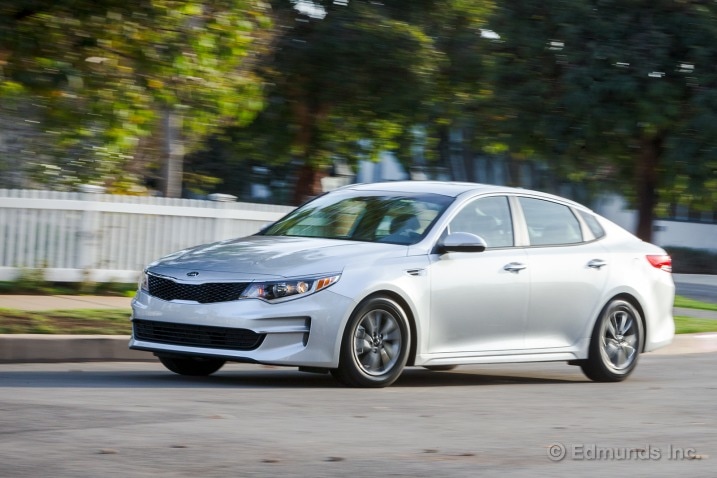
What do you want to know about?
- Introduction
- A Good Ride, So Far
- Plenty of Room in the Back Seat
- Performance Tested
- Press the Sport Button
- Impressive K900-esque Interior
- Deja Vu From the Driver Seat
- Fuel Economy Update For January — Just Getting Started
- Fuel Economy Update for February - Benefit of the Doubt
- No Insider Access
- Great Transmission for Multiple Reasons
- Blind Spot Monitor Optional
- LX Turbo Is the One to Get
- Small Engine, Big Performance
- Quiet and Mostly Comfortable on First Road Trip
- Overachiever - Nearly 600 Miles and 40 MPG on One Tank
- Storage Opportunities
- Earns Top Safety Pick+ Award
- In-Town Drivability
- Good Tech Usability
- My Preferred Audio Controls
- What Does the Warranty Include?
- Better Material Than Pricier Model
- Fuel Economy Update for April
- Seat Upholstery and Padding Coming Away
- Happiness is a Hands-Free Trunk
- 17 Being Recalled Due to Airbag Defect
- Apple CarPlay Coming Soon
- Trash Bags Come Standard
- Brakes May Be Overly Sensitive
- The Transmission Mode Sweet Spot
- Rear Cross-Traffic Alert Is a Worthwhile Feature To Get
- 5 Reasons To Buy an Optima
- What You Get With Kia UVO eServices
- Fuel Economy Update for May - Still On an Upswing
- Powertrain Nitpicks
- Using UVO Speed Alerts and Geofencing To Find Out How Your Teenagers Are Driving
- Overall MPG Continues To Increase
- Will the Luggage Fit?
- More Power than You'll Ever Need
- Easy to Lose in a Parking Lot
- Prepared to Hate It
- July Fuel Economy Update - One Month Forward, Two Steps Back
- Back That Thang Up
- Humbly Does Everything You Need It To
- We Forgot Something
- A Quick and Affordable First Service
- 10,000 Miles Under Its Belt
- August Fuel Economy Update
- Monthly Update for October 2016
- Monthly Update for November 2016
- Monthly Update for December 2016
- Hits the 20,000-Mile Mark and Gets Its Last Service
- Wrap-Up
Introduction
What Did We Get?
When the Kia Optima was redesigned in 2011 it was groundbreaking. It had a design so striking that it reinvented the brand overnight. Sedan shoppers who never thought twice about Kia suddenly considered the idea of putting an Optima in their driveway.
We drove one for a year and liked much of what it offered. It wasn't perfect, though, so it didn't knock the class leaders off their perch.
For 2016, the Kia Optima has been redesigned again. This time around, Kia knows it has a good-looking car on its hands, so it didn't change much on the outside. It even made a Super Bowl commercial mocking the blandness of its competitors.
Most of the changes were made to the underlying chassis, suspension tuning and interior. Kia also added an interesting new turbocharged engine option that delivers strong performance and even more miles per gallon than the base engine. It's once again an intriguing option that we wanted to know more about, so we decided to give it another try and add one to the fleet.
What Options Does It Have?
There are four trim levels of the new Optima: LX, EX, SX and SXL. The base LX starts at $22,840 and comes with the kind of stuff you would expect in a new, midsize family sedan. It has a standard power-adjustable driver seat, a rear back-up camera, Bluetooth connectivity, satellite radio and a USB port. It's powered by a 2.4-liter, four-cylinder engine mated to a six-speed automatic transmission.
We wanted to try out the new 1.6-liter turbocharged engine, so we opted for the Optima LX 1.6T, which starts at $24,840. It has less horsepower than the base engine, but more torque. It also uses a seven-speed dual-clutch automatic transmission in place of the standard six-speed.
All LX 1.6T models are upgraded with a leather-wrapped steering wheel, keyless ignition and heated side mirrors. Our car is also equipped with the optional LX Technology package, which adds a navigation system, blind-spot detection, rear cross-traffic alert, parking assist sensors and LED taillights. Dual-zone climate control, driver seat memory settings and extra USB ports are also part of the deal. It adds $2,600 to the bottom line along with $130 for floor mats. Altogether, our Optima carries a sticker of $27,545.
Why We Got It
The last Optima came out of nowhere and put Kia on the family sedan map. It reminded shoppers that a practical family car didn't have to look boring. A few competitors even took note and upped their game in the styling department to keep up.
Now that the sheen has worn off, it's time to see if the Optima's second act elevates it to a top-tier midsize family sedan on par with the Honda Accord and Toyota Camry. This Optima has to do more than just look good; it has to feel good in every respect. That means a more refined ride, higher-quality interior materials and improved ergonomics all around. A year in our fleet will give it plenty of time to show why it deserves a spot alongside the industry's best family sedans, or it might show why it's still a step behind.
Read along on our long-term road test blog to see daily updates on its progress.
The manufacturer provided this vehicle for the purpose of evaluation.
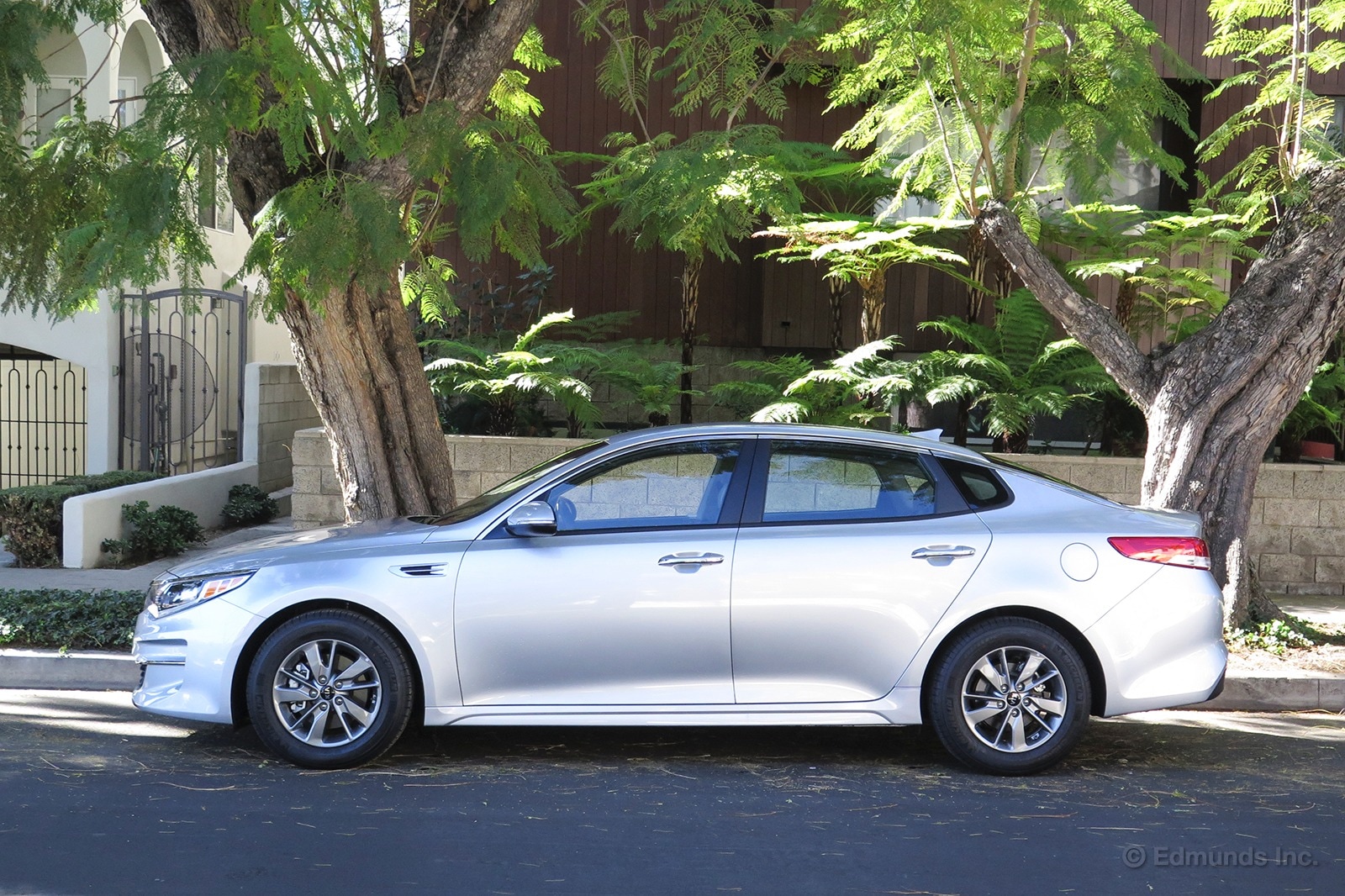
It's quiet, smooth and glides over bumps. That's my subjective review of our long-term 2016 Kia Optima's suspension so far.
After a few days around the city in the Optima, I'm really pleased with how comfortable it is. Our long-term Kia K900 had some issues once it had a full load of passengers, so I'm hoping the Optima doesn't fall victim to the same pitalls. For the time being, it seems really comfortable.
The many potholes I encounter on my daily commute usually cause a lot of bouncing, almost regardless of the car. But this Optima seems pretty impervious. Small wheels and generous tire sidewall probably deserve part of the credit, and for now things are looking good. The next test will be how well it does on the freeway with a full load of passengers.
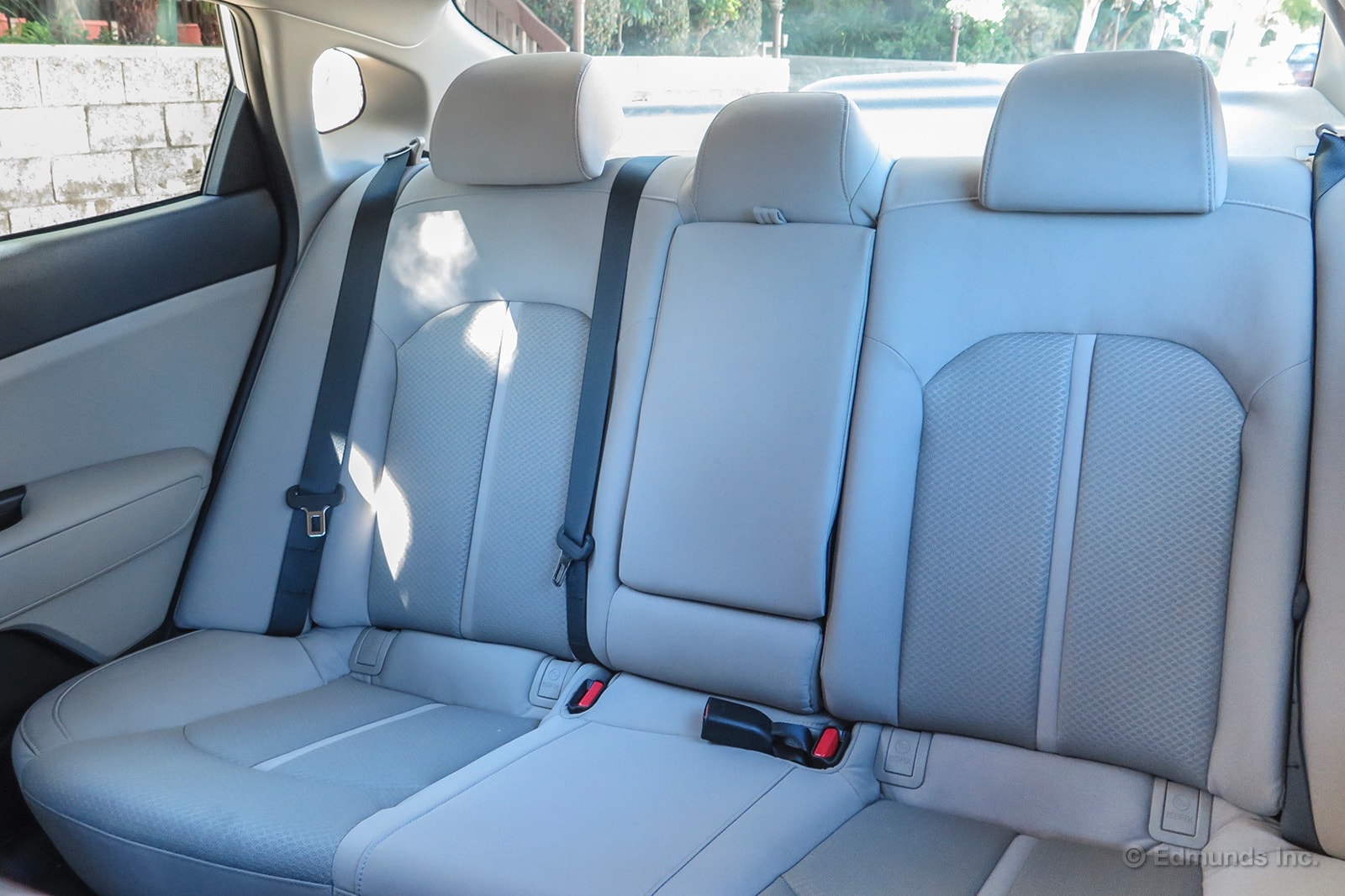
When new long-term vehicles arrive in our fleet, I have a little routine that I go through with them. I pop the hood, check out all the storage and cubby holes, and if there's a back seat, I sit in it. I'm only 5-foot-9, so I adjust to my comfortable seating position from the driver's seat, then add a few inches to simulate someone at least six-feet tall driving the car.
Then like my father taught me in all the test-drives he did during my childhood, I sit in the back seat, ostensibly behind myself. He's six feet tall, so he called it the "six and six” test to illustrate how comfortably two six-foot tall passengers could fit in the car. I recently performed the "six and six" in our new long-term 2016 Kia Optima and although I didn't have two test subjects on hand, there was a lot of room to spare.
Both the outboard and middle rear seats are comfortable and well-supported, just like the front. There's plenty of headroom and legroom and I'm eager to see how the Optima performs on a long road trip with a few adults in the rear. Standing still, this thing looks good and feels good, giving me plenty of hope.
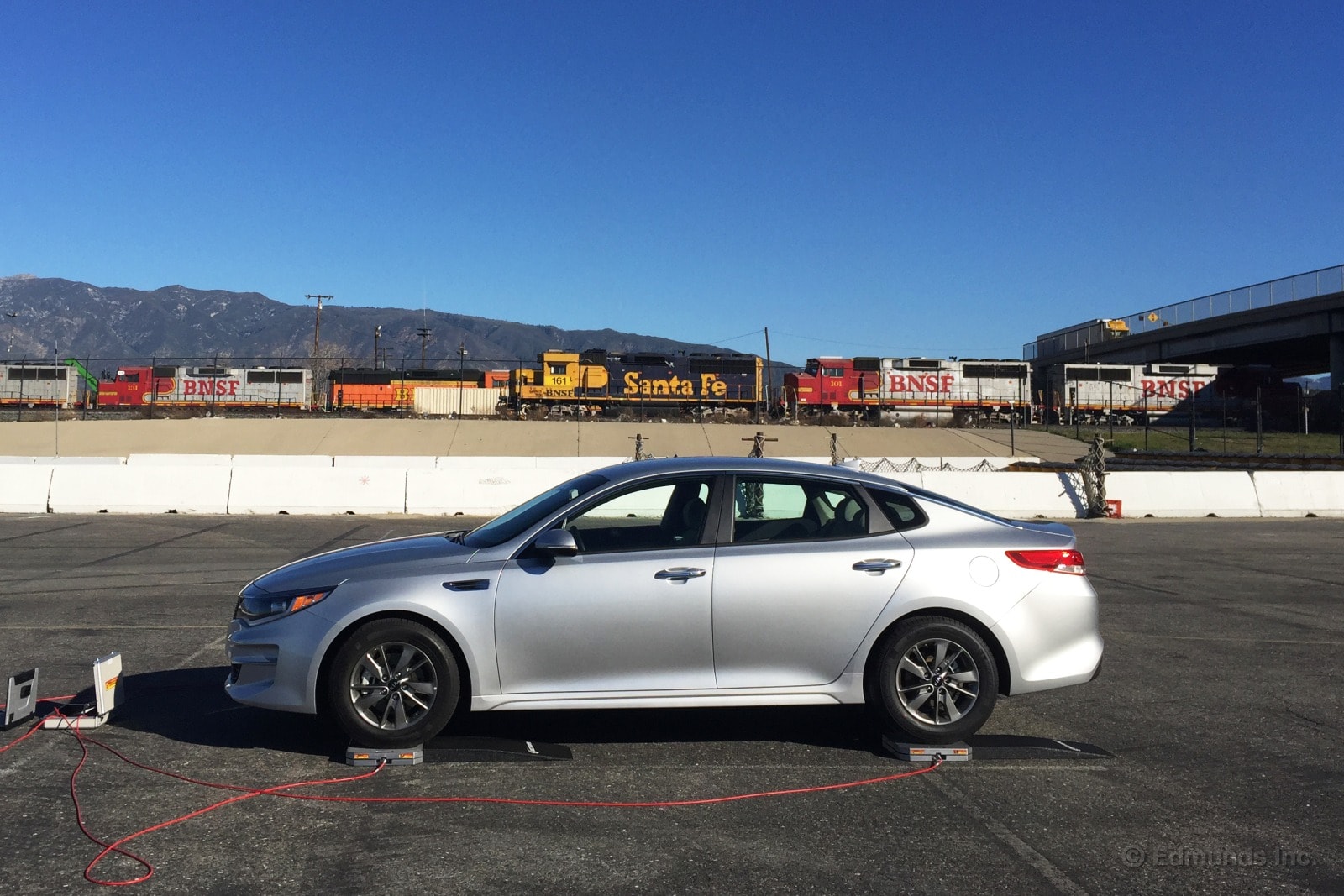
Now that our long-term 2016 Kia Optima is broken in, it was time to take it to the track. We specifically ordered this model with the turbocharged 1.6-liter four-cylinder and new seven-speed dual clutch and were eager to see how the combo performed.
Despite this being an eco-minded model, we hoped that this setup would prove both exciting and economical. Read on to see how it fared at its limits.
Vehicle: 2016 Kia Optima LX Turbo
Odometer: 1,364
Date: 2/9/2016
Driver: Carlos Lago
Price: $27,545
Specifications:
Drive Type: Front-wheel drive
Transmission Type: Seven-speed dual-clutch
Engine Type: Turbocharged inline-four cylinder
Displacement (cc/cu-in): 1,591/97
Redline (rpm): Indicated at 6,600 (shifts at 6,000)
Horsepower (hp @ rpm): 178 @ 5,500
Torque (lb-ft @ rpm): 195 @
Brake Type (front): One-piece ventilated discs with two-piston sliding calipers
Brake Type (rear): One-piece solid discs with single-piston sliding calipers
Suspension Type (front): Independent, MacPherson strut, coil springs, anti-roll bar
Suspension Type (rear): Independent, multi-link, coil springs, anti-roll bar
Tire Size (front): 205/65R16
Tire Size (rear): 205/65R16
Tire Brand: Michelin
Tire Model: Energy Saver A/S
Tire Type: Low-rolling resistance
As tested Curb Weight (lb): 3,248
Test Results
Acceleration:
0-30 (sec): 3.2 (w/ TC on 3.4)
0-45 (sec): 5.0 (w/ TC on 5.3)
0-60 (sec): 7.7 (w/TC on 8.2)
0-60 with 1-ft Rollout (sec): 7.4 (w/TC on 7.8)
0-75 (sec): 11.5 (w/TC on 12.1)
1/4-Mile (sec @ mph): 15.72 @ 89.1 (w/TC on 16.09 @ 87.4)
Braking:
30-0 (ft): 31
60-0 (ft): 124
Handling:
Skid Pad Lateral acceleration (g): 0.77 (0.76 w/ESC on)
RPM @ 70: 2,000
Comments
Acceleration: We're surprised by the lack of refinement from this dual-clutch transmission. During part- and full-throttle applications, this transmission exhibits a significant delay during upshifts. As the Optima prepares for a shift, you can feel it slowly roll off the power. After making the shift, it slowly re-engages the throttle. This delay is visible in the data and occurs on each upshift, stacking time against acceleration. It also makes the engine's power deliver feel needlessly non-linear. The engine gets loud around 4,500 rpm under full load, but doesn't sound very good. Never mind the 6,600 rpm indicated redline — the transmission automatically upshifts at 6,000 rpm regardless of drive or shift mode.
The Optima seems hesitant to accept application of both brake and gas pedals (pedal overlap). Doing so brings up engine speed so you can accelerate with the engine producing more power, but revs rise slowly and don't go past 1,500 rpm. Sport drive mode and manual shift mode didn't make an appreciable difference to shift quality or speed, but showed acceleration improvement. We achieved fastest acceleration in these settings by holding both gas and brake pedals until the tach reached around 1,500 rpm.
Braking: Stops feel longer than the recorded distances show due to lots of ABS feedback. You feel shuddering through the brake pedal and feel and hear similar vibrations from the tires and the chassis. No steering corrections are needed, but these sensations might make for a bit more excitement than you'd want during an emergency stop. Over five stops, distances stabilized around 126 feet, longer than average for the segment. Braking performance didn't degrade afterwards and the braking system did not produce odor or fade, and pedal feel remained consistent throughout testing.
Handling
Skidpad: The effects of stability control are difficult to notice on the skidpad. Turning it off seemed to allow for a little more steering input and control, but the 0.01-g average difference between turning the system off and on means this may be a placebo effect. The Optima is easy to hold on a line, exhibiting low handling limits and a moderate amount of body roll. The seats don't have a lot of lateral support, even for a mid-size sedan, so you may have to brace yourself. You have some freedom to adjust the car's attitude in a corner by applying and releasing the gas pedal, but you're working primarily with understeer and low limits — Carlos Lago
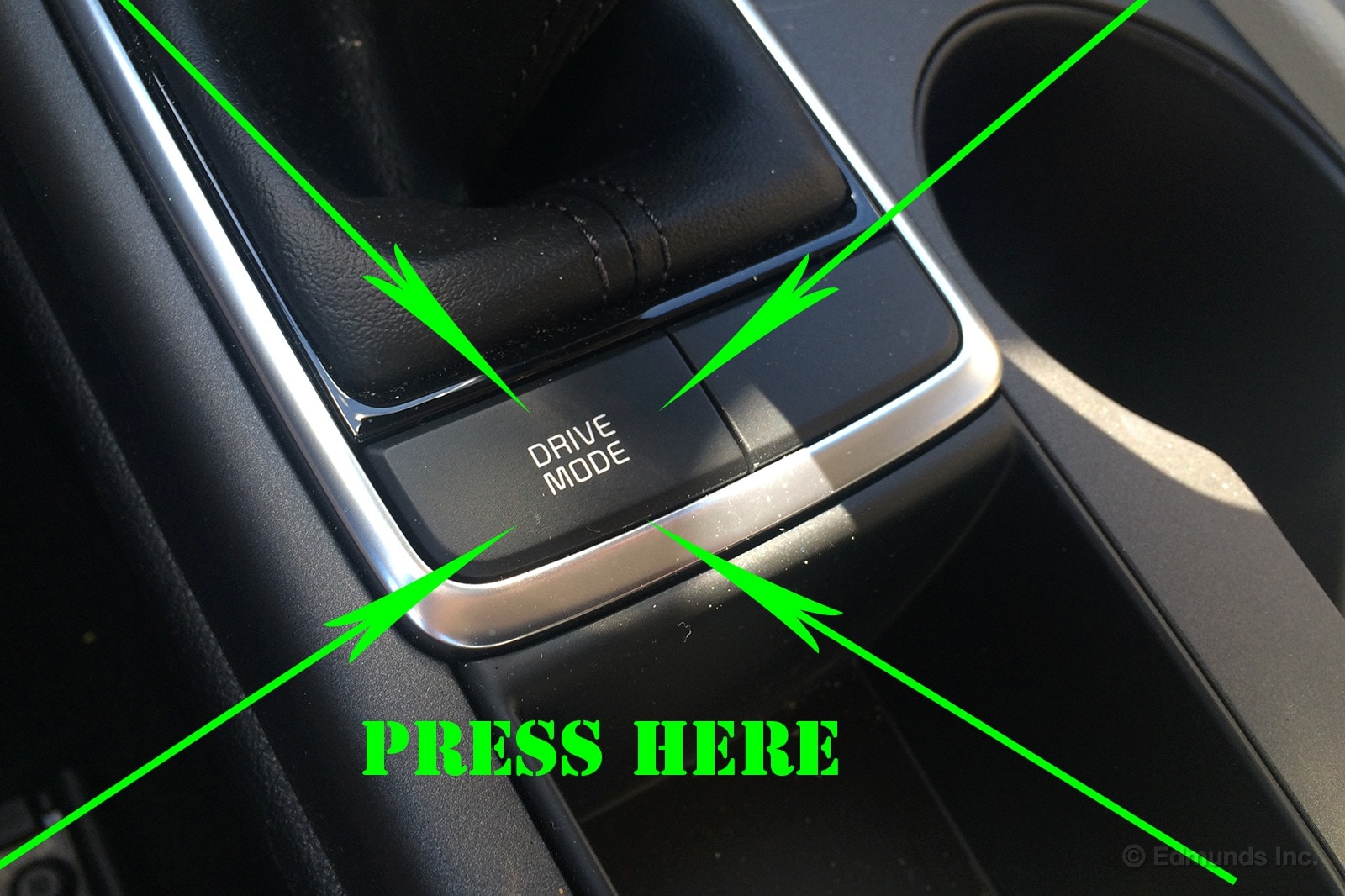
Starting the 2016 Kia Optima is effectively a two-step process.
Step 1: Press Start button. Step 2: Press Drive Mode button until the word "Sport" glows yellow in the gauges.
Doing so will result in the car, and specifically the throttle and transmission, behaving like a car should. When you press the throttle, the engine responds and moves the car forward with an immediacy determined by your right foot. The transmission stays in an appropriate gear for the speed in which you're travelling.
As a bonus, the steering firms up to the point where moving it actually provides some semblance of feel for what the wheels are doing. Some semblance. Not a lot.
This is to say that I find the Optima's Normal driving mode to be quite intolerable. And the fact that the Optima defaults to Normal every time you get back into the car does not help the situation. In Normal, should you need a quick burst of acceleration — say to pull out into a faster moving lane or quickly turn left into on-coming traffic — you will most likely be met with the following response: nothing.
Or more accurately, put your foot to the floor in Normal and the engine will begin to rev with the immediacy of an octogenarian in 5-inch Louboutins. Hours later, when it eventually gets to around 3,500, boost does kick in but by that time you've either missed your opportunity, been plowed by faster-moving traffic or caused the on-coming traffic to try out their brakes and horn. Fun times.
In an effort to be constructive, I therefore propose that "Sport" be renamed "Normal" and "Normal" be renamed "Grandma." There's also an Eco mode, which I assume just slams the car in Park should you choose to accelerate. I definitely would not press that.

It may not be covered in leather and wood, but the interior of our long-term 2016 Kia Optima feels almost as nice as our recently-departed long-term Kia K900 and that's saying a lot. Here's a picture of the K900's interior for comparison.
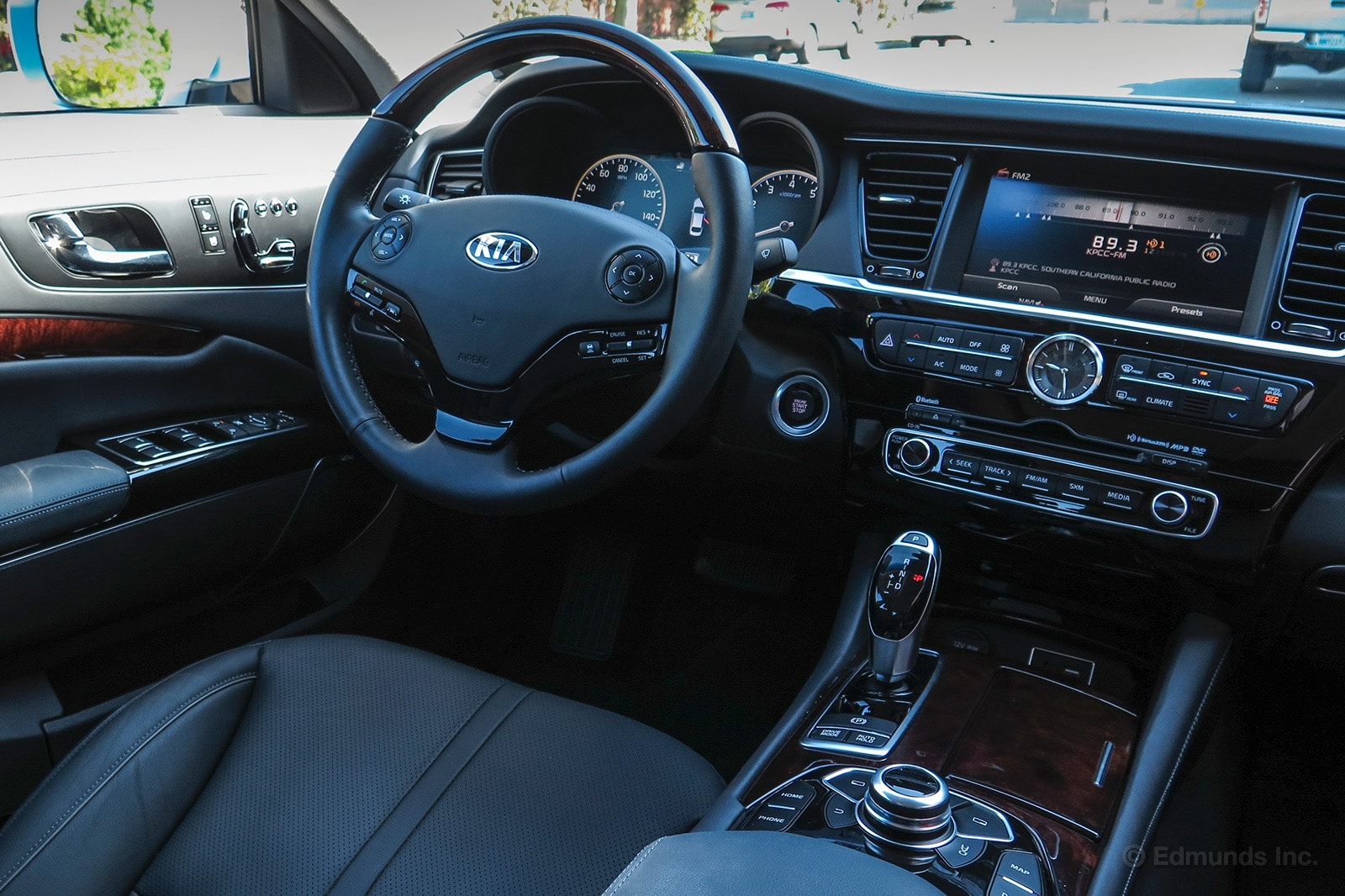
The hearty steering wheel, the logical button layout, and the general user-friendly nature of the cabin have all made their way down the ladder to the Optima. The materials in the Optima aren't quite as swanky as they were in our $66,000 K900, but they're definitely nice enough for the class and especially for the price.

I spent a lot of time in the driver seat of our former long-term 2015 Hyundai Sonata. Its roomy back seat, agreeable ride and quality interior made it an easy car to keep for the weekend. Another of its highlights was the design of its clean center stack, which I always found extremely easy to use.
I'm happy to see that the multi-tiered center stack has been incorporated into the 2016 Kia Optima as well.

Since the Hyundai-Kia siblings share a common platform and fill the midsize car slot for their respective marques, perhaps it's not surprising that the Sonata and Optima have a similar design for the infotainment and climate control systems. But the similarities don't stop at the center stack. The instrument panels of the two cars are largely the same, with toggle switches for optional safety features located to the left of the steering wheel. They each have a dashboard that is black on top and beige on the bottom.
There are minor design differences, like placement of the air vents, the dashboard shape and the plastic cover below the Sonata's climate controls that hides the small item cubby. There are also trim level differences, such as the Optima's cloth upholstery versus the Sonata's leather seating with cloth inserts.
While the Optima's interior is mostly a repeat of the Sonata's, that's not a bad thing. That's especially true when you consider that we liked the Sonata's interior so much that last year we gave it an "A" rating on all three versions that we tested. Although the Optima's cabin isn't groundbreaking, we know from experience the controls are thoughtfully laid out and the infotainment system is easy to use with a logical menu layout. If our staff's impressions of the Sonata's interior are any indication, you'll likely see few gripes about the Optima's.
Fuel Economy Update For January — Just Getting Started
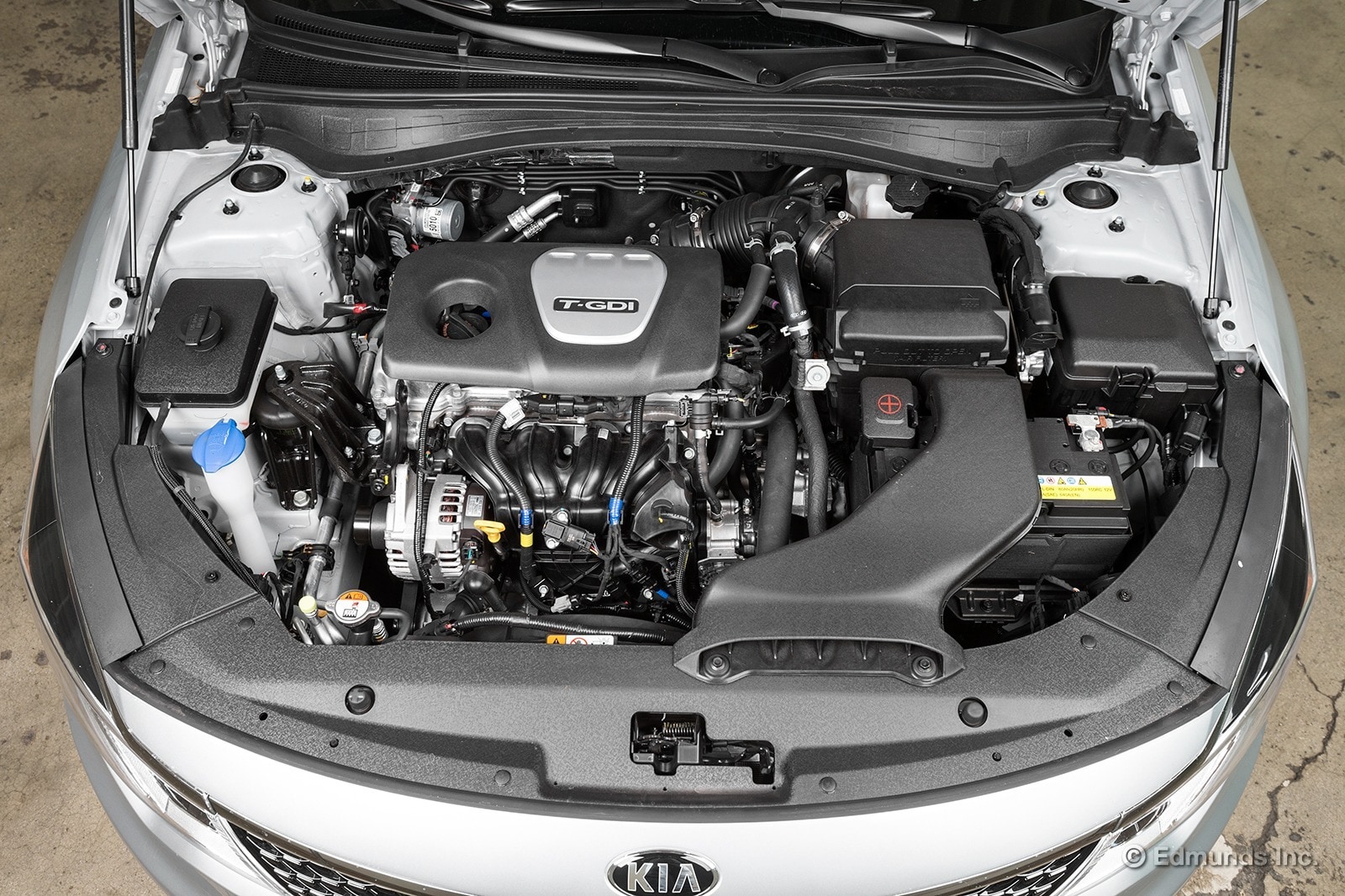
Our long-term 2016 Kia Optima is just getting started with its time in our care. So far we've noticed some powertrain idiosyncrasies, praised its backseat and run it through our testing regimen.
Likewise, the Optima's fuel economy tally for January got a late start. It consists of only two fills, whereupon the silver sedan covered 617 miles and used just under 24 gallons of fuel.
Considering that its EPA combined rating is 32 mpg, is our 26.1 mpg January result a harbinger of things to come? We shall see. It's way too soon to start drawing conclusions.
Worst Fill MPG: 23.0
Best Fill MPG: 28.5
Average Lifetime MPG: 26.1
EPA MPG Rating: 32 Combined (28 City/ 39 Highway)
Best Range: 380.5 miles
Current Odometer: 1,895 miles
Note: Cars are sometimes refueled well before their fuel tanks approach empty. As such, "best" and "worst" fuel economy entries above are not necessarily the result of an entire tank's worth of driving.
Fuel Economy Update for February - Benefit of the Doubt
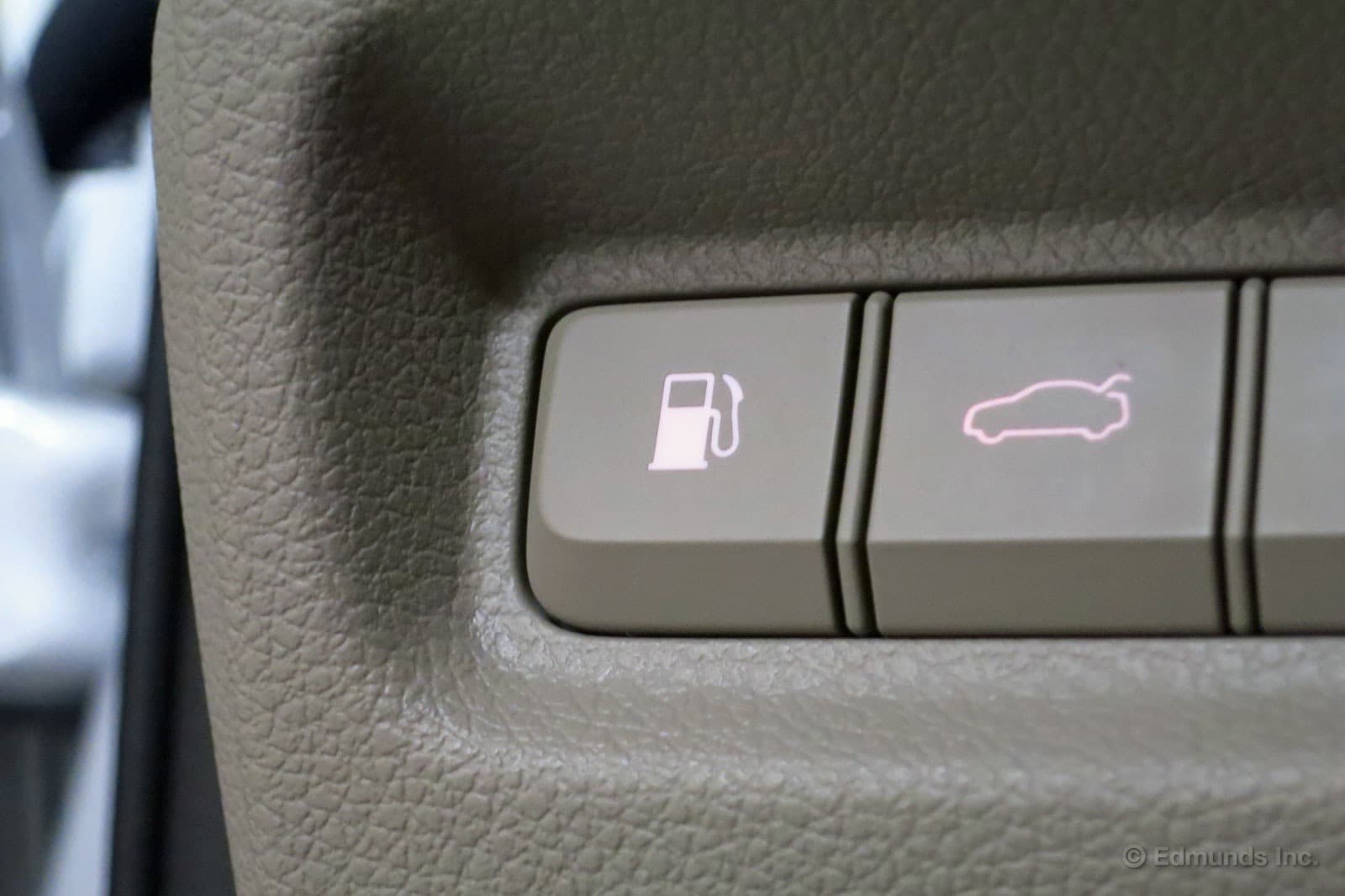
Our 2016 Kia Optima is barely broken in, so we'll give it the benefit of the doubt for now. We say this because it's still returning mileage numbers well below its EPA ratings.
With barely 2,000 miles on the odometer, our turbocharged Kia is returning just 25.2 miles per gallon. Considering its EPA city rating is 28 mpg, that's not great.
It's hard to tell if this is an anomaly so early in our test. Most of our long-term cars deliver significantly improved mileage numbers once they start building up more miles. We'll keep a close eye on this one to see if the trend moves in a positive direction.
In the meantime, several editors have commented on the interior of the Optima. Whether it's the richness of the materials or the well laid-out controls, the overall feeling is positive.
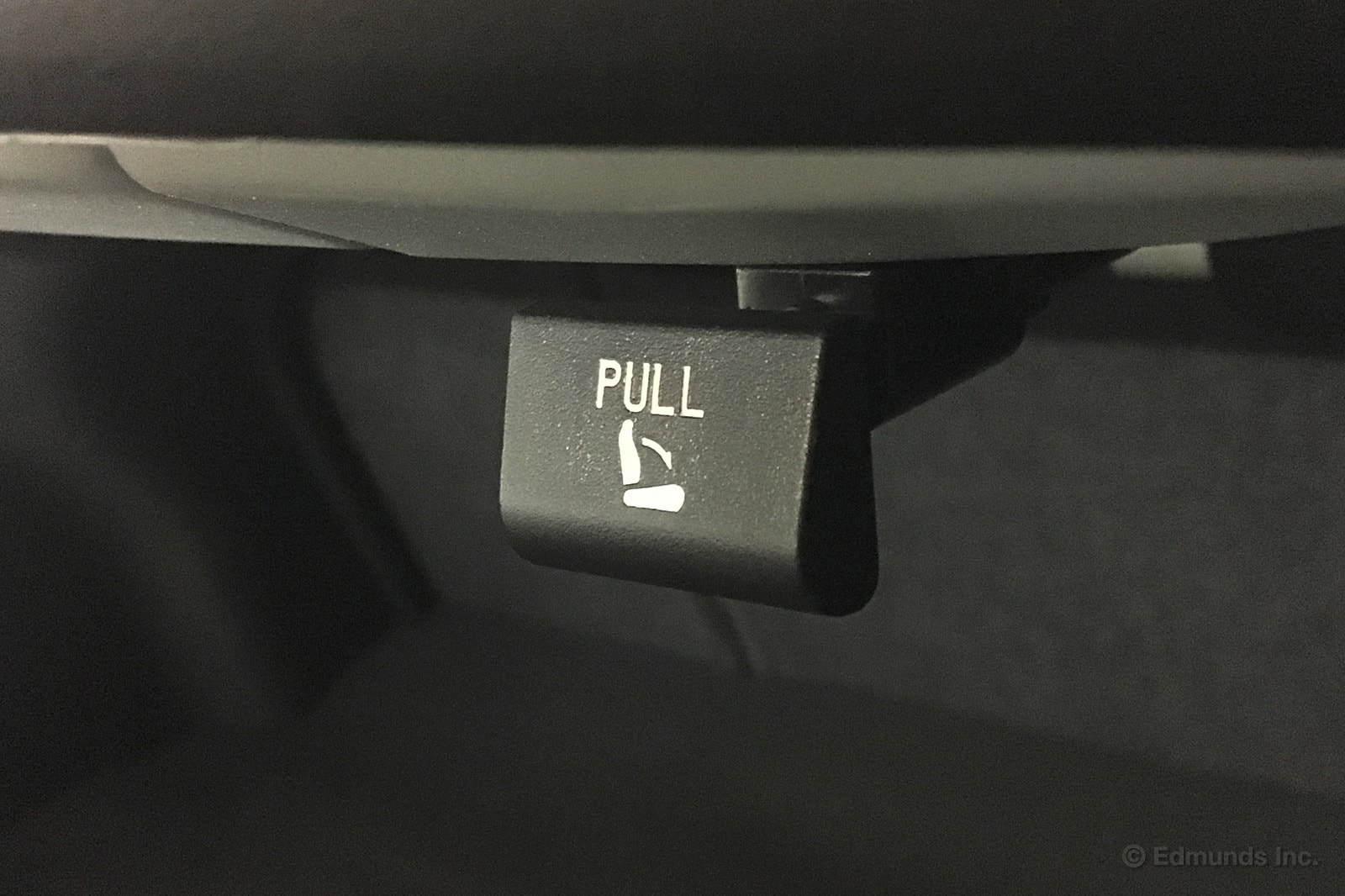
Our long-term 2016 Kia Optima has a good-sized 15.8-cu-ft trunk that further benefits from a low and wide opening. Those rear seatback releases in the trunk are an added bonus, which means if you need to transport longer items, you won't need to climb into the rear seats to unlatch them.
A lot of manufacturers are doing this now and it's a good thing. But...
There is no latch inside the passenger compartment to fold the rear seats. Maybe I have an unusual parking situation that makes this a bigger problem than it is, but hear me out. In my carport, I back into a spot as close as I can to the wall on the passenger side. So close, in fact, that those doors won't open and the trunk can't be accessed, either.
I usually put cargo in the rear seats or footwells to get around this, but some things need to be transported in the trunk. I'd normally wrestle those things through the passageway behind the seatbacks, but the lack of interior releases won't let me. Instead, I stop about halfway into the parking spot, pop the trunk and either unlatch the seatbacks or unload the trunk next to the car.
Note to manufacturers: we like the trunk releases, but please keep the latches on the inside, too. Ok, thanks, bye.
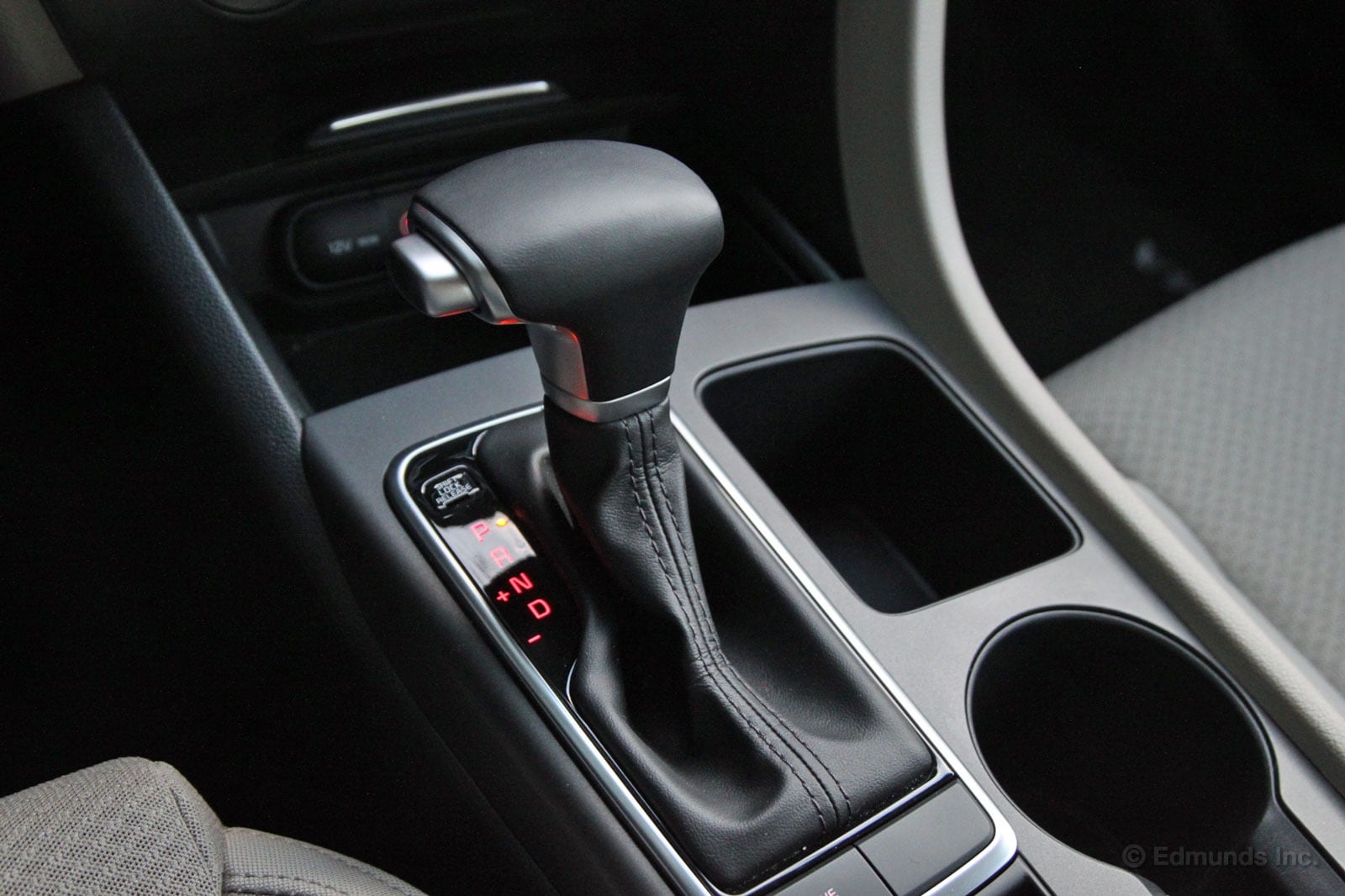
Our 2016 Kia Optima gets many of the basics right. One example is the transmission. It not only moves through the gears smartly, the shifter itself feels good to the touch.
How a transmission shifter feels might sound inconsequential, yet it goes a long way toward reinforcing a feeling of quality. Like the door handles and the steering wheel, you touch the shifter every time you get in the car, so the way it feels matters.
This shifter not only has a nicely designed handle that fits well in your hand, it moves solidly from one notch to the next. There's no play in the handle from side to side and it's easy to find each gear. I can't tell how many transmission shifters I've used that felt like you could rip them out of the console with one good yank. This one feels like you could break a two-by-four over it.
It also deserves credit for crisp shifts and quick responses. I usually drive it around in "Sport" mode as Riswick suggested and rarely does it disappoint. In fact, it's one of the best dual-clutch transmissions I've driven. Most drivers probably won't even notice that it's not a standard automatic. Hopefully it stays that way as the miles pile up.

Why would anyone want to turn off the blind spot monitor in our 2016 Kia Optima? Turns out there are a couple reasons, but most of them aren't very good.
The biggest compliant I hear? It's annoying. Having the car beep at you every time you hit the turn signal with a car nearby gets old to some people. "It's like the car is nagging you," I've heard.
It's actually a legitimate gripe since there are times when you have to hit your turn signal knowing there are cars in your blind spot. In typical L.A. traffic, it actually happens quite a bit. After about the third time of hearing the alert, you can't help but look for the button pictured above.
Then again, isn't it better to know of a potential issue and deal with the noise for a few brief moments? That's the side I fall on.
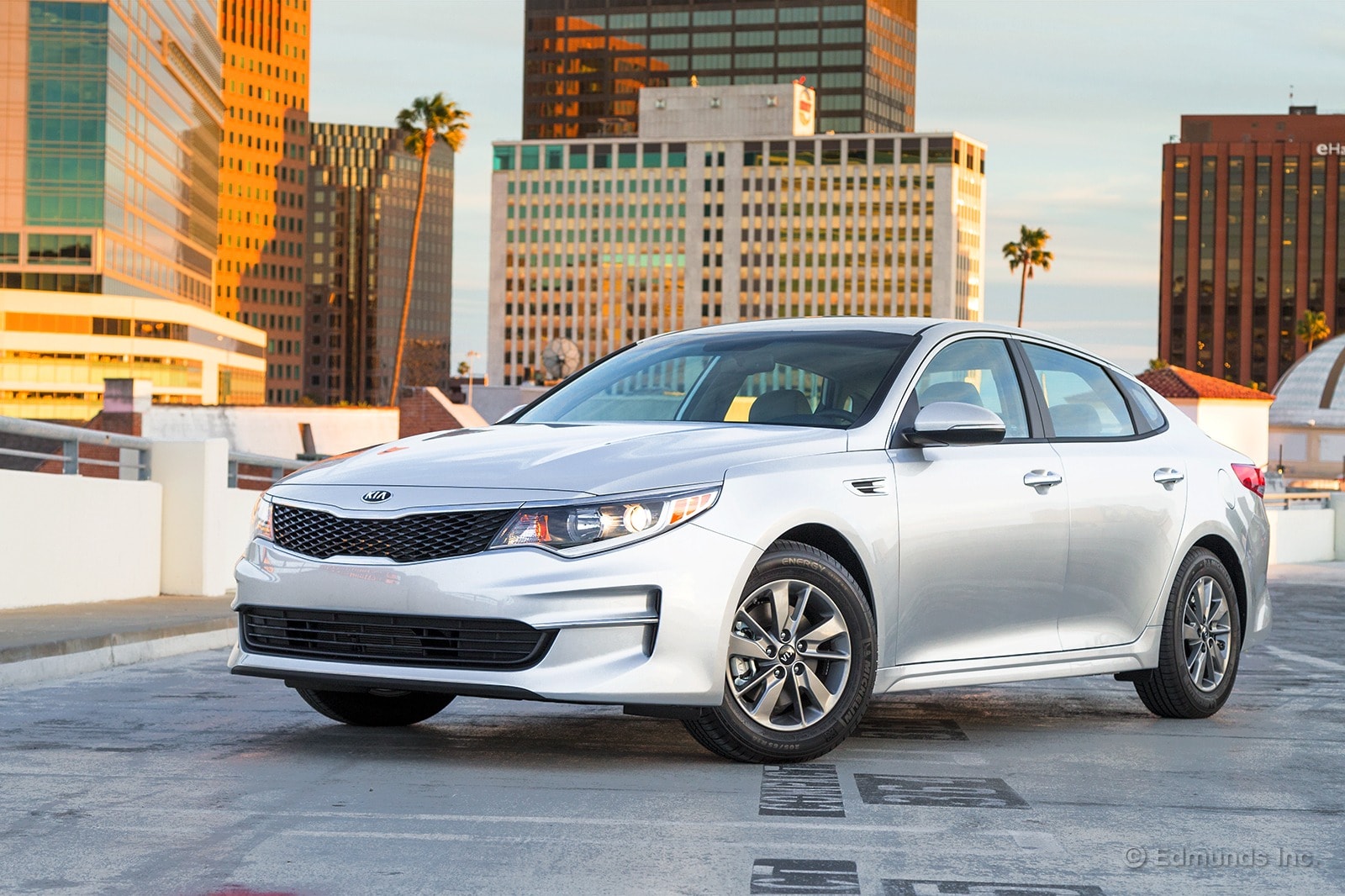
For the Edmunds.com long-term fleet, we usually end up testing fully-loaded vehicles so we can report how well, or poorly, most of the available features perform. The downside to this approach, however, is that we drive vehicles in trim levels that are on the narrow end of a sales bell curve.
Well, welcome to the thick part of the bell curve. Our 2016 Kia Optima is an LX Turbo. The LX is the Optima's entry-level trim, and getting the optional turbo 1.6-liter engine represents a half-step up from there. Our car also has just one option package, the Technology package. Final MSRP on our car is a budget-friendly $27,545.
Here are three reasons why the LX Turbo is a great way to go if you're shopping for an Optima.
1: You get a lot of desirable and useful features for your money. Starting out, the Optima LX gets you alloy wheels, a power driver seat, Bluetooth, a USB port and a six-speaker stereo. When you select the Turbo variant and the Technology package, you also get extras such as a power driver seat, keyless entry and ignition, blind-spot monitoring, rear cross-traffic alert, dual-zone automatic climate control and an 8-inch central touchscreen with Uvo and navigation.
While it'd be nice to have other Optima features like heated leather seats or a sunroof, you start moving up the trim level hierarchy to get them. I feel like this LX Turbo with Technology is a nice base set that will keep you happy for years and your monthly payments low.
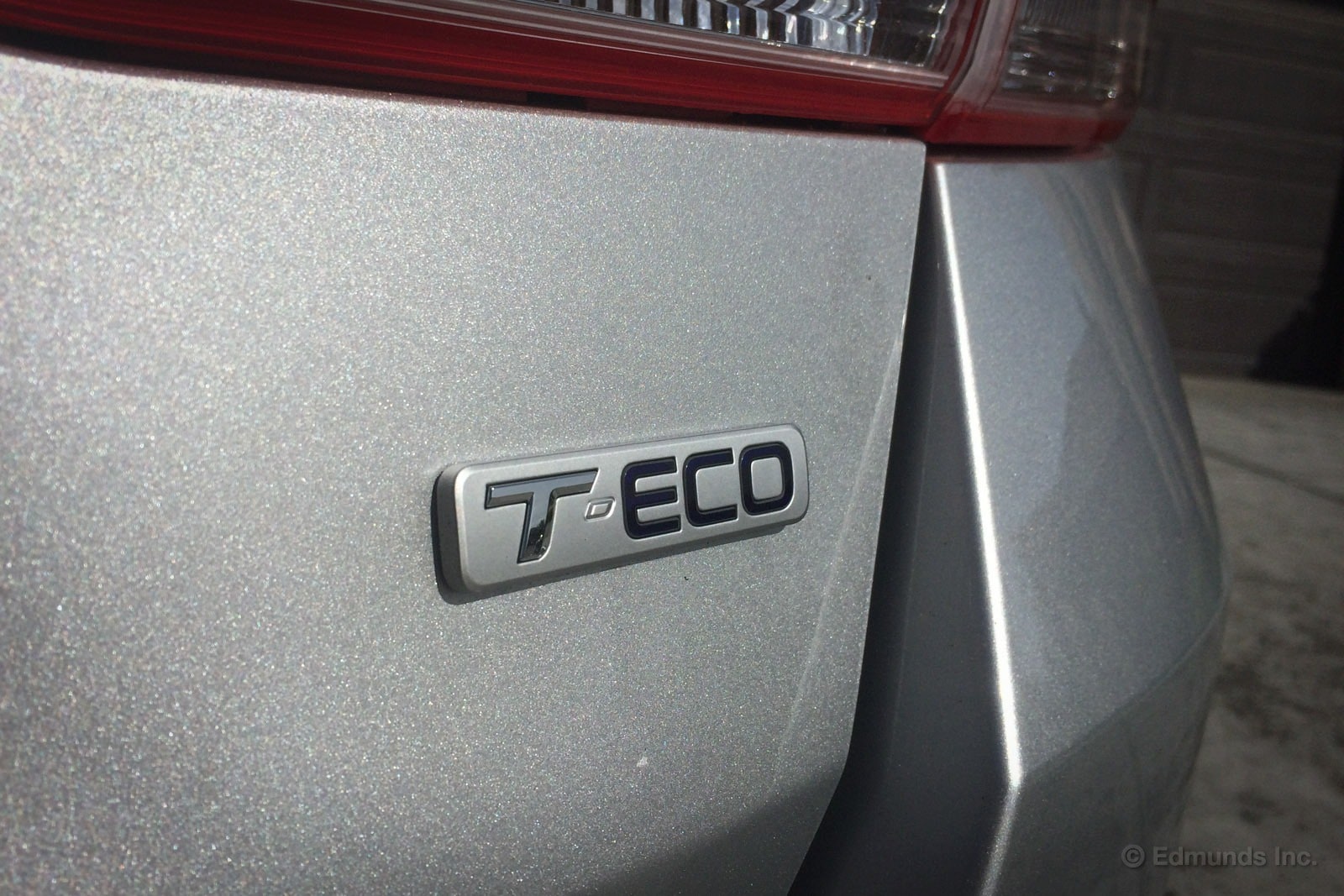
2: The turbo engine is a worthwhile upgrade over the base engine. A previous-generation Optima we tested with the regular LX 2.4-liter engine accelerated from zero to 60 mph in 8.9 seconds. Our 2016 Optima here did it in 7.7 seconds. That's a difference you can feel. Fuel economy should be better, too. I say should since we'll have to see whether the turbo's 4-mpg higher EPA estimate numbers pan out in our real world testing. So far, the results are a little discouraging. But I'm confident our Optima will start putting up some better mpg numbers than we have now.
3: Sixteen-inch wheels help out the ride quality. Automakers often fit big, flashy wheels on the top trim levels. Kia does it with the Optima, using 17s for the EX and 18s for the SX. The bigger wheels look nice and help sharpen handling a bit since the tire sidewall gets shorter. But less sidewall also means less ability to absorb road impacts or prevent wheel damage when hitting big potholes.
On a car like the Optima, I'm more concerned with having comfortable ride quality and that means the LX's 16-inch wheels are the best way to go. We've observed this already in our "Good Ride So Far" update. And really, I think our car looks fine with the 16s.
So I've made the case for the LX Turbo. What would you get? Have you bought a different Optima trim recently?

As you can see, the four-cylinder engine is our 2016 Kia Optima is on the small side. There's nearly a foot of empty space around it, which is unusual on a modern car.
It's visually deceptive, however, as it produces more than enough power to get this sizable sedan up to speed.
Measured by our resident experts at the test track, this Optima turned in a 0-to-60 mph time of 7.4 seconds. That's a solid number for a midsize family sedan, especially one with such a small engine.
It's useful power, too. You don't have to wait for it to wind up to get things moving. The quick-shifting transmission is a big help as it keeps it from bogging down at low engine speeds.
If there's a catch here, it's this engine's thirst. So far it hasn't come anywhere near its EPA estimates. We'll see if this trend continues as the miles pile up.
Quiet and Mostly Comfortable on First Road Trip
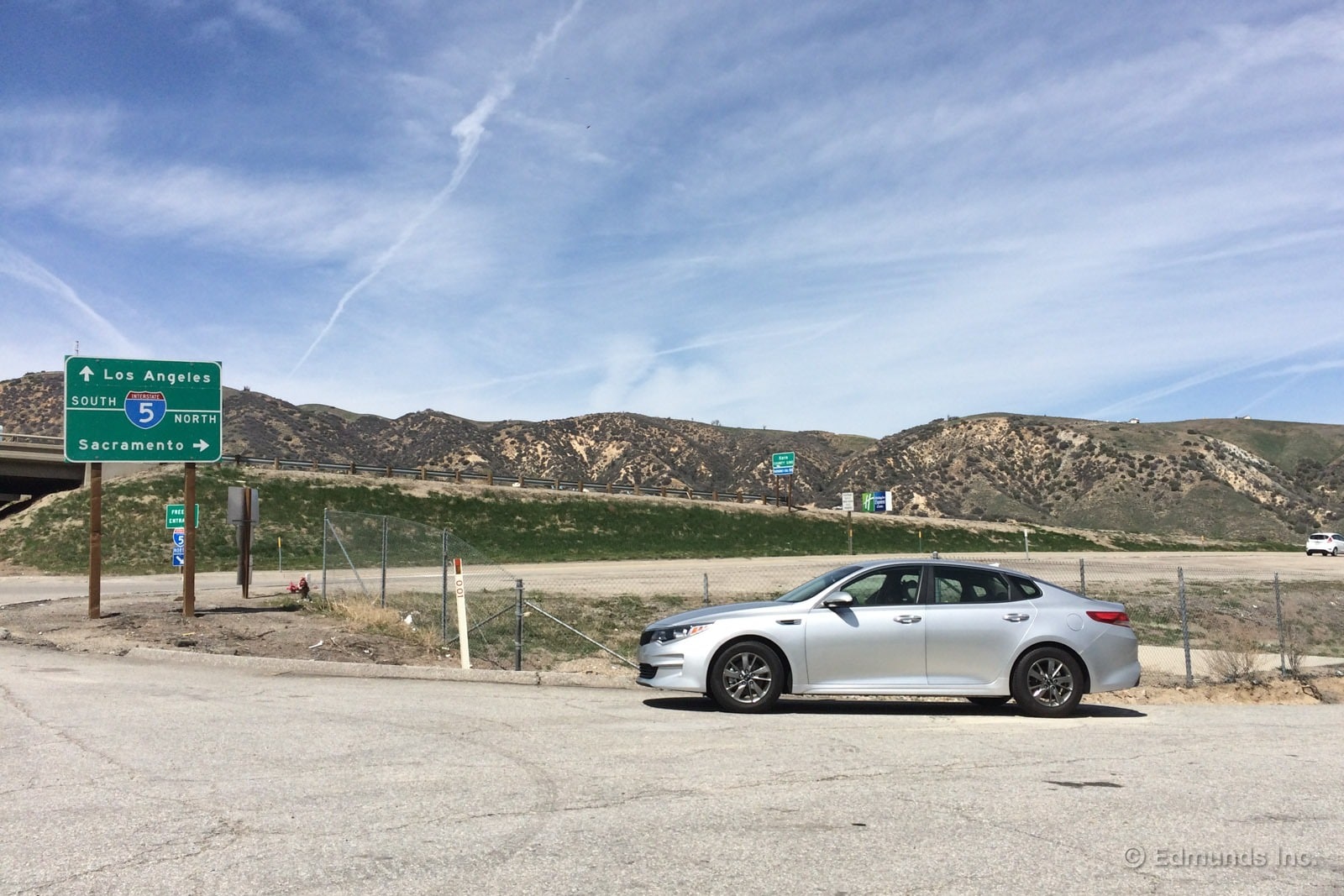
A couple of weeks ago, I was sifting through our list of long-term cars, hoping to schedule one of them for an upcoming 600-mile road trip with my family. The Honda Pilot and Kia Sedona were obvious choices, but were already booked. So was our new Honda Civic. The Chevrolet Volt was available but I was worried about it not having enough trunk space. Hmm. T
Then I noticed our 2016 Kia Optima was free and clear. Family sedan for a family road trip? Sold.
And as it turned out, I should have just considered our Optima to begin with. This sedan is well-suited for long hauls.
I have my wife and two kids (ages four and eight) along for this trip. It's just a four-day trip, so thankfully we didn't have a ton of stuff to pack up. A medium-sized suitcase, three small suitcases, and a smattering of other items fit easily in the 15.9 cubic foot trunk.
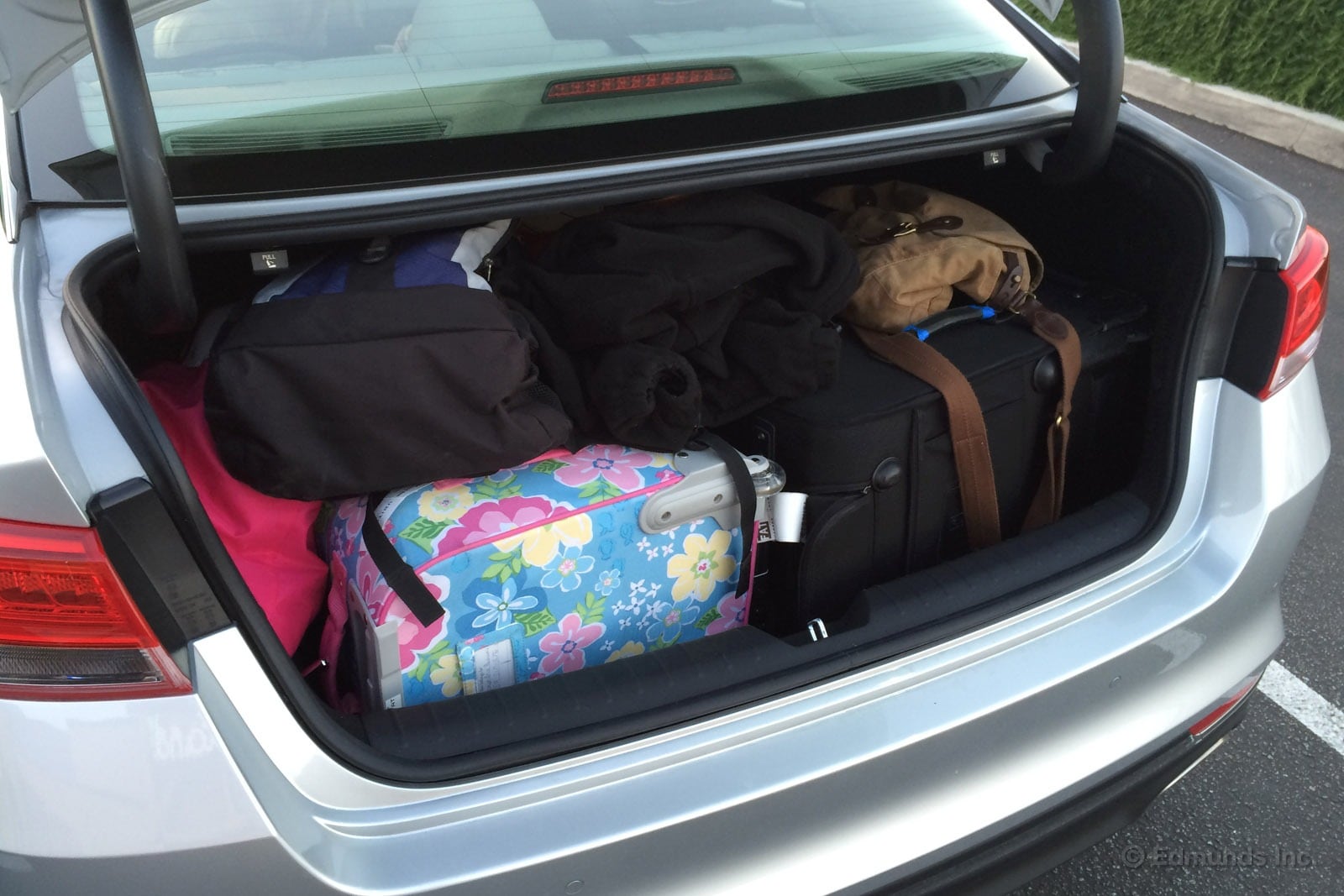
Once underway, the Optima's composed highway ride quality became apparent. Hyundai/Kia has struggled to fully master suspension tuning at times (our Santa Fe and K900 are recent long-term fleet examples), but our Optima seems pretty dialed in to me. It readily absorbs rough pavement and stays composed after you drive over big bumps or highway dips.
It's quiet, too. At highway speeds, there's no perceptible engine noise and not much wind noise. Kia's press kit for the 2016 Optima notes the effort made to make the car quieter, including larger underbody paneling, additional insulation and molding, new bushings and laminated front door windows. Well Kia, it would seem that your engineer's efforts have paid off.
Less appealing, though, is front seat comfort. The seats are OK, and our car has the optional eight-way power driver seat with four-way power lumbar, so that's promising for getting your ideal driving position. But the seat's cushioning ended up feeling overly hard and flat to me after multiple hours of driving. My wife also complained about the head-restraint sticking too far forward.

So, there's that. But overall I'm enjoying our Optima and my kids seem happy enough with the available leg and shoulder room in back. I'm midway through my road trip right now and plan to write a follow-up update on engine performance and fuel economy in the next day or two.
Overachiever - Nearly 600 Miles and 40 MPG on One Tank
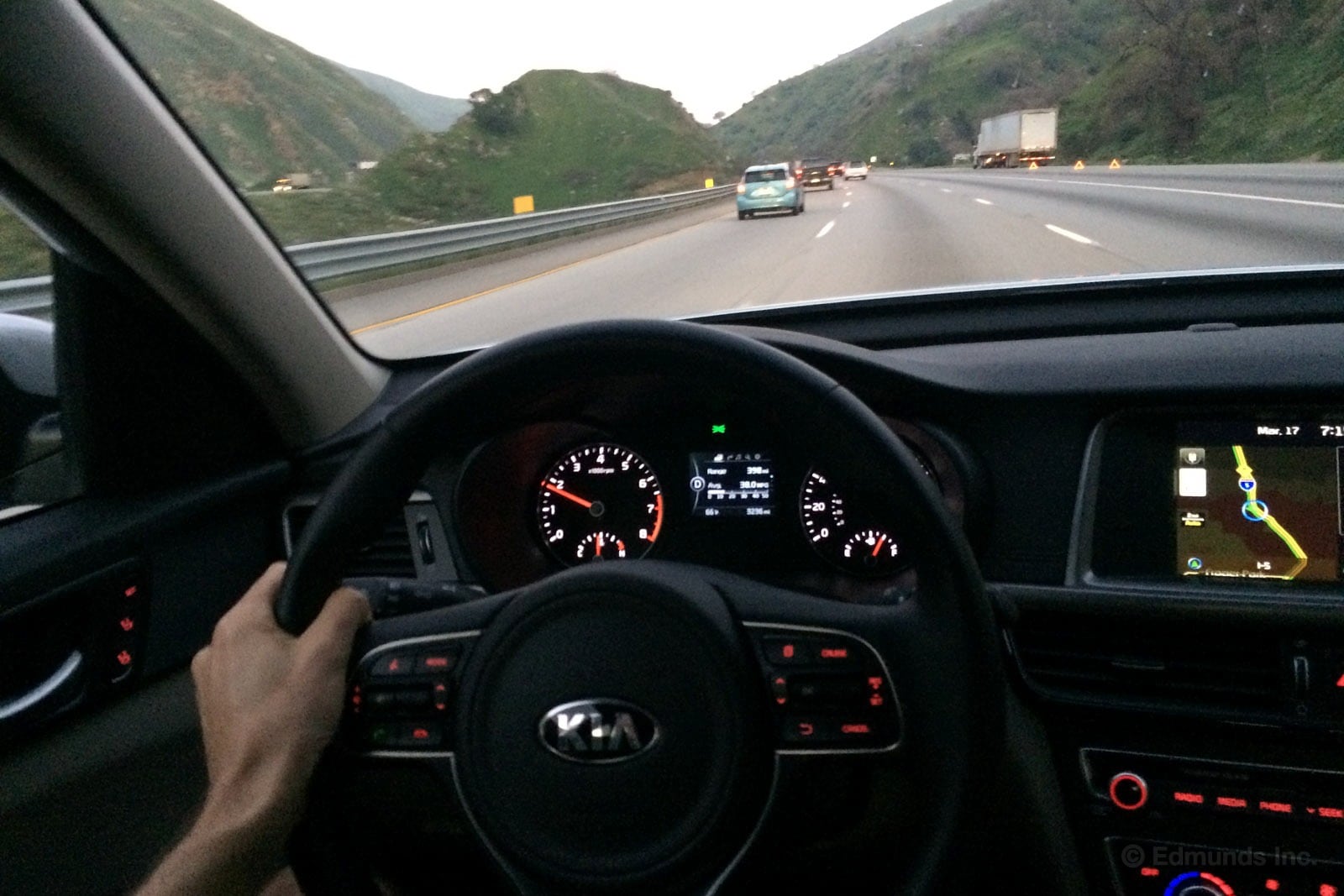
To date, we haven't had much good to write about our 2016 Kia Optima's fuel economy. In our most recent MPG update, we noted that our car's lifetime average was just 25 mpg.
Well, consider this update a counter to that. I just finished up a road trip where I drove 574 miles on one tank of gas. And for the trip, our Optima posted up an impressive 39.9 mpg.
The EPA estimates the Optima 1.6-liter turbo four-cylinder's highway fuel economy at 39 mpg.
Also interesting: I wasn't trying or even expecting to get 40 mpg. This was a family road trip with my wife, two kids and associated gear. I was driving on California highways at the typical 70 mph-plus speeds with the air-conditioning on most of time. Some city driving was also mixed in here.
Based on other long-term cars I've driven over the years in similar situations, I would have expected something between EPA combined (32 mpg) and highway. Heck, when I drove our long-term Nissan Rogue on an 800-mile road trip a year and a half ago, it returned just 1 mpg better than its EPA city estimate.

During the trip, our Optima's in-car fuel gauge was consistently showing a low 40 mpg average. When I pulled into a gas station to fill up after 574.7 miles, it was at 40.0 mpg. (Also note the car's remaining range of 43 miles. Conceivably, you could push past 600 miles in the Optima.) These in-car gauges are usually optimistic, but in this case it was very close; I pumped in 14.405 gallons (the actual calculation here is 39.895, but I rounded up to 39.9).
It's not clear whether this trip was an anomaly or if our previous reported fuel economy has been abnormally low. Maybe it's both. I suspect our Optima's fuel economy is more susceptible to driving style (e.g., the Sport button) when driven around town and commuting than it is when you're just cruising on the highway.
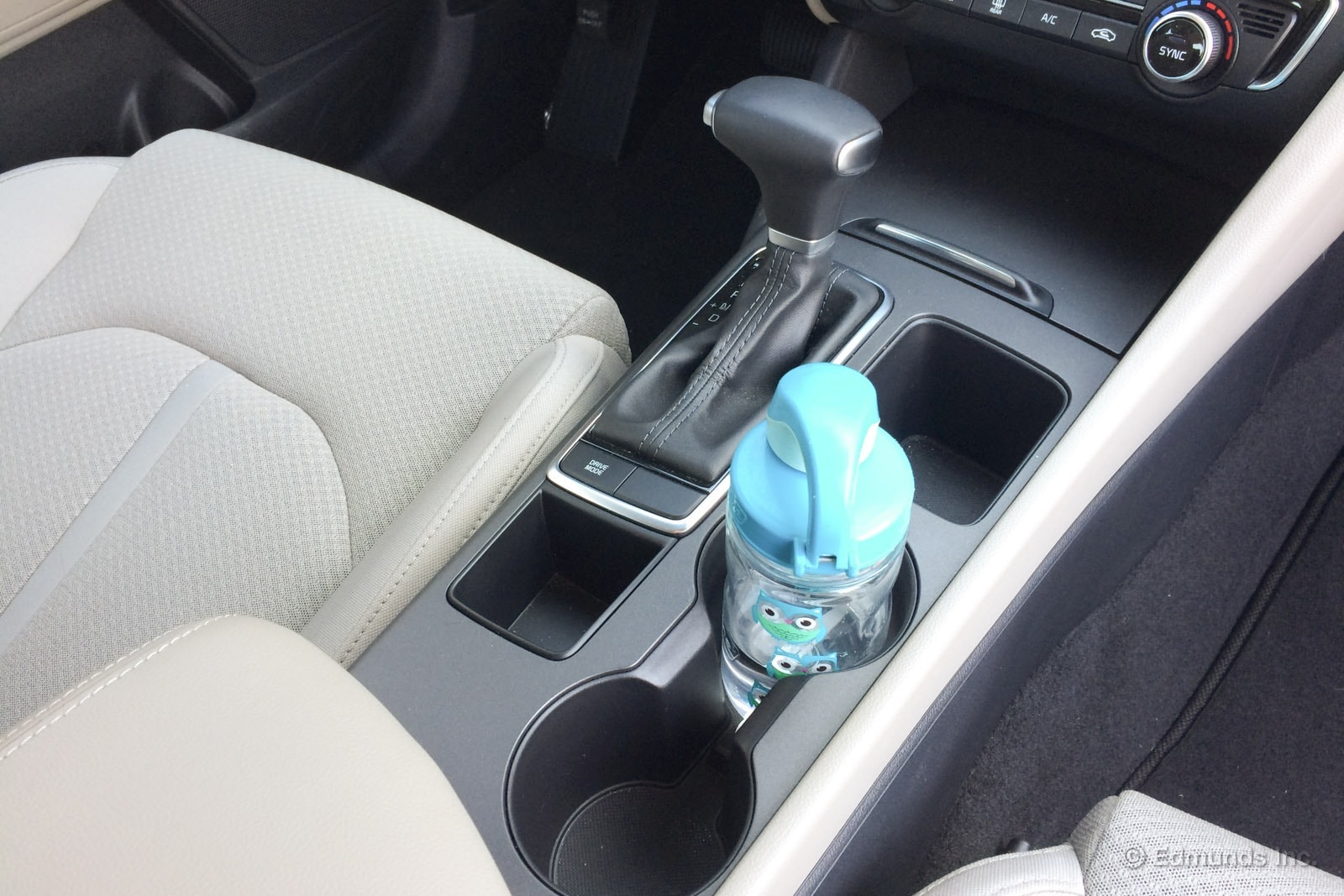
I like the available interior storage in our 2016 Kia Optima. There are a couple cupholders and a few bins to work with. The setup isn't flashy, but I've found it to be pretty handy for my personal effects.
Click through to see some in-use action photos from around the interior.
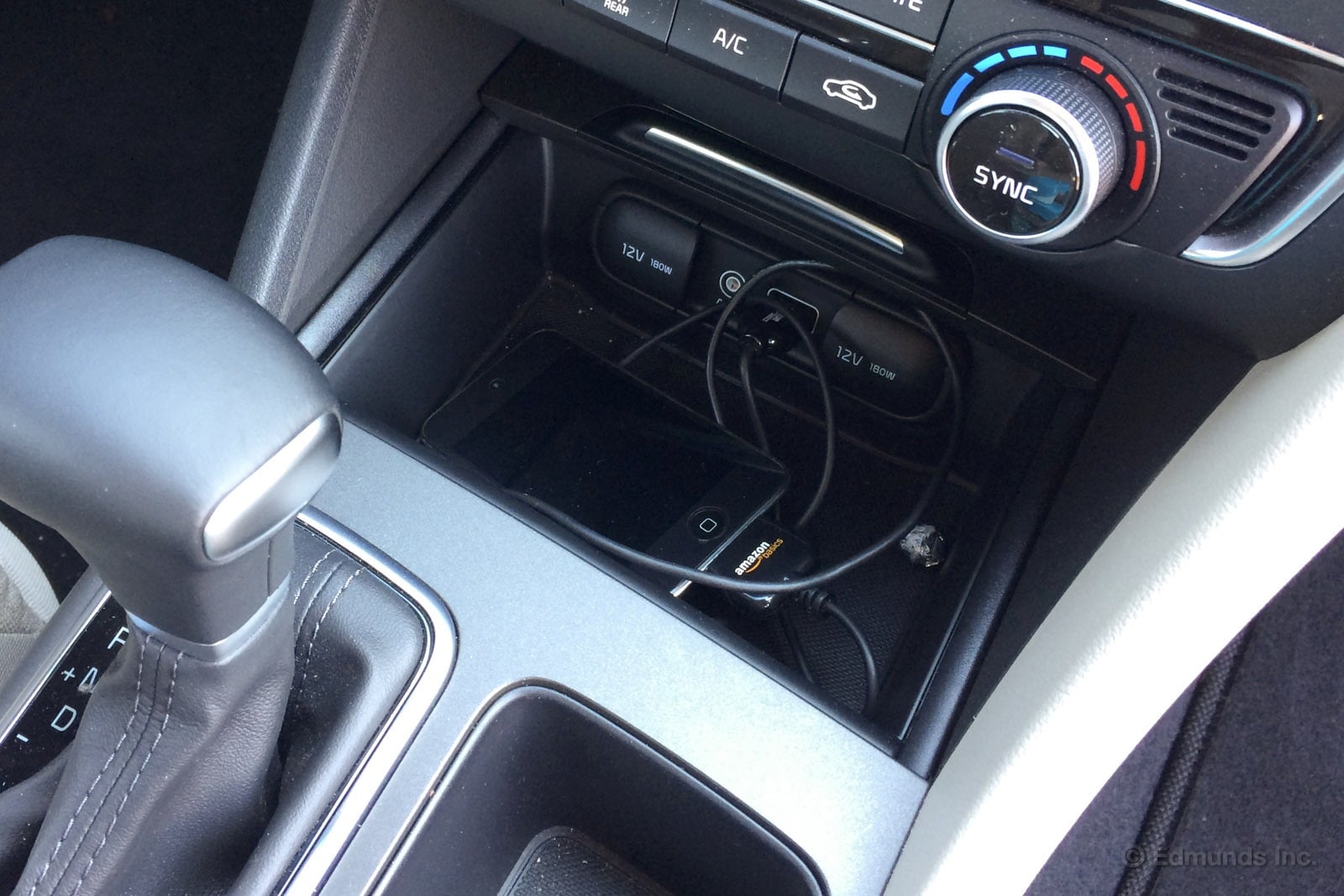
The forward storage bin, which has a sliding lid, contains two power ports plus a USB interface and auxiliary audio input. If you close the lid, the bin is big enough to hold a typical cell phone and keep it out of sight.
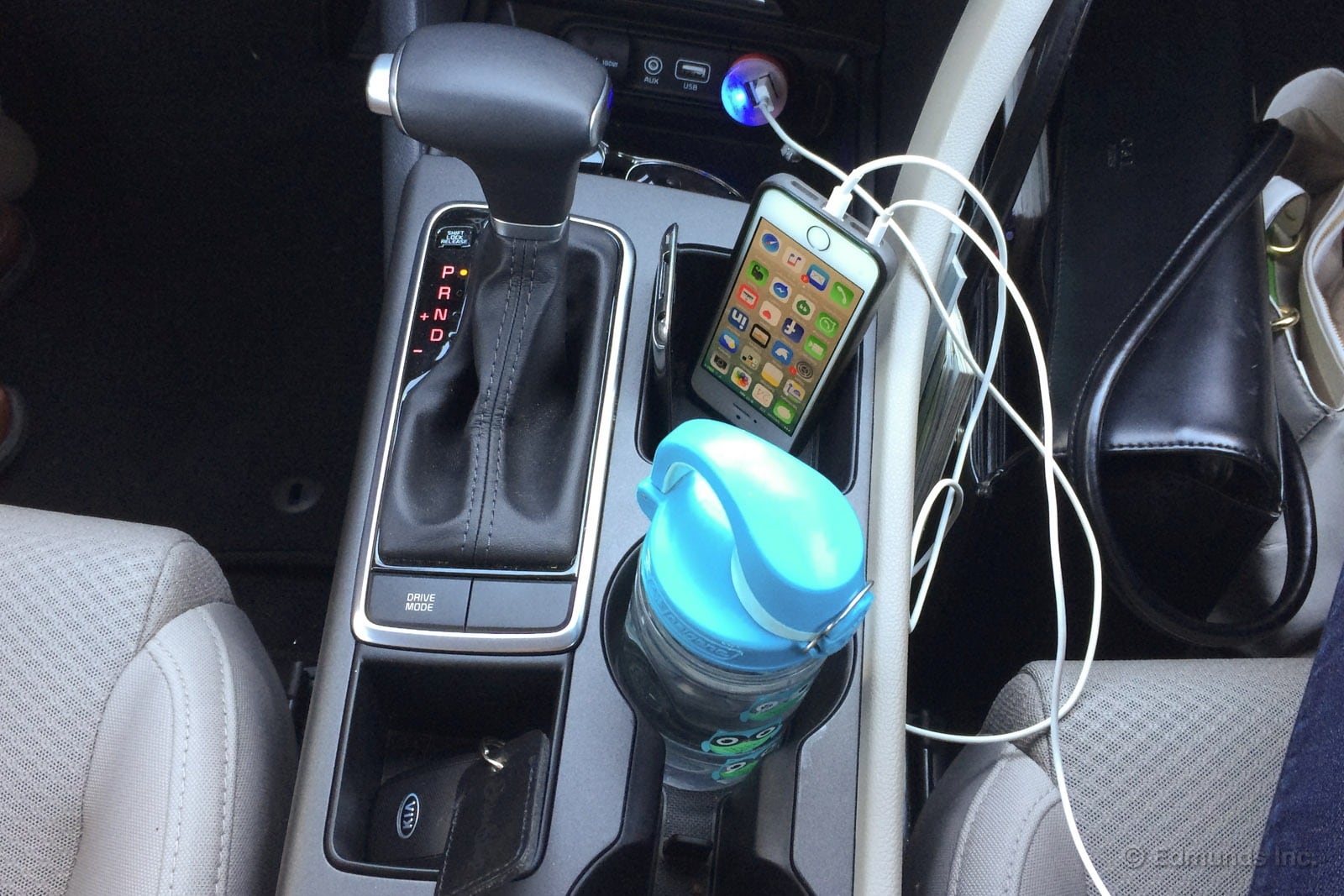
Or you can load up the other accessory bins. I've found the bin behind the gear shift lever works well for holding the key fob and/or your keys (our car has keyless access and ignition).
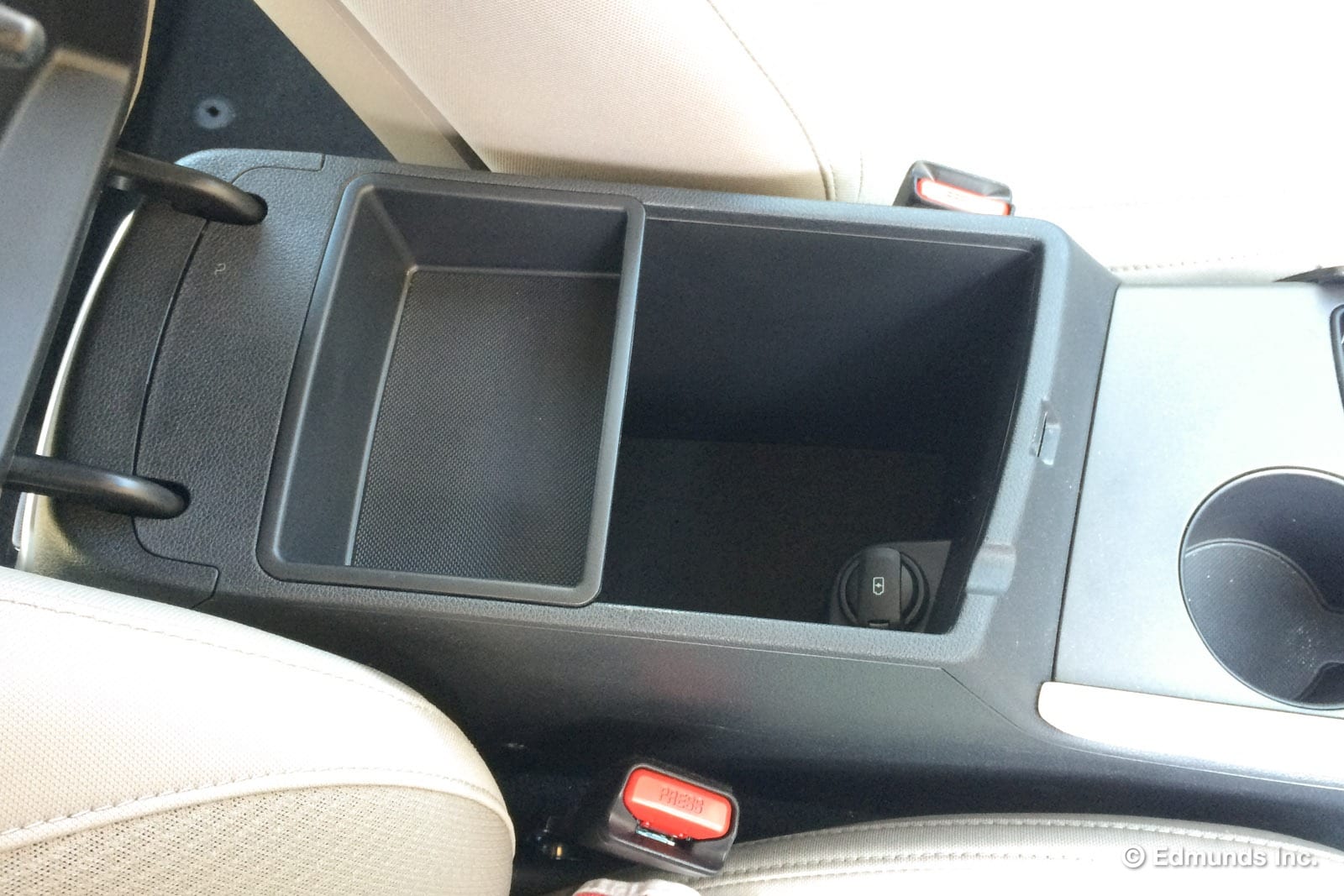
Behind this and underneath the armrest is the main center console bin. An extra USB charger is located in here. The extra top storage tray is removable.
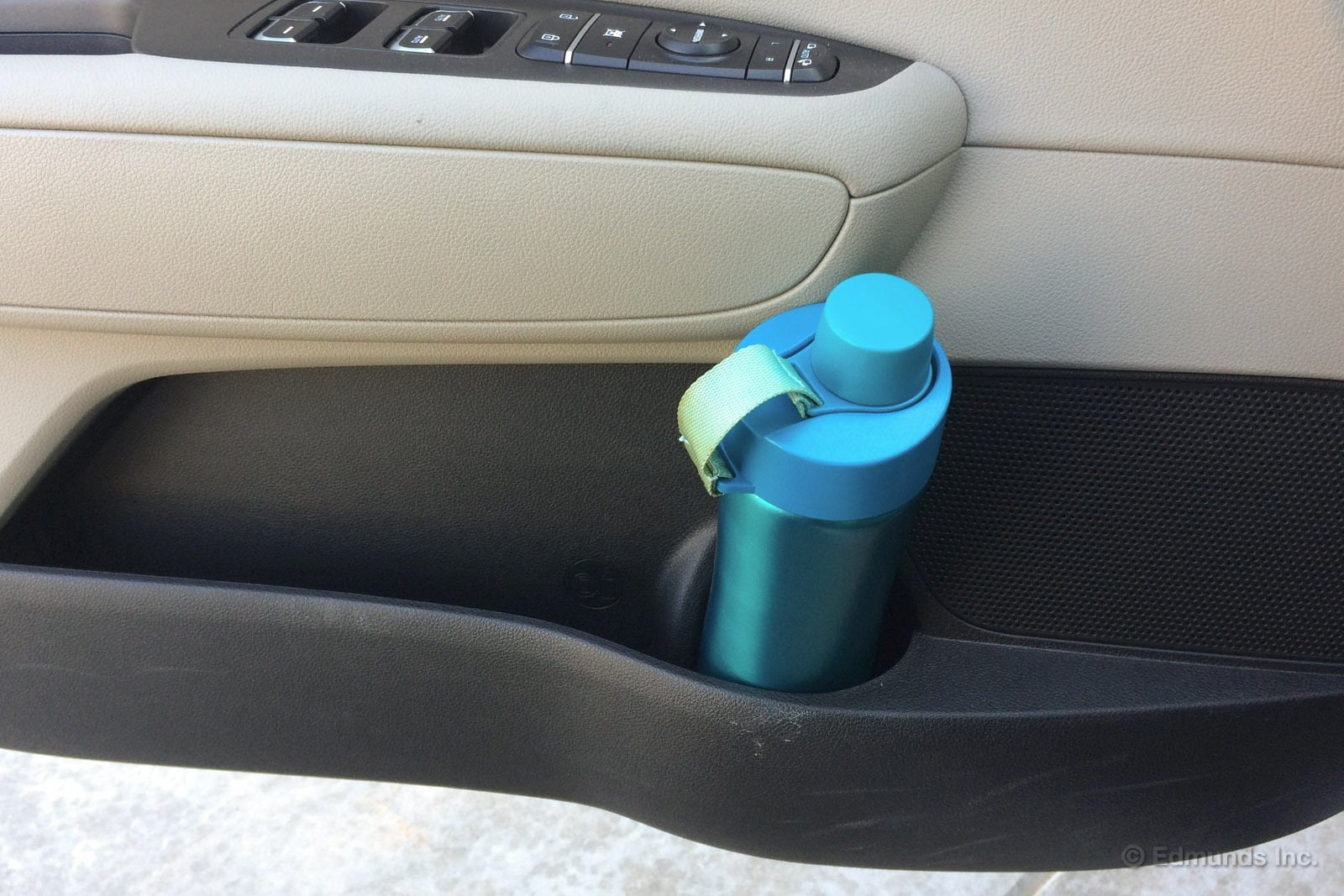
I also like the front door bins. Even tall water bottles will fit in here, and the extra slot can come in handy for keeping other items.
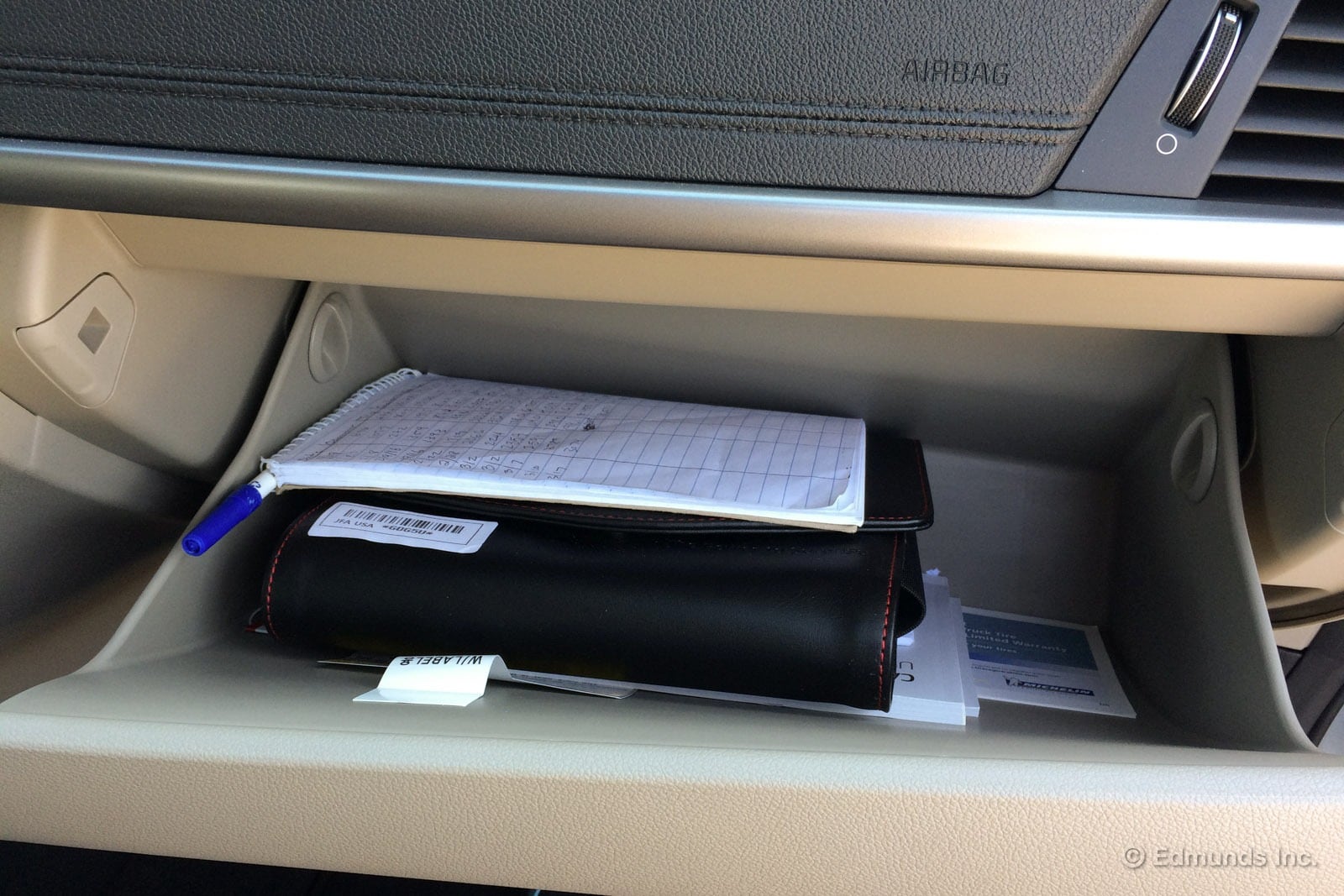
Of course, there's also the glove box. We've currently got the owner's manual and our fuel log notebook in here.
Overall, I think the Optima should have you well-covered when it comes to storing your stuff.

It's capable of impressive range and fuel efficiency, produces plenty of power for its mass, and has a pretty large back seat. Now we also know that our 2016 Kia Optima is also one of the safest midsize sedans available, having just earned the Insurance Institute for Highway Safety's Top Safety Pick+ rating.
Well, not our Optima specifically. Although the Optima lineup makes the best grades across the IIHS's five crashworthiness standards — small frontal overlap, moderate frontal overlap, side, roof strength and head restraints and seats — only an Optima equipped with the optional front collision mitigation system with automatic braking rates as "superior" in front crash protection, thus earning the top award.
And to get front collision warning and auto braking, you need to buy the Optima SX trim and add it, or buy the Optima SX Limited, which includes it as standard equipment. But then you're spending another $6000-$10,000 more than our LX 1.6T.
Still, we're driving around in a midsize sedan that earns about the highest safety marks available from both the insurance industry and the government for about $27,500. I can handle the braking myself.
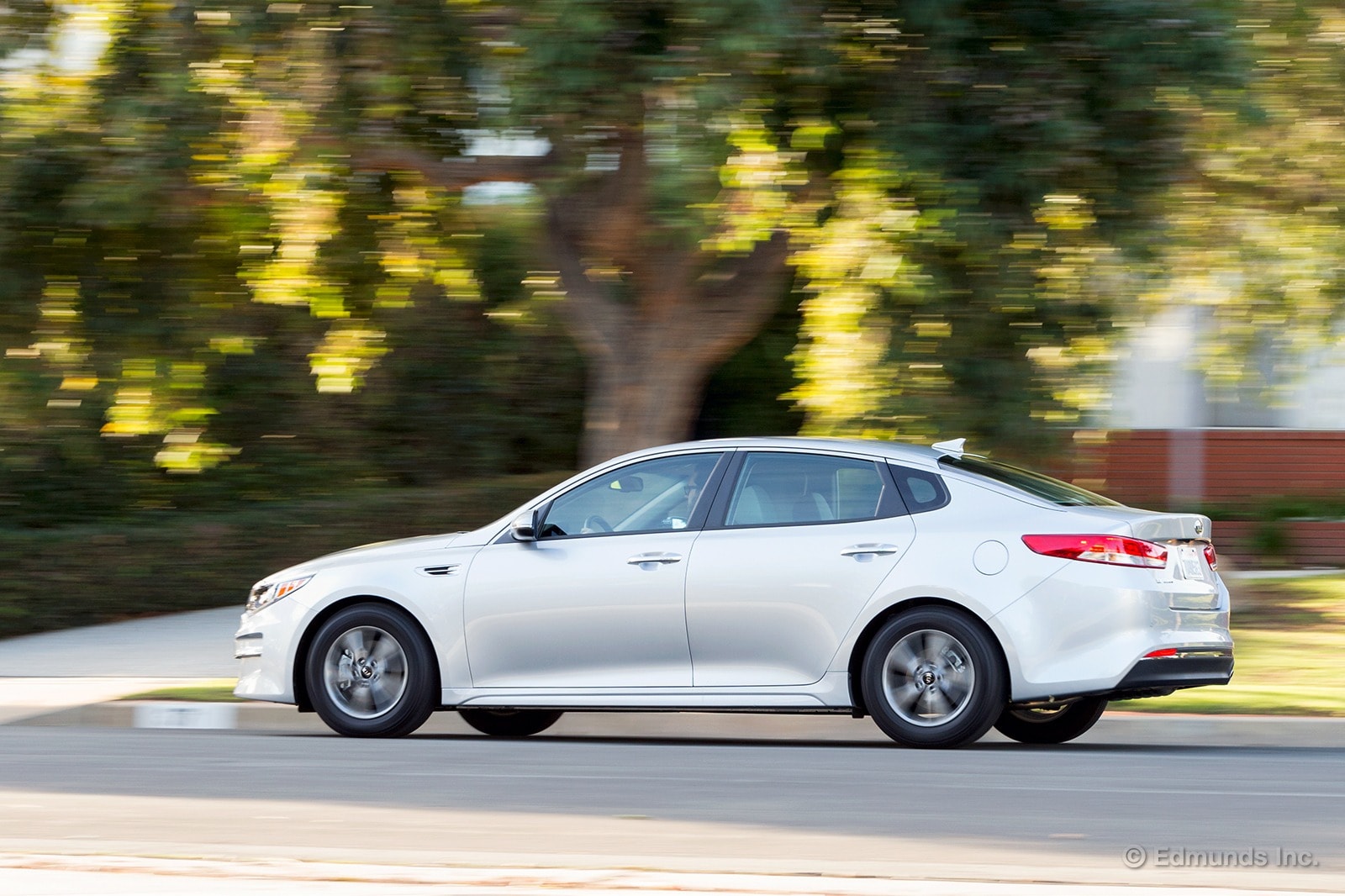
After climbing out of our long-term Toyota Tacoma, I hopped in to our long-term 2016 Kia Optima, hoping for a respite of comfort and relief. I complained a bit about the Tacoma's brakes and I thought a comfy family sedan would give me the calm, isolated commute I was looking for. While it didn't disappoint in terms of comfort, the Kia did have some drivability issues I wasn't expecting.
First, this otherwise cushy four-door has some pretty touchy brakes. The pedal feel isn't very linear, and it grabs the brakes way too early in the pedal travel. It isn't as bad as our Tacoma and coming to a smooth stop can be done (with you concentrate enough) but the city is the wrong place to get acquainted with such sensitive brakes.
Throttle calibration is strange, too. Imagine you're stopped at a traffic light, first in line. The light goes green and you let of the brake. You don't want to dart out into the intersection like it's the start of a drag race, but some movement would be nice. Not in the Optima. It doesn't move. It's not really motivated to go anywhere.
I checked the car for an automatic stop/start feature. No dice. I watched the RPMs to confirm. Yup, the car was still running, but not going anywhere. Essentially, it's a really pronounced dual-clutch automated manual transmission and in "Normal" mode, there's a long gap before the car responds to any inputs. My fellow editor, James Riswick, recommends putting the car in sport mode and for now, that'll be my solution too.
If it were my money, I'd probably opt for either of the Optima's other available engines: the 2.4-liter or the turbocharged 2.0-liter, both of which come with standard six-speed transmissions.
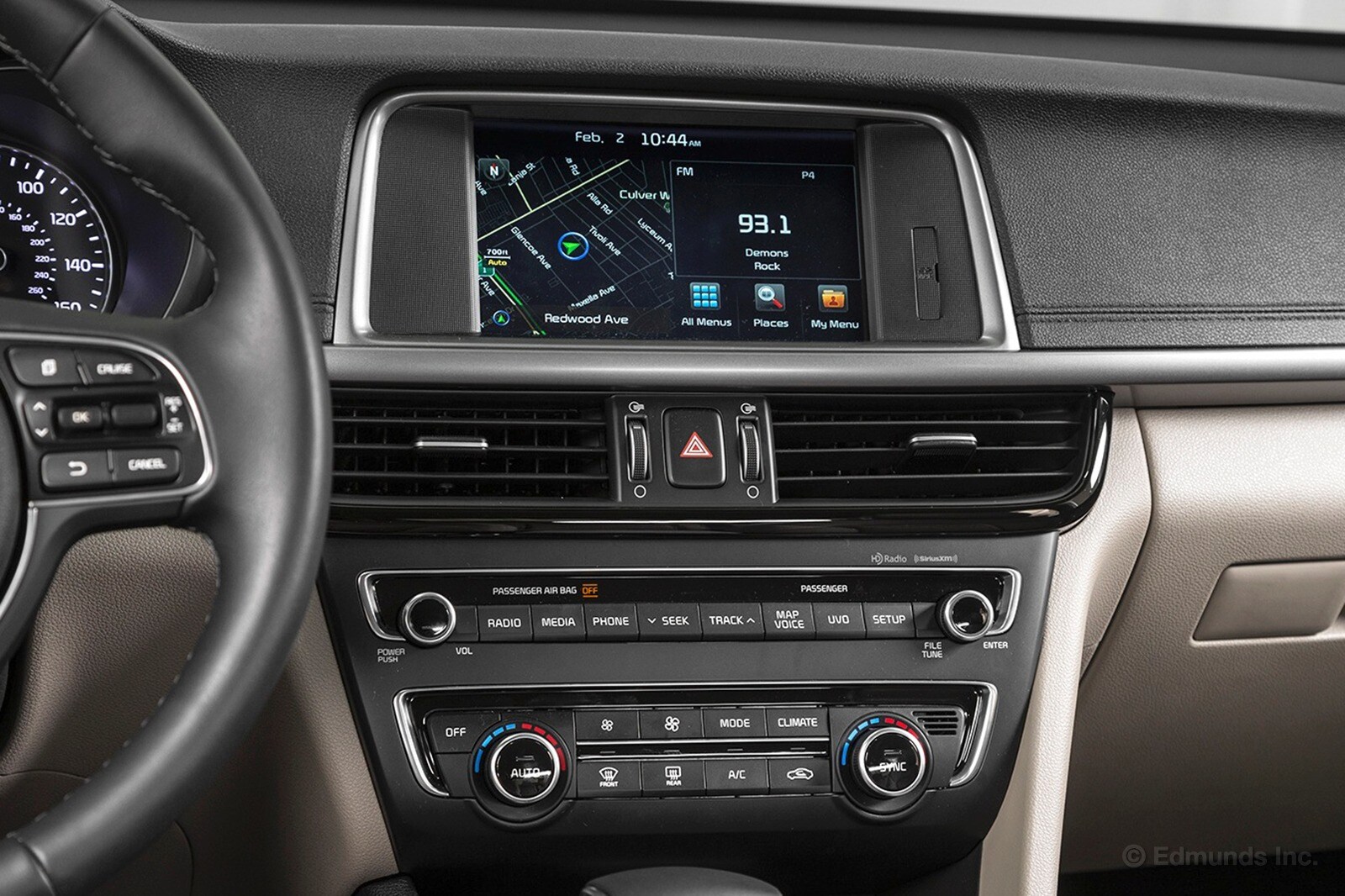
I've already gone on record and said how much I like our long-term 2016 Kia Optima's interior, especially as it relates to its big brother, the K900. However, I think it's worth noting just how easy it is to learn, and use, the Optima's infotainment system, too.
With our Optima, there's virtually no learning curve or waiting time. The first time I sat in it, I plugged in, and seemingly right away it indexed my way-too-crowded music catalog and began to play. And that has been the case every time I've driven the Optima.
The screen is basic, but it has good graphics and easy-to-read font. There are multiple, tactile knobs paired with logically located steering wheel buttons and well-placed dashboard controls. There are a few redundancies, but nothing seems useless.
In short, the system is simple and it works well for basic daily tasks, which I consider to be the most important kinds of tasks.
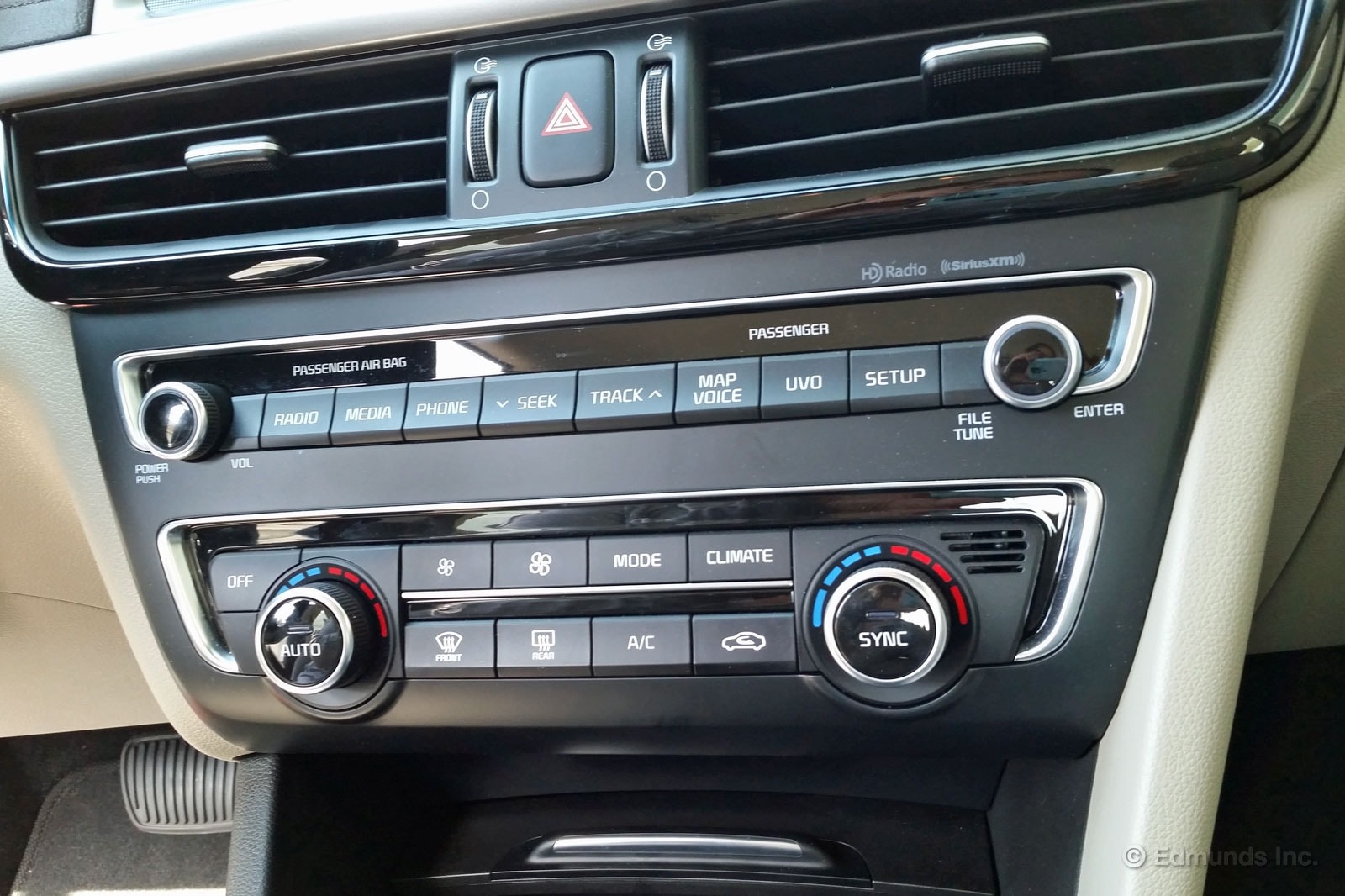
I've been shopping for a new personal car recently, and I've realized that the work advantage of driving nearly everything on the market does not necessarily make it easier when choosing a vehicle for your personal needs.
In other words, I want to build my own "hybrid" — Audi seats, BMW steering, Porsche brakes, maybe a Ferrari badge?
This evening I was again reminded of another addition to my list when I climbed behind the wheel of the 2016 Kia Optima. To me, the Optima's navigation and audio system controls are perfect.
There are wide, clearly marked buttons and large knobs exactly where they should be. Even first-time or occasional Optima drivers will have no trouble finding the radio or initiating the nav system, turning the volume down or the heat up.
Just plain simple. Doesn't get much better than that.
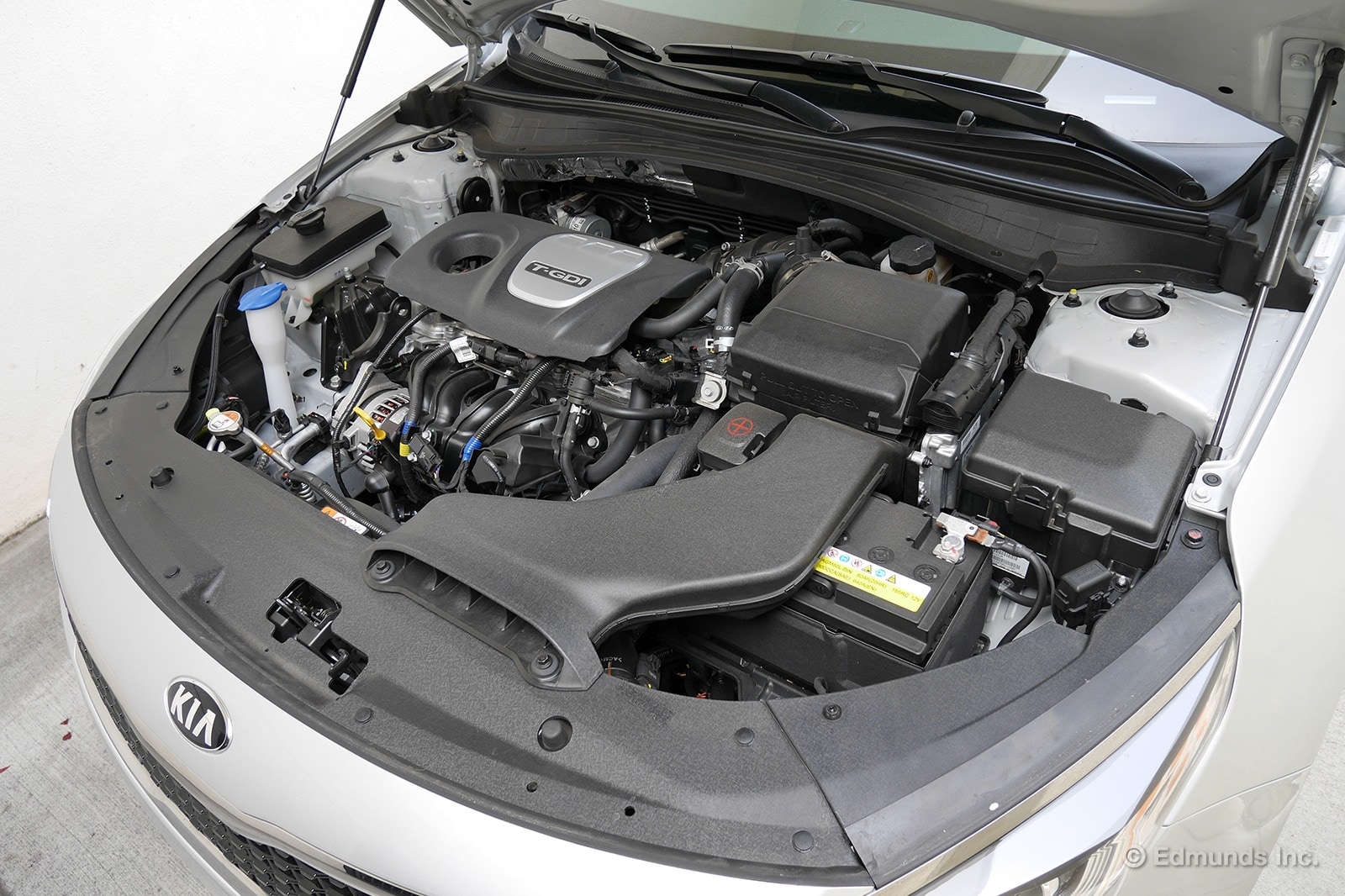
There's a good chance you're already aware that Kia provides one of the two best warranties in the automotive industry (the other is offered by corporate cousin Hyundai). But what does our 2016 Kia Optima's include, exactly? Well, let's find out.
1) 10-year/100,000-mile limited powertrain warranty. This is so attractive for two reasons: First, it's nearly twice as long as that of many competitors. Second, the powertrain components (engine, transmission, etc.) are quite often the most expensive things to repair or replace. Engine-bay-related items that are exceptions would be the battery and emissions-related parts, which have lesser warranties. If you would like the list of all the things the powertrain warranty covers, download a copy of the Warranty Manual from the upper right of this page.
Keep in mind that if you should sell the car, the powertrain warranty is reduced for that second owner to 60 months and 60,000 miles. The exception, should you be a used car shopper, is a certified pre-owned Kia that gets the remainder of the full coverage.
2) 5-year/60,000-mile limited basic warranty. This would be just about everything that isn't powertrain. Its five years of coverage stands in contrast to most non-luxury brands, which typically only cover three years. Even most luxury brands are only good for four years. Jaguar Land Rover in particular recently introduced five years of coverage.
So what did I mean by "just about everything?" Well, the original equipment radio, CD player and navigation system are only covered for three years and 36,000 miles, which is what everyone else offers anyway.
3) 5-year/100,000-mile limited anti-perforation warranty. This would be related to rust and corrosion. It would also be the least impressive aspect of the warranty. Five years is typical and most companies offer unlimited-mile corrosion warranties.
4) 5-year/60,000-mile roadside assistance plan. Again, this is longer than what most non-luxury brands offer since most mirror the age and mileage of their limited warranties terms. The roadside assistance is attended to 24 hours a day, 365 days per year and is accessible throughout the United States. It is attended to by a network of more than 17,000 providers that'll help out with minor issues (dead battery, flat tire, running out of gas) to complimentary towing for breakdowns.
So there you have it.
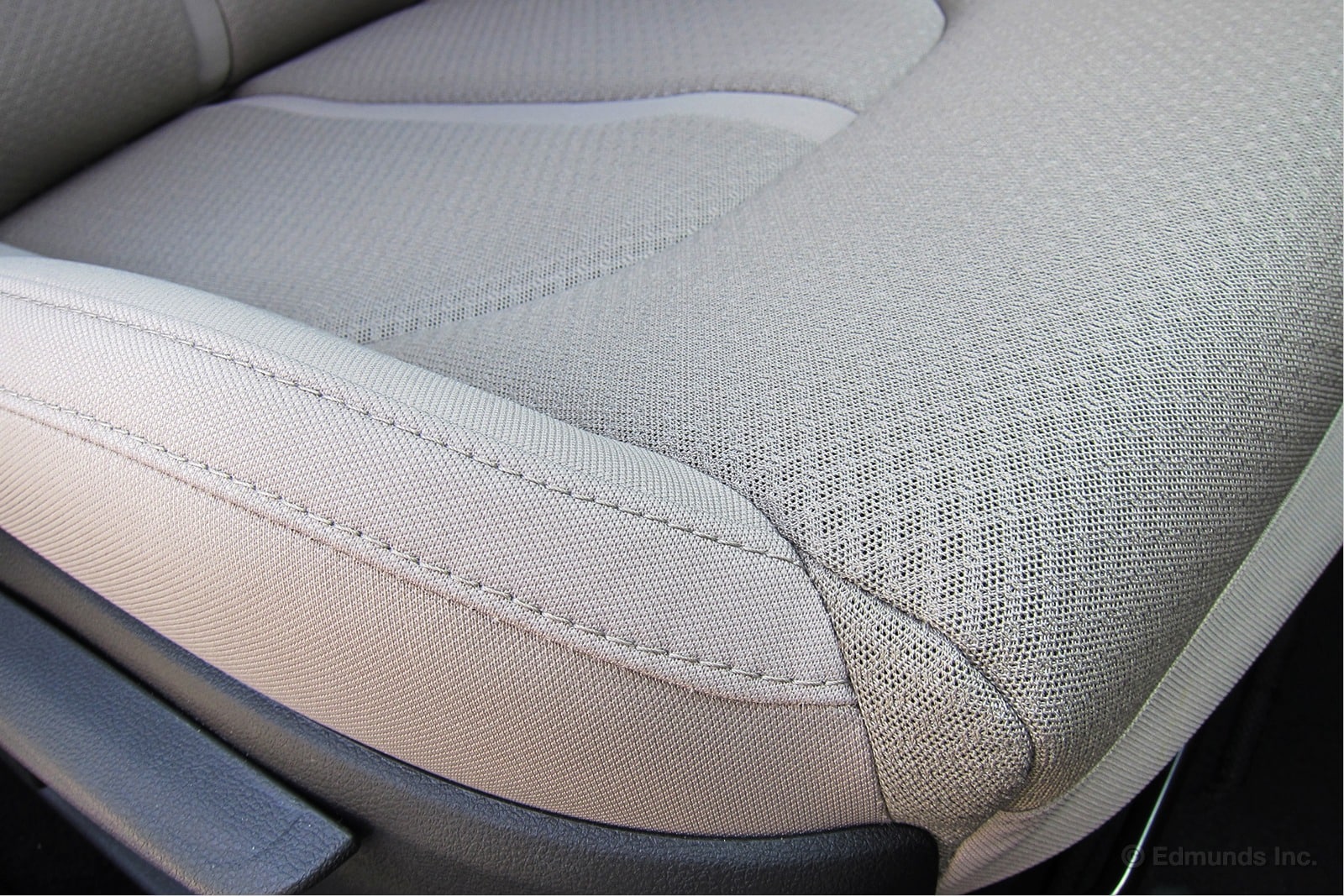
We had an Optima SX Turbo in the fleet a few years ago. It was pretty well-liked. At the time I took issue with some of its interior materials, specifically the black leather upholstery and steering wheel wrap. Kia called it leather anyway. I'm pretty sure it didn't originate in the animal kingdom, but rather in some polyvinyl lab experiment.
It held up fine during the year we drove the Optima, but it felt cheap for a $30,000 car and I questioned how long it would hold up over the lifespan of the car.
The upholstery in our more budget-minded 2016 Kia Optima LX 1.6T doesn't make any pretensions to be leather, fake leather or even premium cloth. I actually kind of like it more because of it.
Our current Optima's seat material is some kind of cloth/mesh hybrid that feels more like a good office chair. Not Aeron premium, certainly not luxurious, but as a synthetic material, it's comfortable and better quality than you'd find in an economy compact or work truck. It's not Mercedes-Benz MBTex good, but a good standard for a car at this price. I'd take this material over the robo-reptilian stuff in our old SX, and that car cost $3,000 more than this Optima.
Now how well the off-white color holds up over the year, or how easily the material repels stains and how it wears remains to be seen.
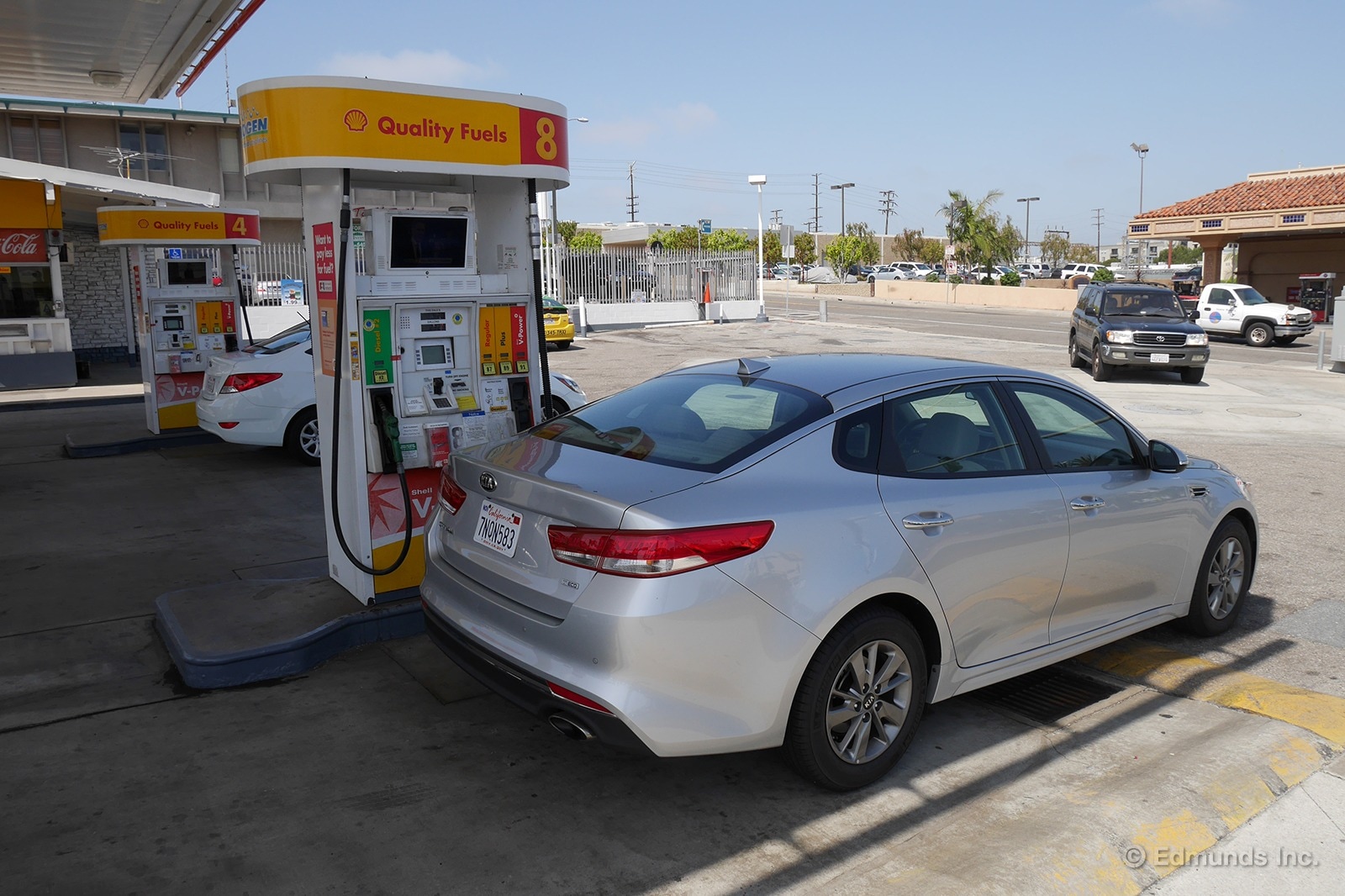
Our 2016 Kia Optima's fuel economy has experienced a significant jump since we last updated you on its fuel economy, climbing nearly 4 mpg to achieve a lifetime average of 28.8 mpg. Of course, the LX 1.6T trim and its powertrain are supposed to achieve an EPA-estimated 32 mpg combined, so there is still plenty of catching up to do.
As Brent Romans reported, however, he was able to achieve nearly 40 mpg on a whopping 574.7-mile tank, besting the EPA's highway estimate of 39 mpg. A few more open road adventures like that and I reckon the Optima should creep further up to its EPA combined number.
Average Lifetime MPG: 28.8
Best Fill MPG: 39.9
Worst Fill MPG: 22.6
EPA MPG Rating: 32 combined (28 city/39 highway)
Best Range: 574.7 miles
Current Odometer: 5,030
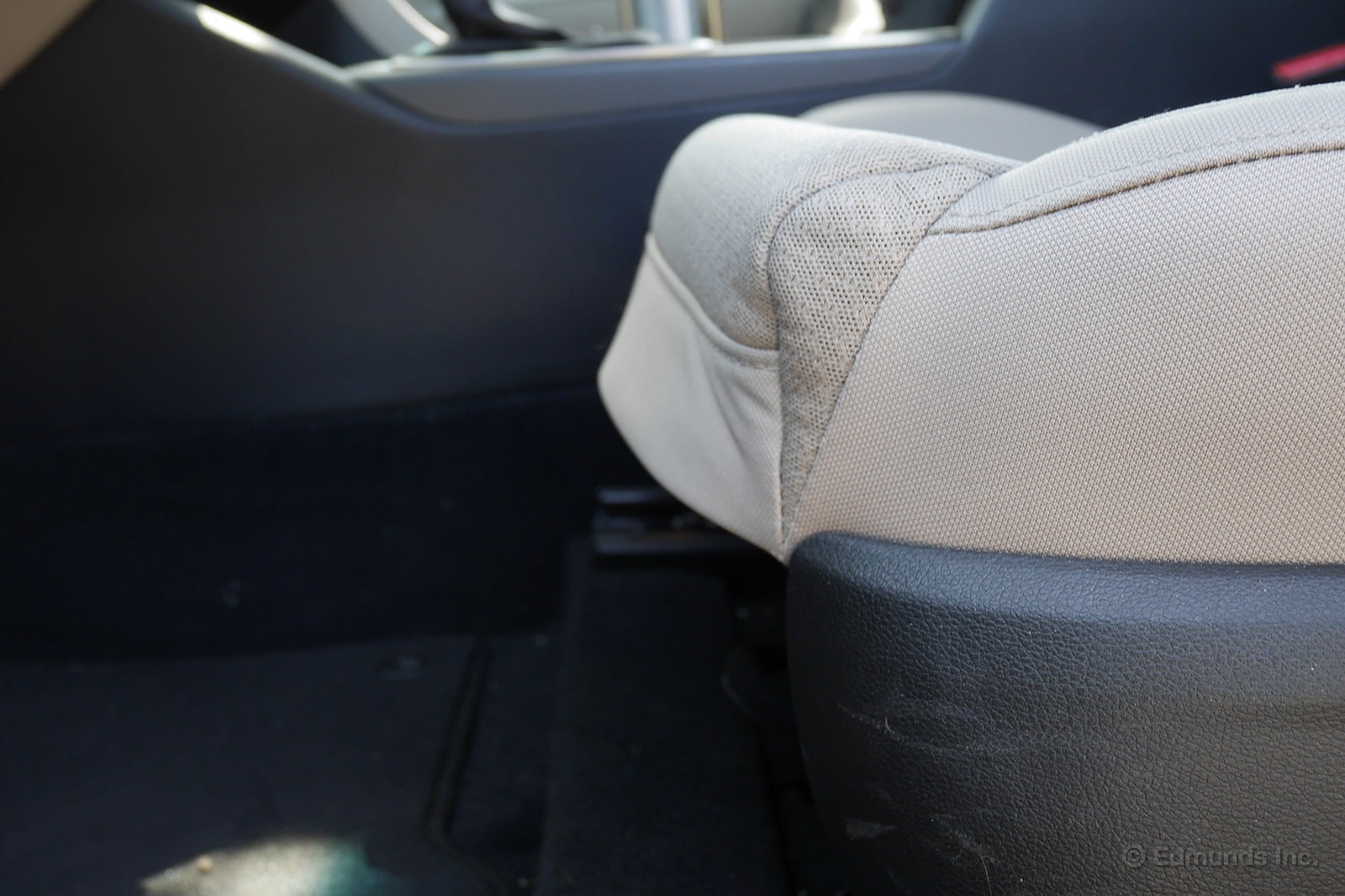
The front seat bottom edges in our 2016 Kia Optima should be tucked under and secured in some way, but they have instead popped free, making it possible to feel the padding underneath. This is the case for both the driver and passenger seats. It's not overtly noticeable, but you can definitely see that it doesn't look right. I've tried to feel around to see if there's some way to easily re-secure the bottom edge, but no dice.
Needless to say, this is unimpressive — especially after only 5,000 miles. Then again, it's also the only quality qualm in the cabin to date. Something to address when I eventually take the car in for its first service.
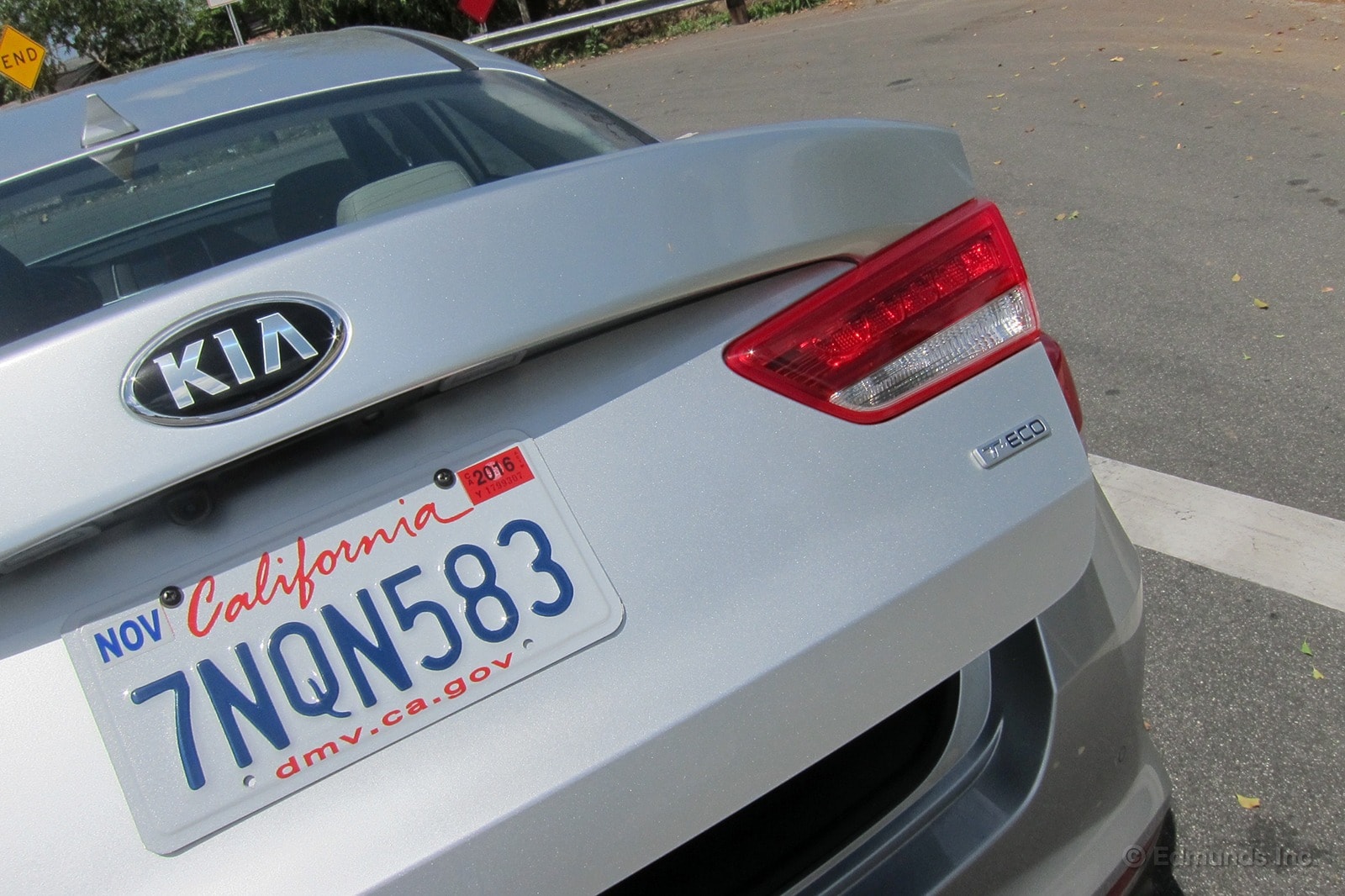
It's not a new party trick, but our 2016 Kia Optima has the same nifty hands-free trunk as our former Hyundai Sonata. I forgot all about that feature from the Sonata, let alone that it existed on the Optima, until talking to a neighbor while standing around near the back of the car.
I walked out to my driveway, key in pocket, as my neighbor passed by. He said he liked the Optima's styling, which I've found is one of the first things most people say about this car. It's fun to watch their reactions when you tell them the Optima was styled by a guy who was Audi and Volkswagen's former design boss (Peter Schreyer). There's always an "a-ha" moment, as if now it all makes sense.
As I leaned back on the trunk lid, the Optima beeped three times, and I heard the trunk latch release. It took me a second to figure out what happened. I thought I'd pressed the trunk release on the keyfob in my pocket, but no.
Instead the Optima senses when the key is in range, near the trunk lid, as its owner approaches with the proverbial armful of grocery bags. It sounds the alert beeps, then unlatches the lid. The lid opens with a decent amount of force as well, opening to about a third of its maximum travel.
The Optima's other convenience is unfolding the power mirrors and illuminating the door handles when you approach the driver or passenger doors. This reveals another minor gripe: You still need to unlock the doors yourself by pressing the button in the door handle.
Such a tease, this Optima.
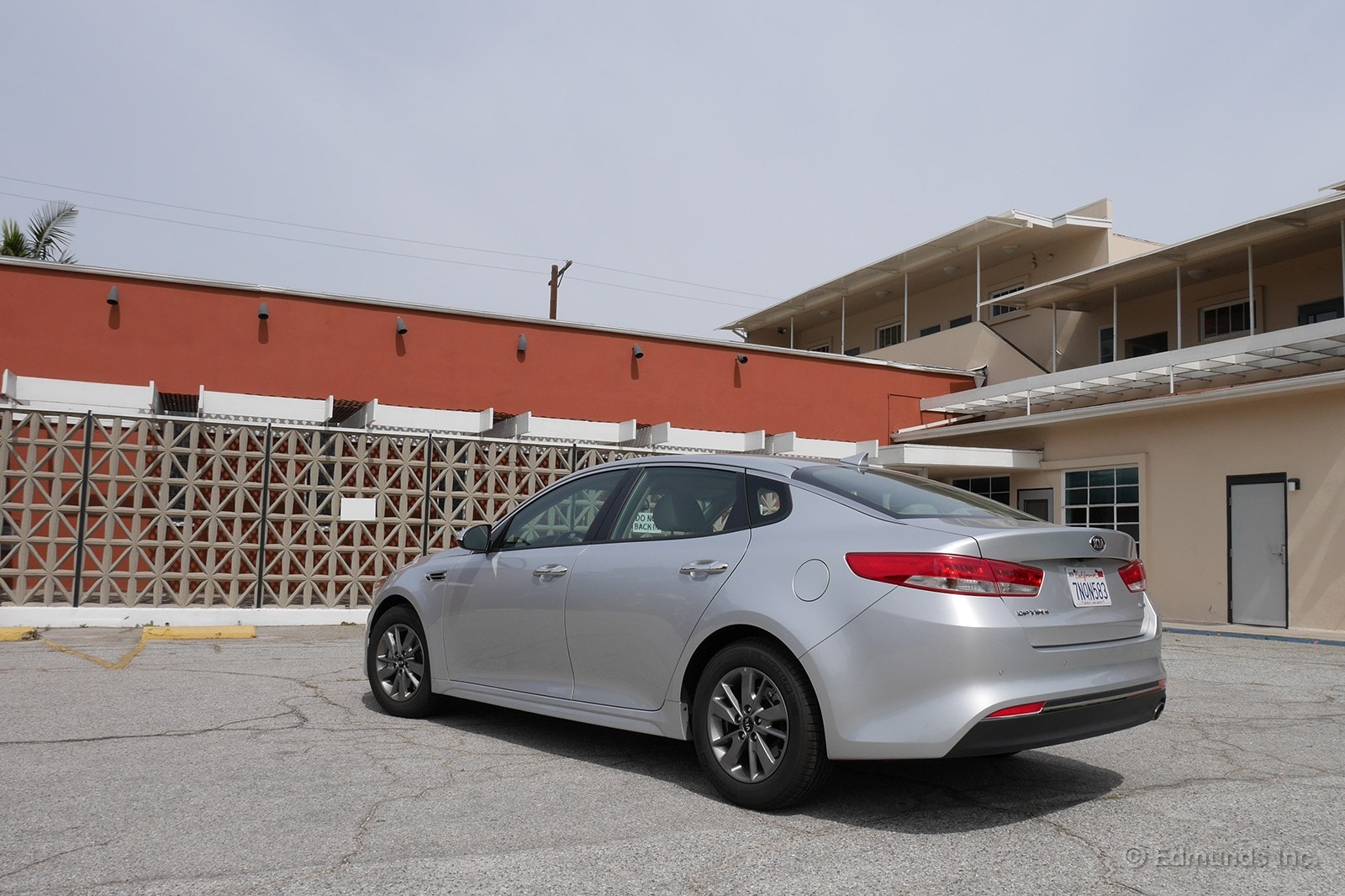
A whopping 17 2016 Kia Optimas are being recalled. According to the National Highway Traffic Safety Administration, "the driver's frontal airbag may be missing a chemical enhancer required for the second stage airbag deployment, resulting in the second stage deploying improperly in certain crashes."
To my great relief, as I'm the guy who'd have to take it in to be serviced, our Optima is not one of those 17 Optimas. Nevertheless, if you also have a 2016 Optima, do as I did and contact Kia's customer service at 1-800-333-4542. Have your VIN ready and if my experience is any indication, you'll get a customer service person quickly and they'll be able to tell you if your car applies.

Earlier this month, Kia announced that Apple CarPlay will be added to the 2016 Kia Optima. That's great news if you're considering buying one, however, current owners like ourselves are not SOL. Customers who have previously purchased a '16 Optima (or '17 Sportage) with a navigation system will be "provided with a downloadable update via myuvo.com" beginning in the third quarter.
Apple CarPlay hasn't been universally loved among our editors but I've certainly appreciated its podcast, Pandora and MLB At Bat apps. Adding them to our Optima is good news indeed … well, eventually.
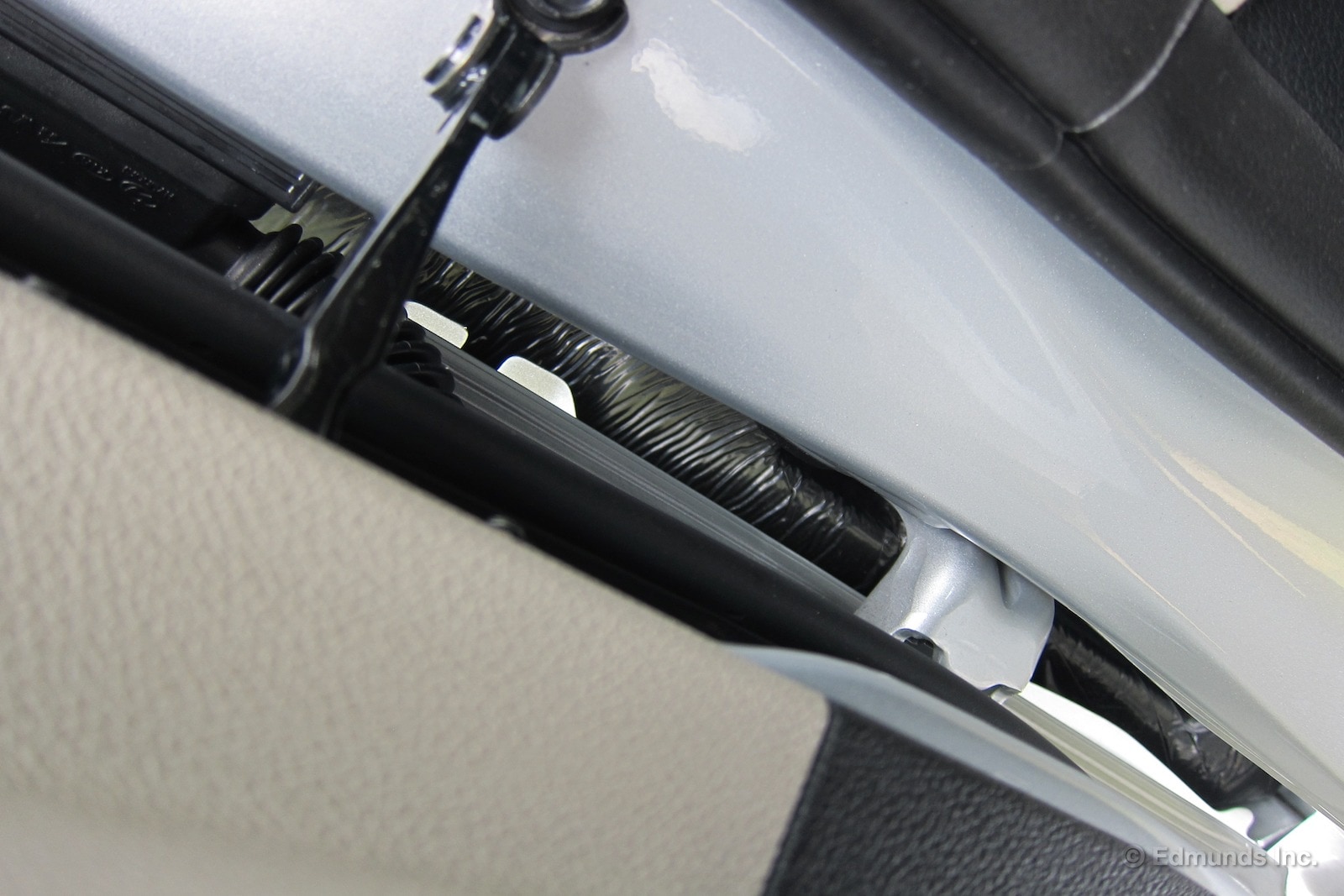
This falls under "once seen, can't be unseen." Overly critical perhaps, but an automaker needs to conceal the magic a little better than this. I'm talking about these vinyl-wrapped chunks of sound deadening material wedged between the body panels of our 2016 Kia Optima.
Open the driver side door as I've done here, cast a quick glance as you're lifting a leg over the sill, and there they are behind the hinges. It's nitpicking, but consider the context. Kia has worked for years to overcome a reputation as a second-rate maker of Japanese alternative econoboxes. And they've succeeded in spectacular fashion with great designs, good engines and powertrains, loads of standard features and attractive price points.
But a little miscue like this can pop a small hole in your perception of the brand. And at $27,545, our Optima no longer plays in the best-for-cheapest category. I'm a little disappointed to see this, and I'm just a guy who writes about cars. I think I'd be doubly disappointed to see this if I was a new owner.
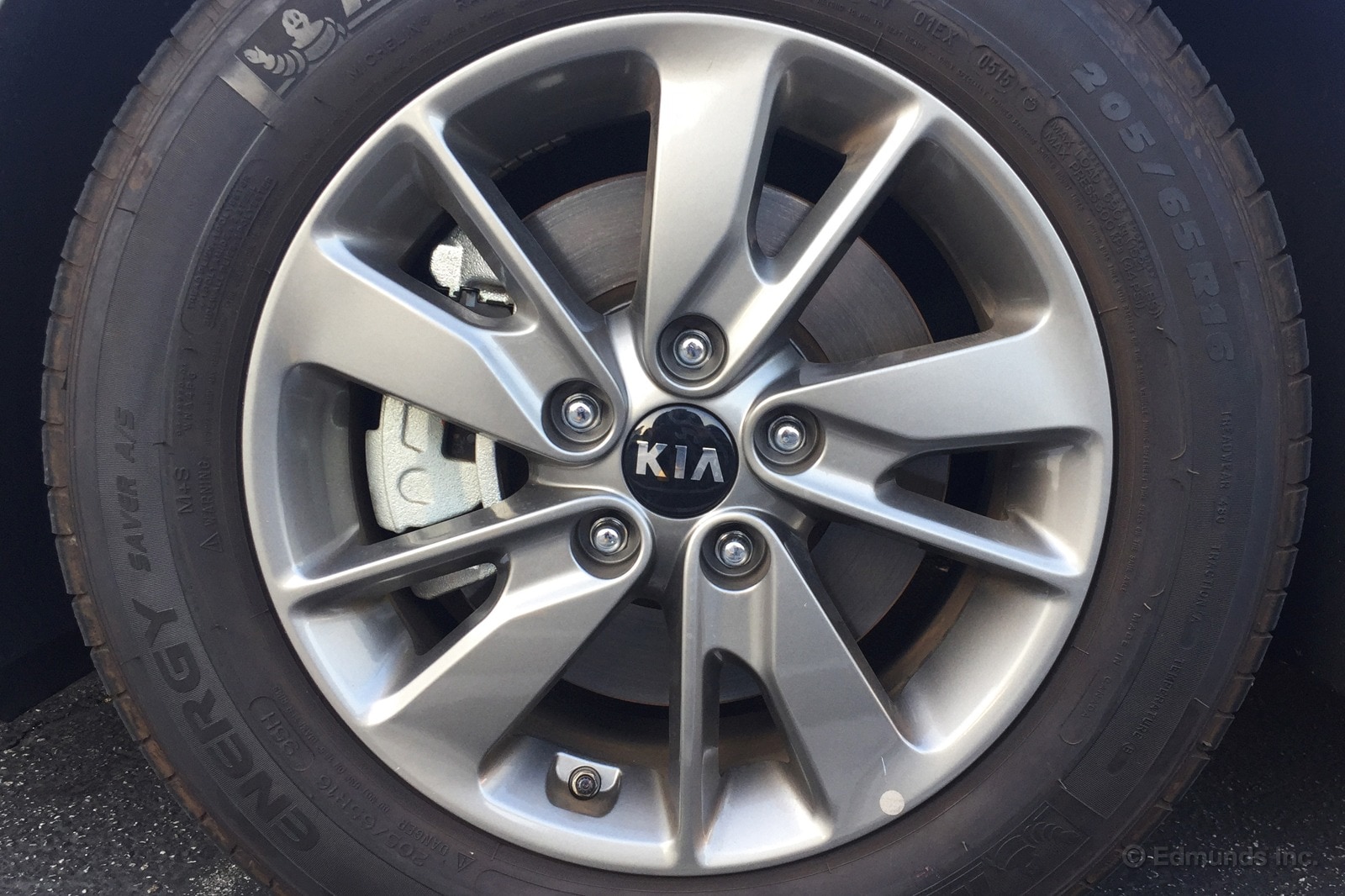
This past week I took our long-term 2016 Kia Optima home for the first time since driving for its initial photo shoot. There were other cars available, but I was set to leave work right as traffic was hitting its fever pitch and I wanted something quiet, comfortable and easy to drive. If I'd remembered how touchy the brakes were I might have gone with another car.
The initial bite is hard and abrupt. The pedal doesn't have much travel, so all the braking power seems to be up top. Tap the brakes, the nose dives and you lean forward. I felt like I was learning to drive again.
I didn't remember anyone ever mentioning this before, so I thought maybe it was just me. I wore a different pair of shoes back to the office the next day. Still, I felt the brakes were a little too sensitive. I went back, though, and found a post by Travis Langness that mentioned the same thing, so I knew I wasn't alone. Even during our performance test, Carlos Lago noticed a bit of shudder through the pedal.
Despite the two cars being mechanically related, I don't remember our former long-term Hyundai Sonata being this sensitive. Then again, maybe it was just me.
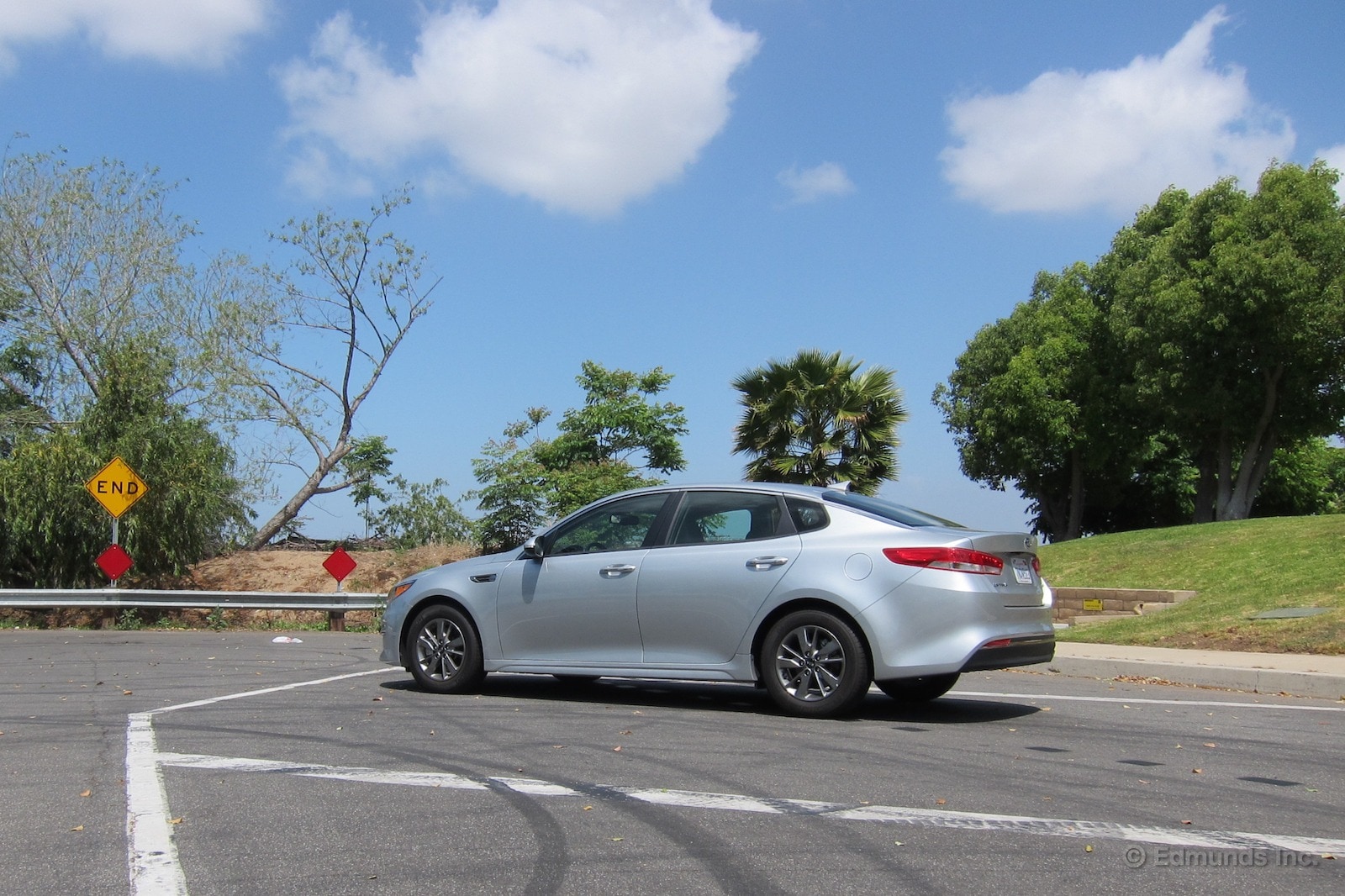
Our particular 2016 Kia Optima, with its turbocharged 1.6-liter engine, leads the rest of the Optima lineup with an EPA-estimated 32 mpg combined. We're getting almost 29 mpg, so we're close. I imagine if we committed to driving the Optima in either Normal or Eco modes, we'd reach that 32 mpg in short order.
Then again, if we committed to driving the Optima in Normal or Eco, we probably wouldn't drive it much. In Normal mode, you're in fourth gear before you've reached 40 mph and mashing the accelerator from a standstill is received more as a suggestion than an urgent command.
In Eco, you might as well keep a couple of friends in the backseat at all times to push the car into action from a stop. They might need to get out and push when attempting to pass another moving vehicle, too. Or a stationary one.
No, Sport is really where it's at and where you want to be. In Sport mode, there's a thick sweet spot around 1,500 and 2,800 rpm. The engine is humming, the turbo is spinning, and when you pin the accelerator to pass a slow-moving convoy, the Optima moves as if cast from a slingshot. It's the one moment when this fuel savings-minded car generates a genuine sporty thrill.
And you don't need to be mowing down lanes of traffic to induce it. Just keeping it in the sweet spot on the freeway makes for smooth and fun leap-frogging around the mass of texting and otherwise oblivious motorists.
There's a downside. In Sport mode, the Optima tends to lurch and stumble at slow speeds (downshifting while rolling to a stop, prowling a shopping center parking lot). We've also never really comparison-tested the results of a full tank in each of the three modes. I'm certain Sport mode stretches the gap between EPA fuel economy and real-world results.
It's a small price to pay for such on-demand entertainment.
Rear Cross-Traffic Alert Is a Worthwhile Feature To Get

Back in March, Ed Hellwig wrote an update noting how the beeping of the blind-spot monitoring system in our 2016 Kia Optima could be viewed as annoying. It's a legitimate gripe, even though Ed also said he'd ultimately choose leaving the system on just for the enhanced safety. Less controversial in my mind is our car's rear cross-traffic alert system. For helping you out in crowded parking lots, it's great.
Like blind-spot monitoring, rear cross-traffic alert came bundled with our Optima LX Turbo model's optional Technology package. It uses the same blind spot sensors for vehicle detection but activates instead when the Optima is put in reverse. Its purpose is to detect vehicles that might be crossing your rearward path, such as when you're backing out of a parking space and can't see around that big SUV parked in the next space.
When an oncoming vehicle is detected, the system beeps at you. I also like how our Optima's system displays a yellow indicator icon in conjunction with the rearview camera. Those yellow arrows in the photo above show which direction the detected vehicle is coming from. Not all systems do this, and it can help you judge which direction to pay attention to.
There have been a few times when I've been backing out of a parking space only to have the cross-traffic alert system notify me of an oncoming car. Normal over-the-shoulder rear visibility in our Optima isn't very good because of the sloping rear roofline and thick rear roof pillars, so cross-traffic alert can be a welcome layer of safety that nicely complements the rearview camera.
If you like the idea of having rear cross-traffic alert on your Optima, you'll typically have to make sure it gets added as an option. It only comes standard on the top SXL trim level. Otherwise, look for it with the LX's Convenience or Technology packages, or the EX or SX's Premium or Premium Technology packages.
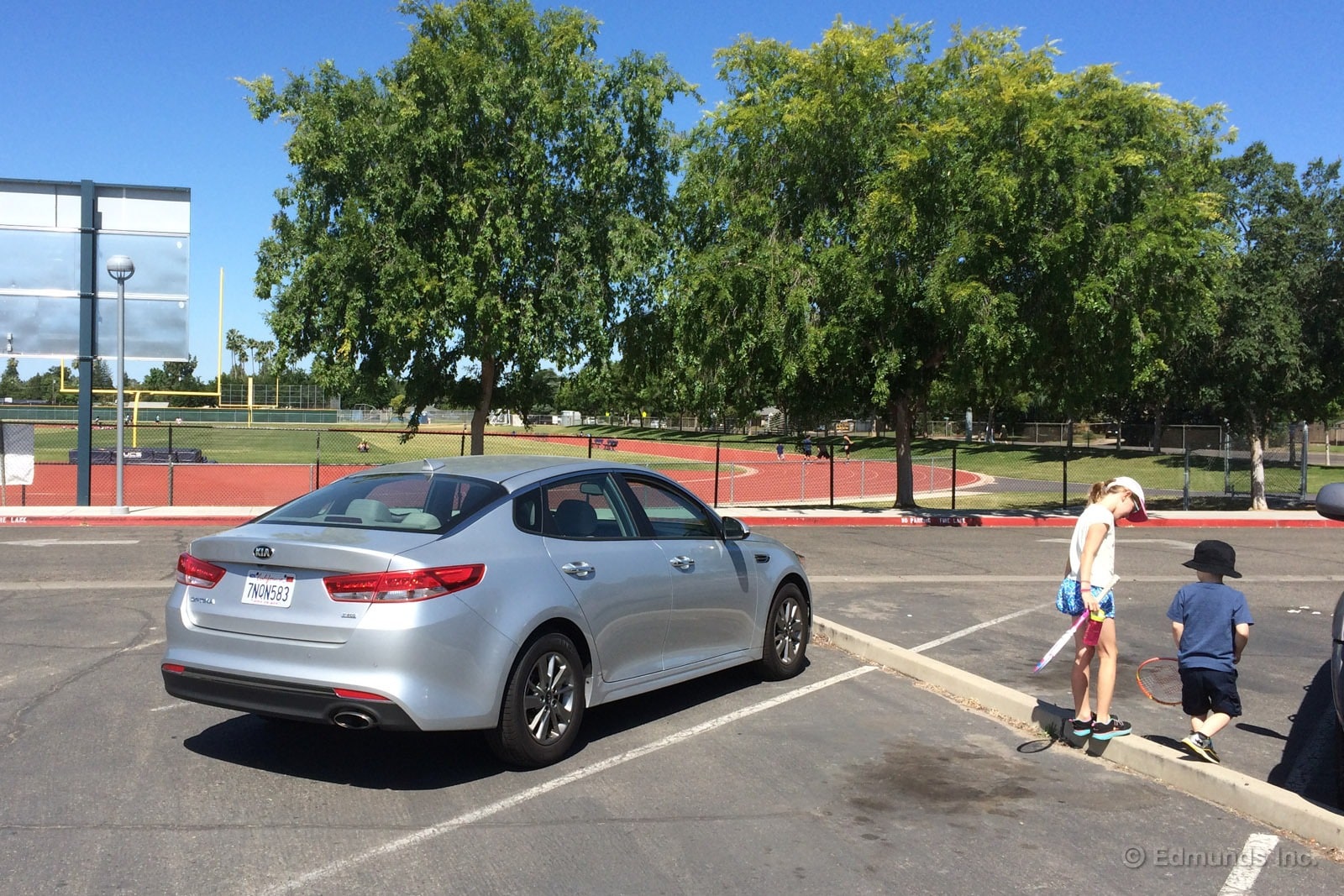
For people shopping for a new 2016 midsize sedan, I could imagine the experience isn't too far removed from heading down a grocery store's cereal aisle. You thought you were going to get Cheerios, but then you notice that Raisin Bran is on sale. And didn't your friend say that she really likes Chocolate Chex? Mmm ... chocolatey. Meanwhile, at your local dealership strip: Should I get an Accord? Camry? Fusion? Malibu? Altima? Mazda 6? Sonata? Optima? Argh, paralytic indecision!
Well, based on my experience with our long-term 2016 Kia Optima, I've got five reasons why I think a potential shopper will like the Optima best.
1: Availability of the turbocharged 1.6-liter engine. I covered this topic in an earlier update, but it's worth mentioning again: I really like this engine and transmission combination. It's pleasingly quick when you need it to be and, assuming you drive it with some normalcy the rest of the time (i.e., don't do what my coworker suggests with the Sport button), returns high fuel economy. It's a differentiator in this class.
2: Value. Admittedly, this is a shifty topic based on what incentives or deals are happening at any particular time for midsize sedans. Also, my feeling is that Kias aren't the amazing deals they used to be years ago. But they're also better built and more refined cars than they used to be. You can start with a regular Optima LX or move up to the fully loaded SXL. In the middle is our well-equipped LX 1.6 Turbo test car. With an MSRP of $27,590, it is a lot of car for your money.
3: Easy-to-use control layout. We wrote a couple updates back in April about the ease of use for our Optima's touchscreen interface and climate controls. I agree with both Kelly and Travis. You can get into our Optima and immediately know how to get what you want.
4: Styling. I waffled about listing this as one of my top reasons. I still find myself seeing other Optimas on the road and thinking: "Is that the old Optima or the new one?" This redesigned 2016 model just doesn't look very different than the previous generation. It might have been nice if Kia did a bit more to make the new one stand out. That said, I always liked the look of the old Optima, and it's the same story with the new one. It's a sporty and handsome sedan without going overboard.
5: Quiet and comfortable to drive. I'm happy getting in our Optima and driving it every day for commuting duty. My kids easily fit in the back. I've also taken it on a road trip and was pleased with the result. While I suspect I could make this claim for most of the 2016 midsize sedans on sale, my experience with our long-term car does make this particular quality stand out enough to make it into my top five.

One of the main function buttons on our 2016 Kia Optima dashboard is for "UVO." Unidentified Vehicle Object, maybe? No, it's just Kia's umbrella name for various infotainment features. There are different versions of UVO based on what year and model of Kia you own, but our Optima has the latest UVO eServices with navigation. Since Kia gives you a dedicated button for it, it's surely important, right? Well, let's find out.
If you check out Kia's UVO website, you can get the basic idea. Beyond the standard audio/entertainment stuff, the main functions of UVO are: 1) Vehicle diagnostics and maintenance notifications; 2) Emergency assistance; 3) Custom points of interest; 4) vehicle locating; 5) Alert notifications for various driving scenarios.
To use these features, though, you have to register for a UVO account and download the UVO app for your smartphone. (Note: I covered this topic for our long-term Kia K900 more than a year ago, but it seemed worthwhile to explain again.)
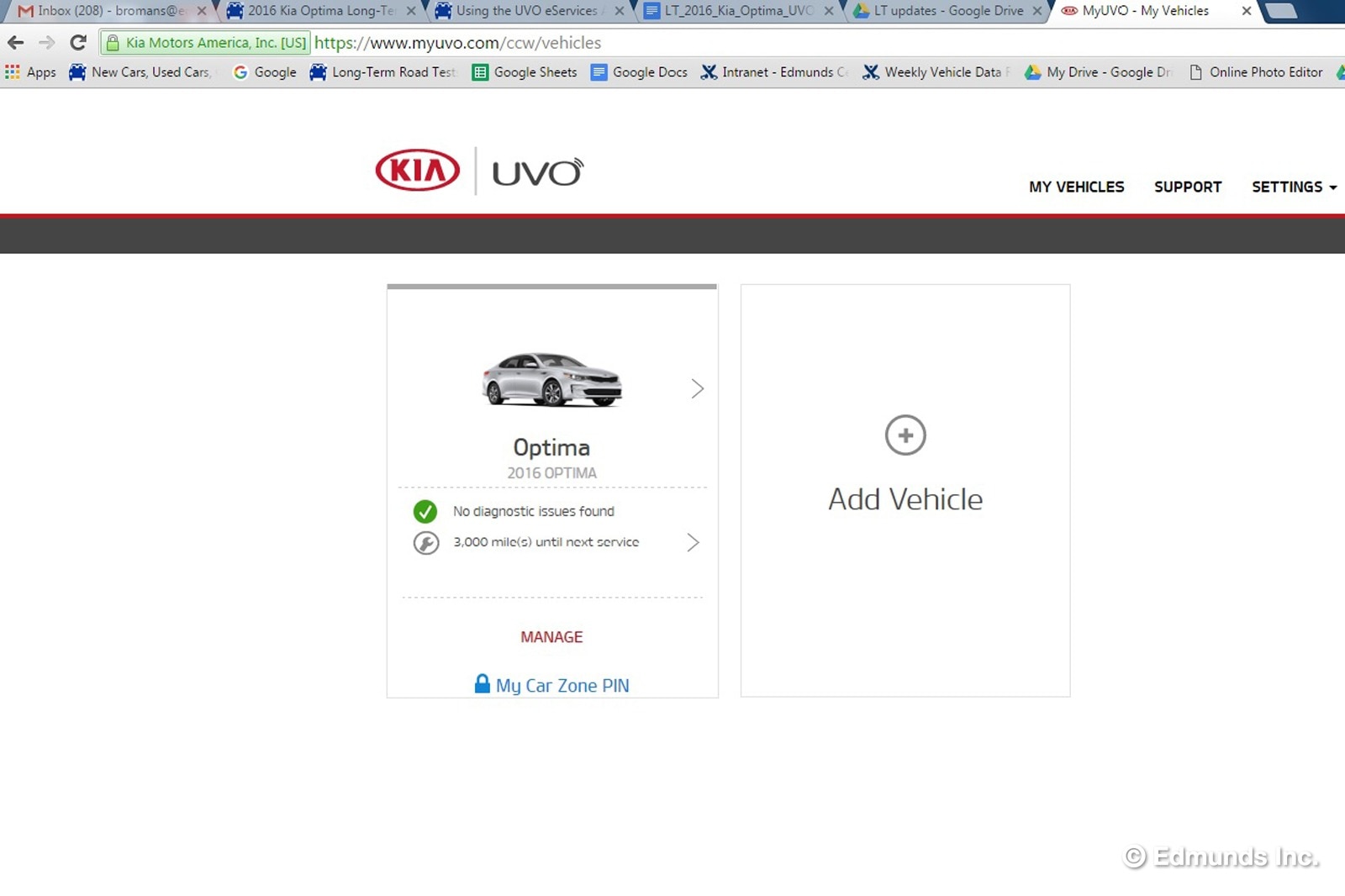
Registration is pretty easy as long as you have your vehicle's VIN ready. But you have to do this first before you can use the smartphone app. Once you've done that, you connect your phone to your car (I used a USB cable) and UVO should be up and running.
You can use most of these UVO functions either in the vehicle or on the smartphone app. On my iPhone, I ran the diagnostic report for our Optima. All the report told me was "no diagnostic issues found." No news is good news, then. The maintenance report indicated that we had yet to have service, which is true. So far, so good.
The POI function is trickier to use, but if you have saved locations or POIs in Google Maps (either the website or the app, I believe), you can forward those locations to the car and then use the car's navigation system to get you there.
Then there are the "Parking Minder" and "My Car Zone" functions. Parking Minder helps you locate your Optima via a map. The idea here is that you parked it somewhere and now you can't remember where. Presumably, Kia is thinking you parked at a giant airport parking lot, though conceivably it could also be a situation where you partied super hard on Friday night and now it's Saturday morning and you have no idea where you left your car.
My Car Zone could be useful if you have teenage drivers. It allows you to create custom alerts for time, speed and location. If your young driver is out borrowing your Optima, you can get notifications if he/she stays out late, exceeds a set speed, or ventures outside of a predetermined radius you set up.
I planned on reporting on how well My Car Zone worked in this update but I encountered difficulty getting the alerts set up. I'll just cover them in a subsequent update once I've got more experience with it.
Fuel Economy Update for May - Still On an Upswing

May was an uneventful month for our long-term 2016 Kia Optima. We amassed about 1,200 miles by primarily commuting to the Edmunds.com offices. But even without any major road trip mileage, we recorded another month of positive gain in our Optima's lifetime fuel economy.
For the month, we averaged 29.1 mpg. This helped boost our lifetime average to 29.4 mpg, a rise from 28.8 mpg last month. We're still below what the EPA says to expect for combined driving (32 mpg) but historically most of our long-term test vehicles have ended up with averages a couple mpg below EPA combined.
We were worried early in our test on about our Optima's underperforming averages, but I think those concerns can now be put to rest.
Average Lifetime MPG: 29.4
Best Fill MPG: 39.9
Worst Fill MPG: 22.6
EPA MPG Rating: 32 combined (28 city/39 highway)
Best Range: 574.7 miles
Current Odometer: 6,413
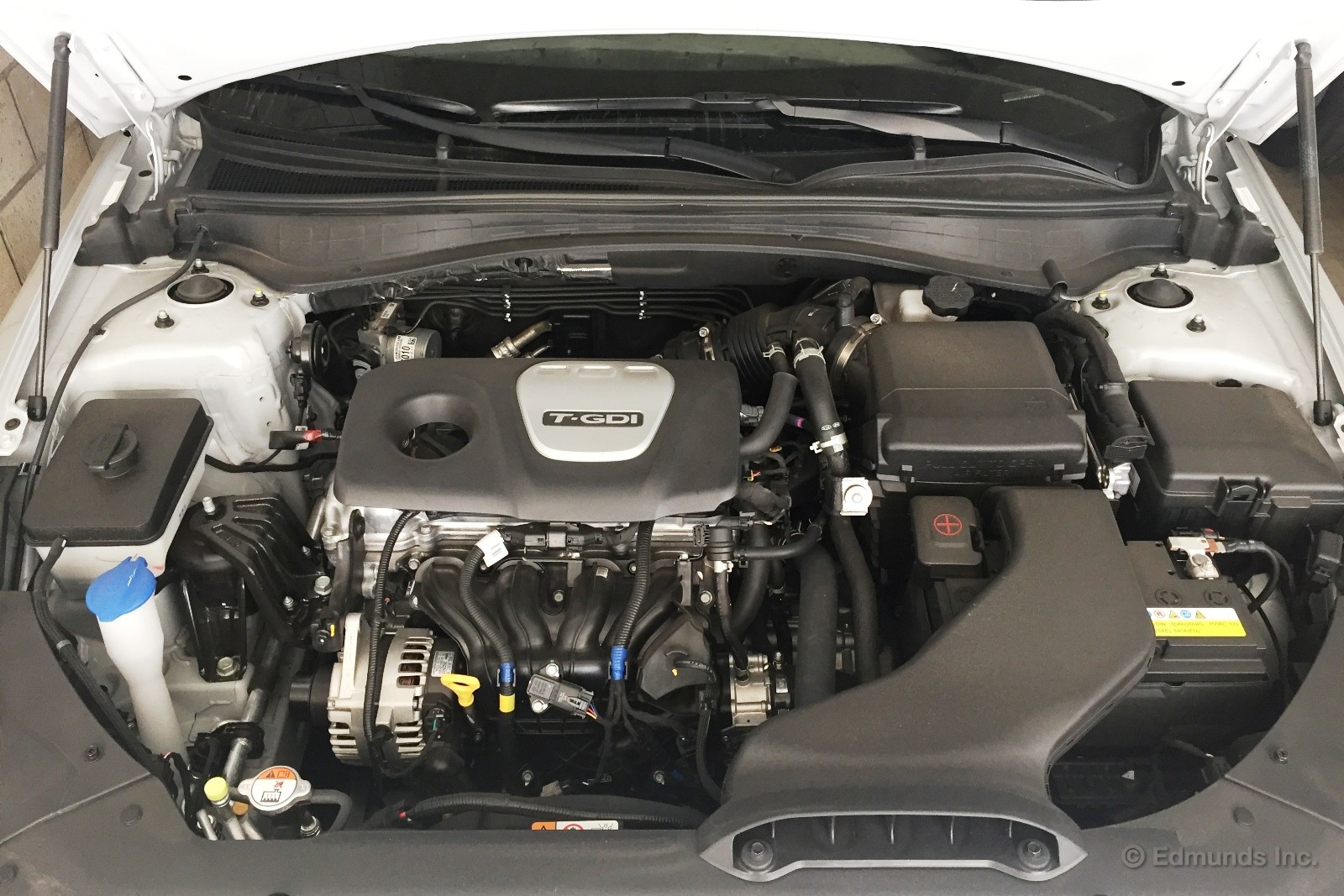
Is a nitpick a thing? If not, I'm making it one, and I've got two of them to put on our 2016 Kia Optima's record.
One has to do with the engine, the other with the transmission. Add them up and you might have enough nitpicks to make a shopper think twice.
Let's start with the engine, because I like engines. Ed's right about its "useful power." Brent's right that it makes the Optima "pleasingly quick." But here's where I'm right: the thing emits an unrefined booming noise at higher RPM that makes it sound like a vacuum cleaner. Sure, it's yanking the car along nicely, but there's a reason people wear earplugs when they vacuum. Who wants to listen to that?
If you're looking for a little turbo engine in this price range that sounds good, try our Civic's spunky 1.5-liter mill, or the 1.8-liter turbo in various VW products. Those engines make some pleasant mechanical noises as they rip toward redline. Kia's 1.6-liter lump has yet to find its voice.
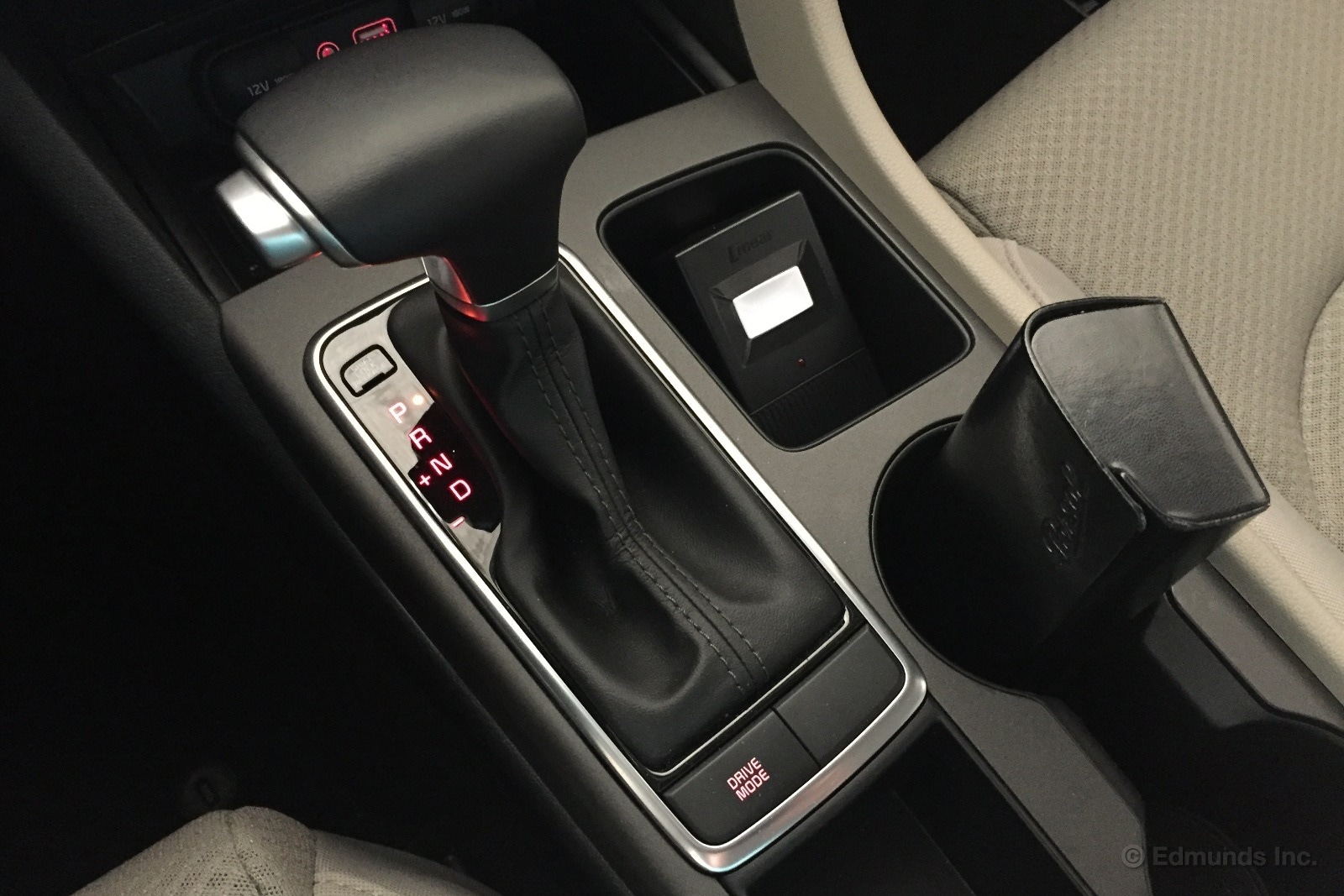
Now for the transmission. It's an automated manual, which means a computer is doing the clutching. Whenever I parallel-park the Optima, I find myself wishing the in-gear "creep" were more intuitive. Compared to a regular automatic, the computer needs an extra couple beats to engage and start creeping once you take your foot off the brake. Also, I find that the power comes on a bit unpredictably when it finally arrives, so it's hard to creep with precision.
If you drive stick, you know that parallel-parking with a manual involves a lot of variable clutch- and gas-pedal modulation. I'd even say there's an art to it. That's a tall order for any computer, so I'm not just blaming Kia here; it's a common issue with automated manuals. Still, the experience represents a noticeable downgrade if you're used to a "normal" automatic transmission.
That could be one nitpick too many for some.
Using UVO Speed Alerts and Geofencing To Find Out How Your Teenagers Are Driving
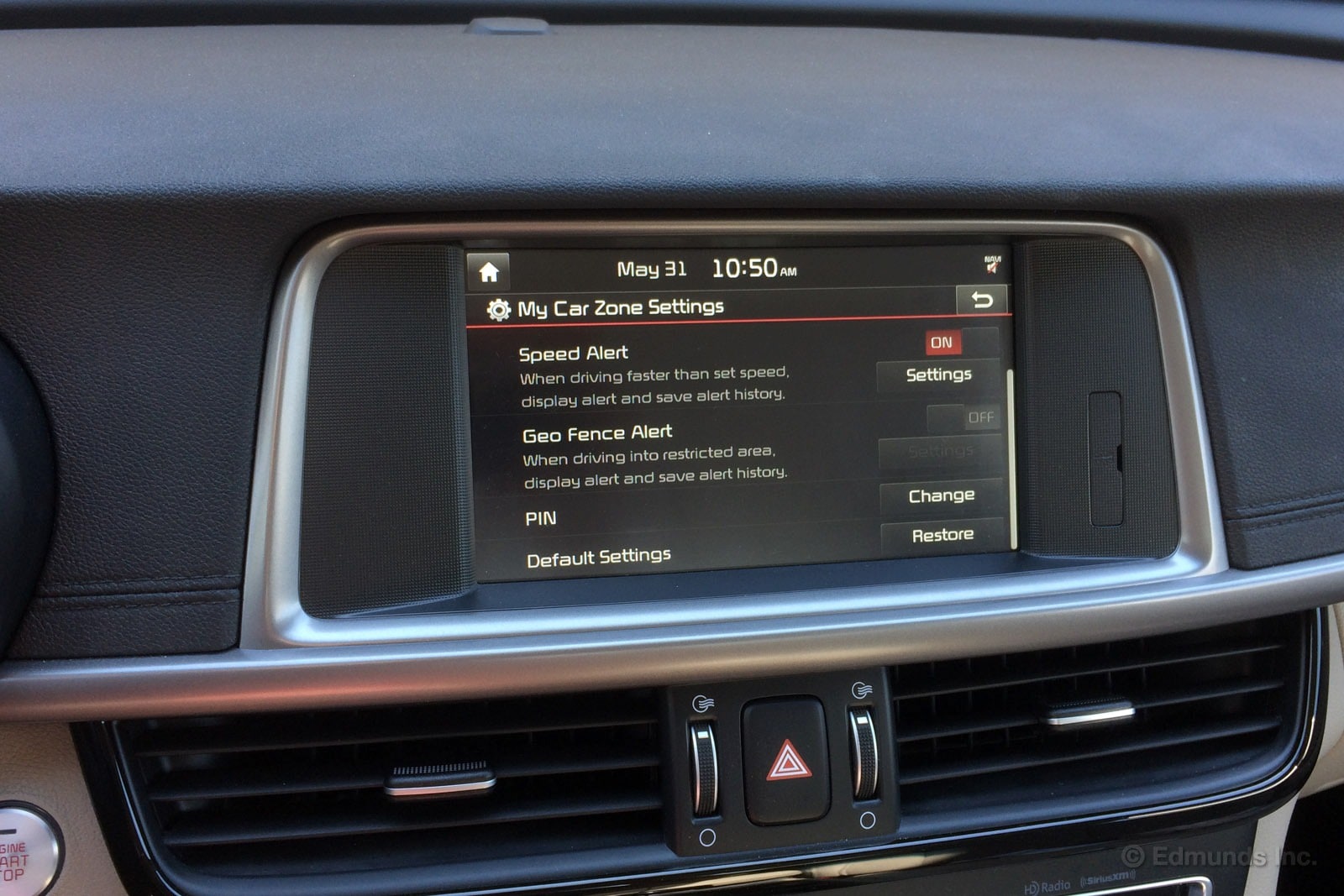
About a week ago, I wrote an update about the extra features contained within our 2016 Kia Optima's UVO eServices infotainment system. At the time, I couldn't quite figure out how to get the My Car Zone feature working. This is the part of UVO that allows you to create custom alerts for time, speed and location ("geofencing") if your Optima is being borrowed by your young driver. Or your boyfriend/girlfriend/spouse, I suppose, if you don't trust him/her.
Well, I've since figured out how to get it to work through the car's UVO setup menu. Now it's just a matter of testing it out. I do have kids, but they're far from reaching driving age. Next best thing: me.
I set up alerts for a radius from my house and speed. I picked 60 mph, since that seemed like an easy speed to exceed.
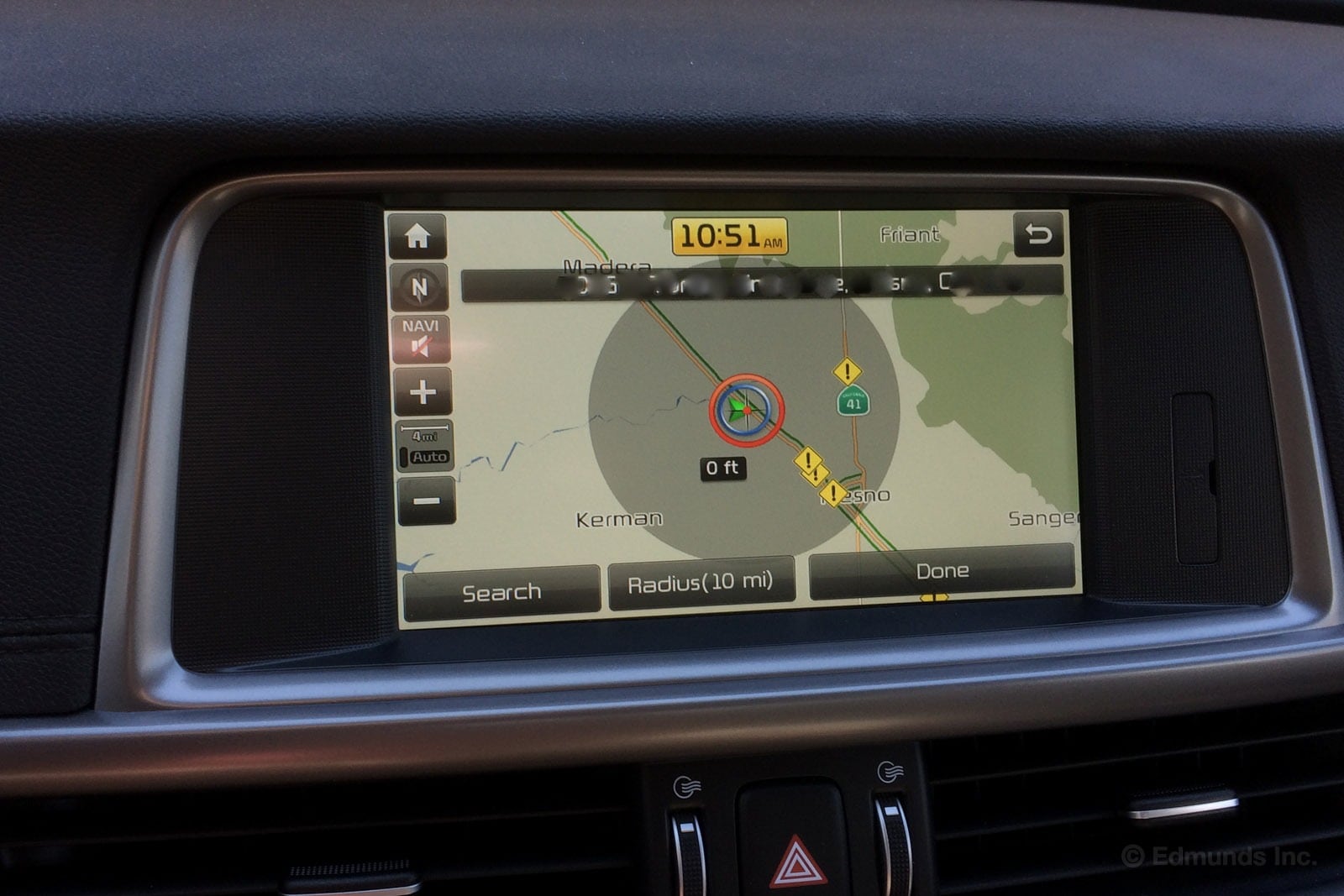
You can further customize these alerts for how frequently they get triggered (say, one alert a minute for the period of time that the vehicle is exceeding your preset speed). These must be set up while the vehicle is parked. A four-digit PIN that you select protects these settings from being changed or disabled.
Short version: it worked. Once I sailed past the geofence distance, a notification popped on the touchscreen. And when I hit the gas on the highway a couple times to pass some slow-moving trucks, the Optima gave me a speed warning, too.
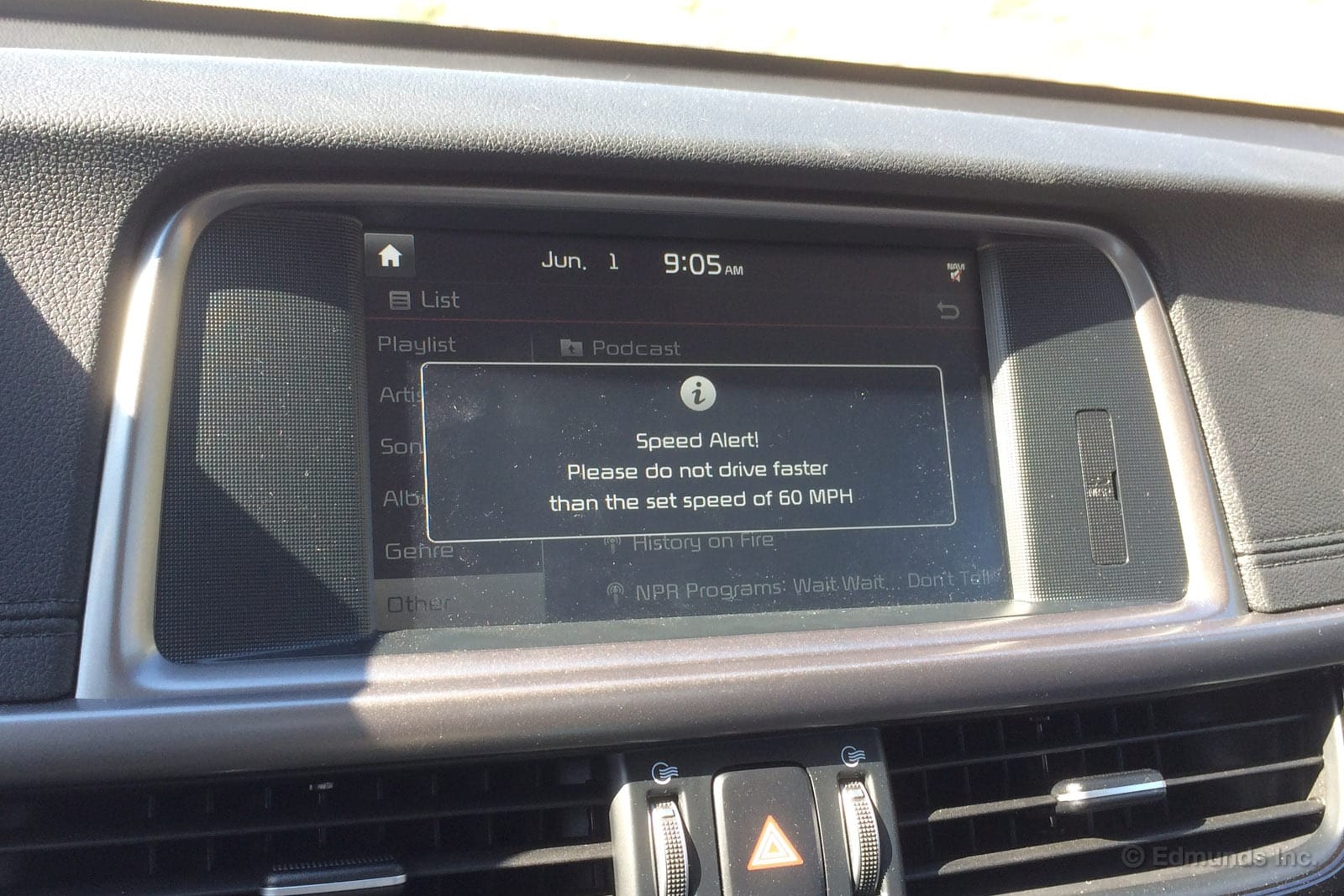
These alerts are stored in the system. So if you let your teenaged driver have your Optima for the night, you can see if he or she exceeded any of your parameters.
I also thought that I would get notifications on the UVO app on my phone automatically. That way, you could be sitting at home and get a push notification that your son Jack is on his way to Vegas at 100 mph. But that doesn't seem to be the case. The only way I could get them to appear in the app was after I had connected my phone to the vehicle itself and transferred data to it. This is less than ideal if the Optima is actually Jack's car and you want to keep an eye on him, rather than Jack borrowing your Optima.
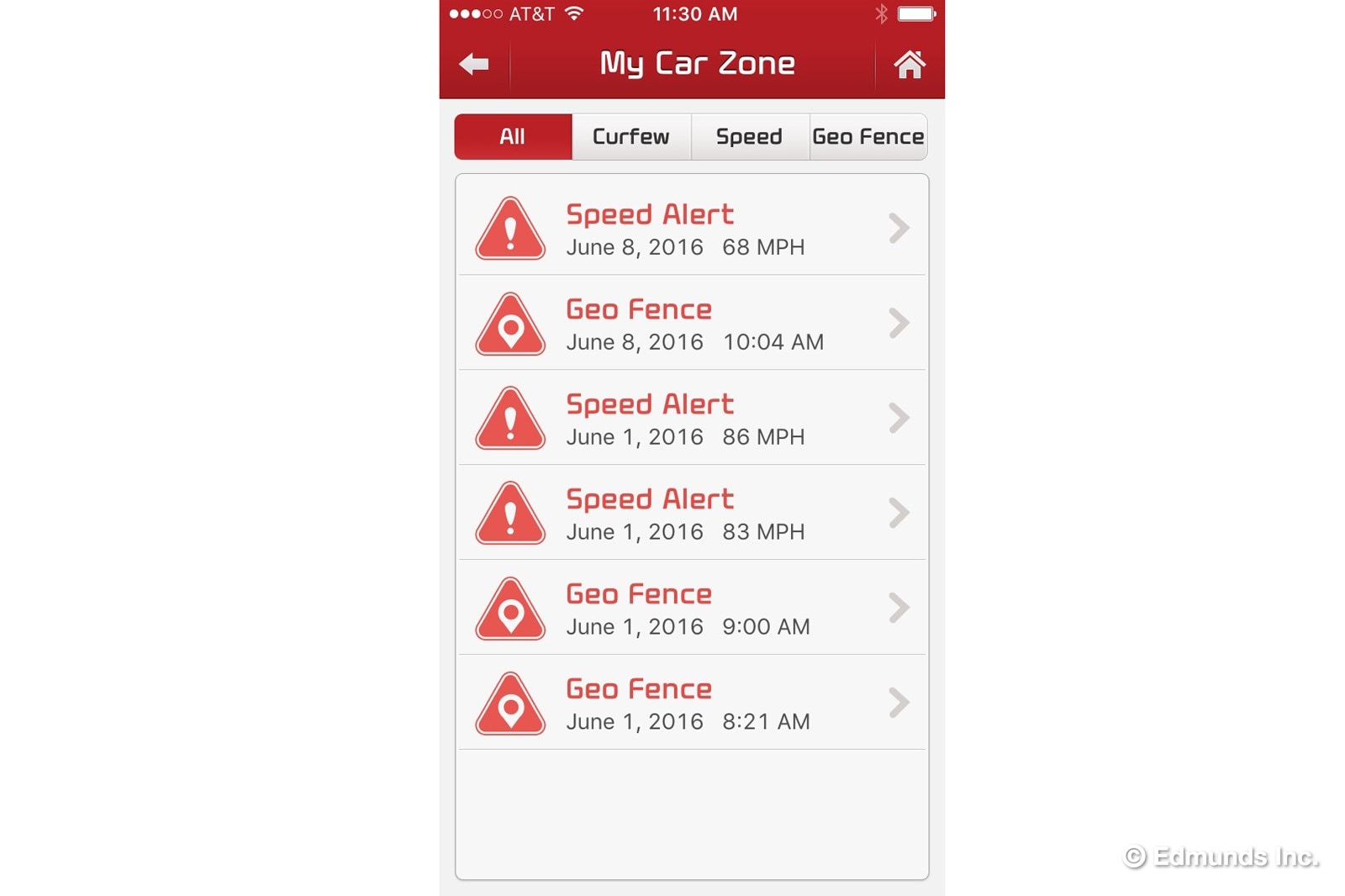
Overall, though, I'd say it's a nice extra feature to have. And, as a commenter pointed out in my previous update, all UVO services are free for the first 10 years or 100,000 miles.
When your teen driver is done driving, though, you'll have to remember to turn off the alerts. I mention this as I forgot to do this for my coworkers. I had set our Optima's UVO speed limit warning to 40 mph for further testing but then forgot to disable it. Well, later that day, I got a call from co-worker Kelly Hellwig. She was driving the Optima home from the Edmunds office and had just seen an unexpected speed warning. The amusing aspect (for this story, not for Kelly) is that she had been driving for an hour and 45 minutes already through the oh-so-common Los Angeles traffic morass. It had taken her that long to finally top 40 mph.
"It's not a warning," Kelly said. "The Optima is mocking me that this has been my best speed so far."
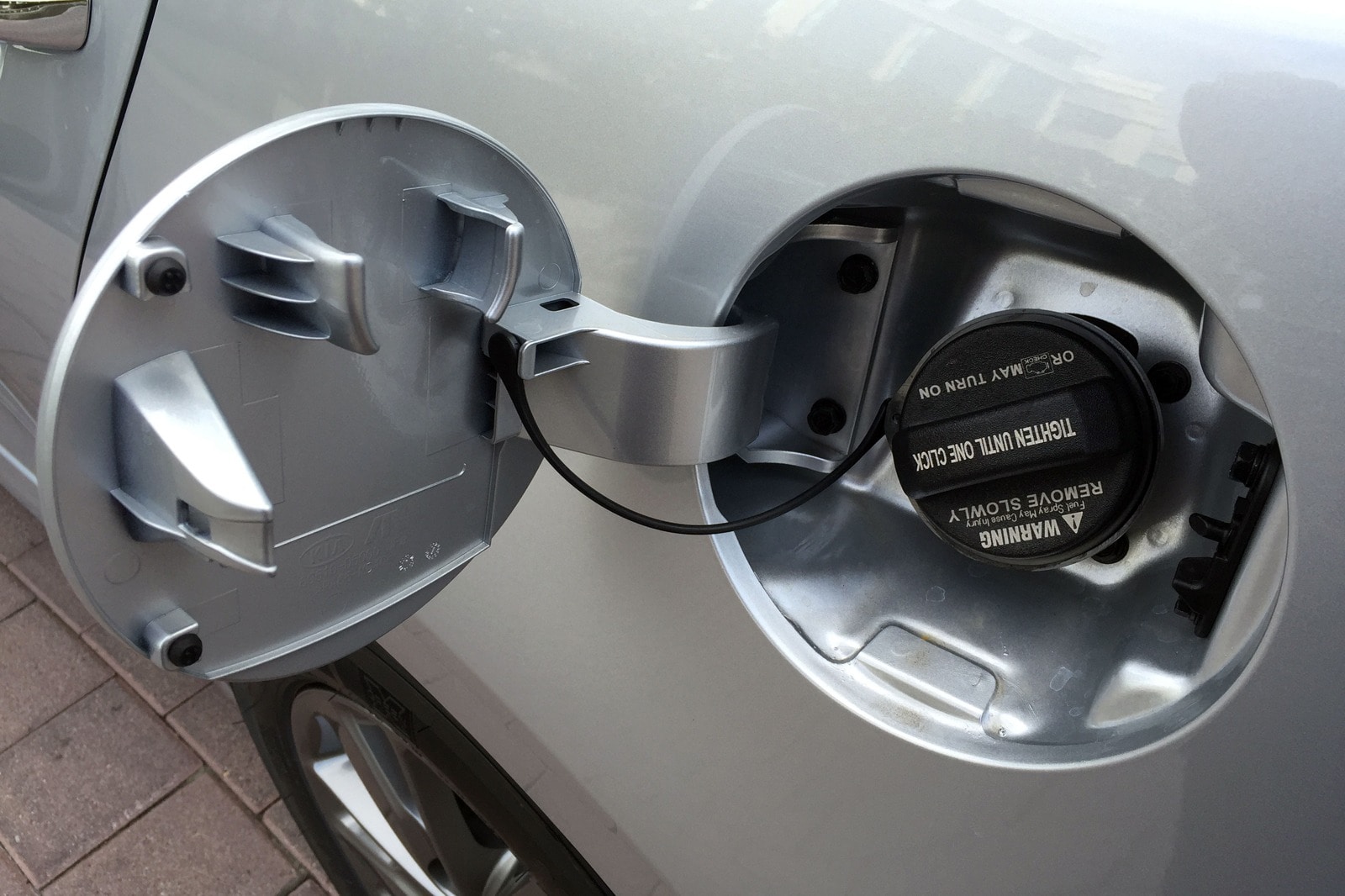
For the second month in a row our 2016 Kia Optima failed to reach our goal of 1,700 miles. It covered 1,200 in May and 1,500 in June. The sedan worked its way into the favor of editors living near the office and settled into the city life as a result.
One obvious downside to this trend is that the lack of mileage means less data. That extends the amount of time until we reach the Kia's combined mpg sweet spot. But there is an upside. Despite being relegated to local streets, overall fuel economy increased for the second month in a row.
It wasn't much. Still the overall increased from 29.4 mpg last month to 29.8 this month. A string of low-to-mid 30 mpg fill-ups accounted for the uptick.
Average Lifetime MPG: 29.8
Best Fill MPG: 39.9
Worst Fill MPG: 22.6
EPA MPG Rating: 32 combined (28 city/39 highway)
Best Range: 574.7 miles
Current Odometer: 7,950
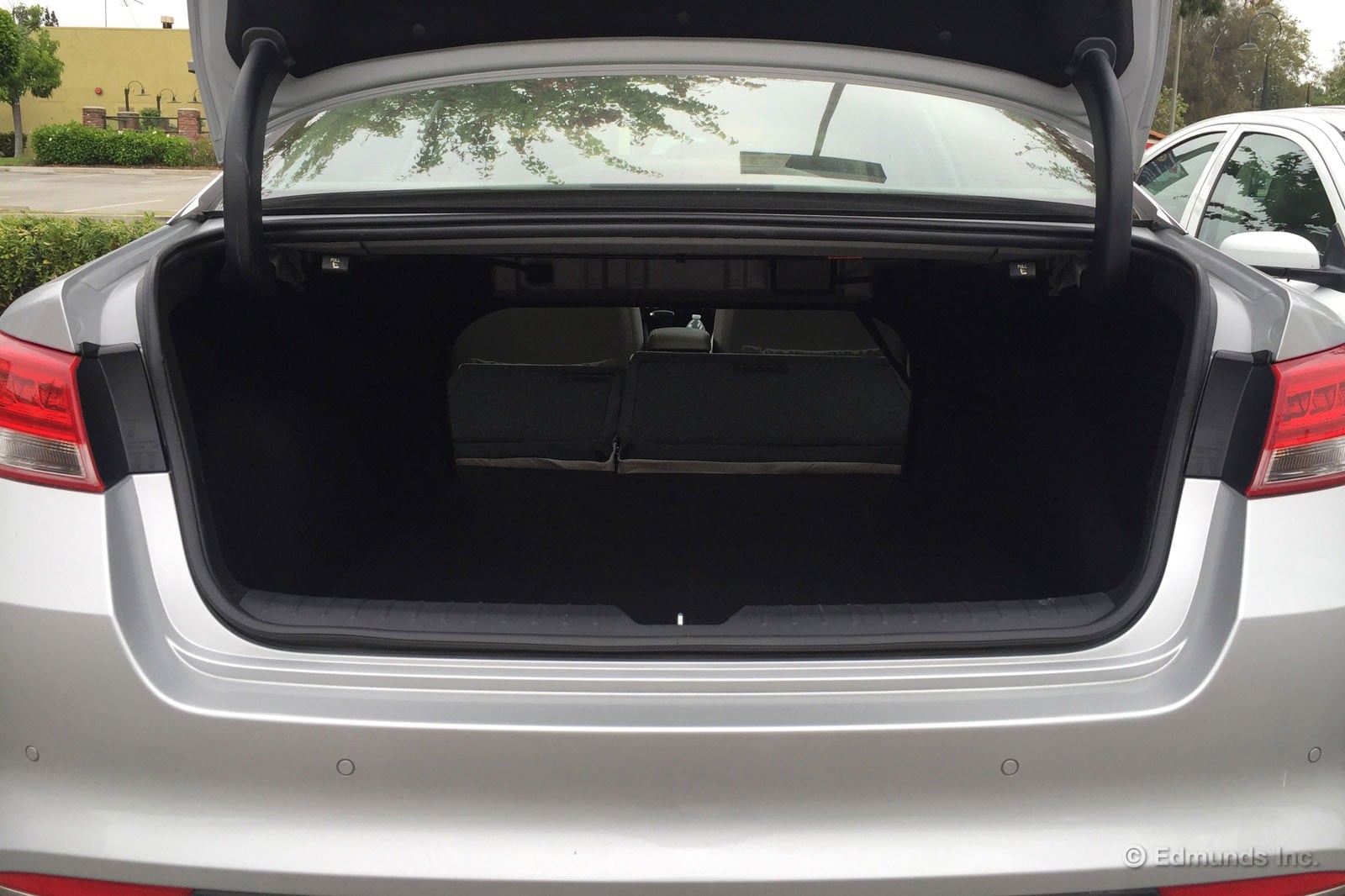
Will the luggage fit? To answer this question we loaded (our 2016 Kia Optima) with bags in different configurations and took photos. What constitutes carry-on luggage varies depending upon who you ask. So for the sake of standardization we used the same blue carry-on bag — size (21 x15x10 inches) and red checked bag — size (30x20x13 inches).
Take the jump for photos and more detail...
Access to the cargo area
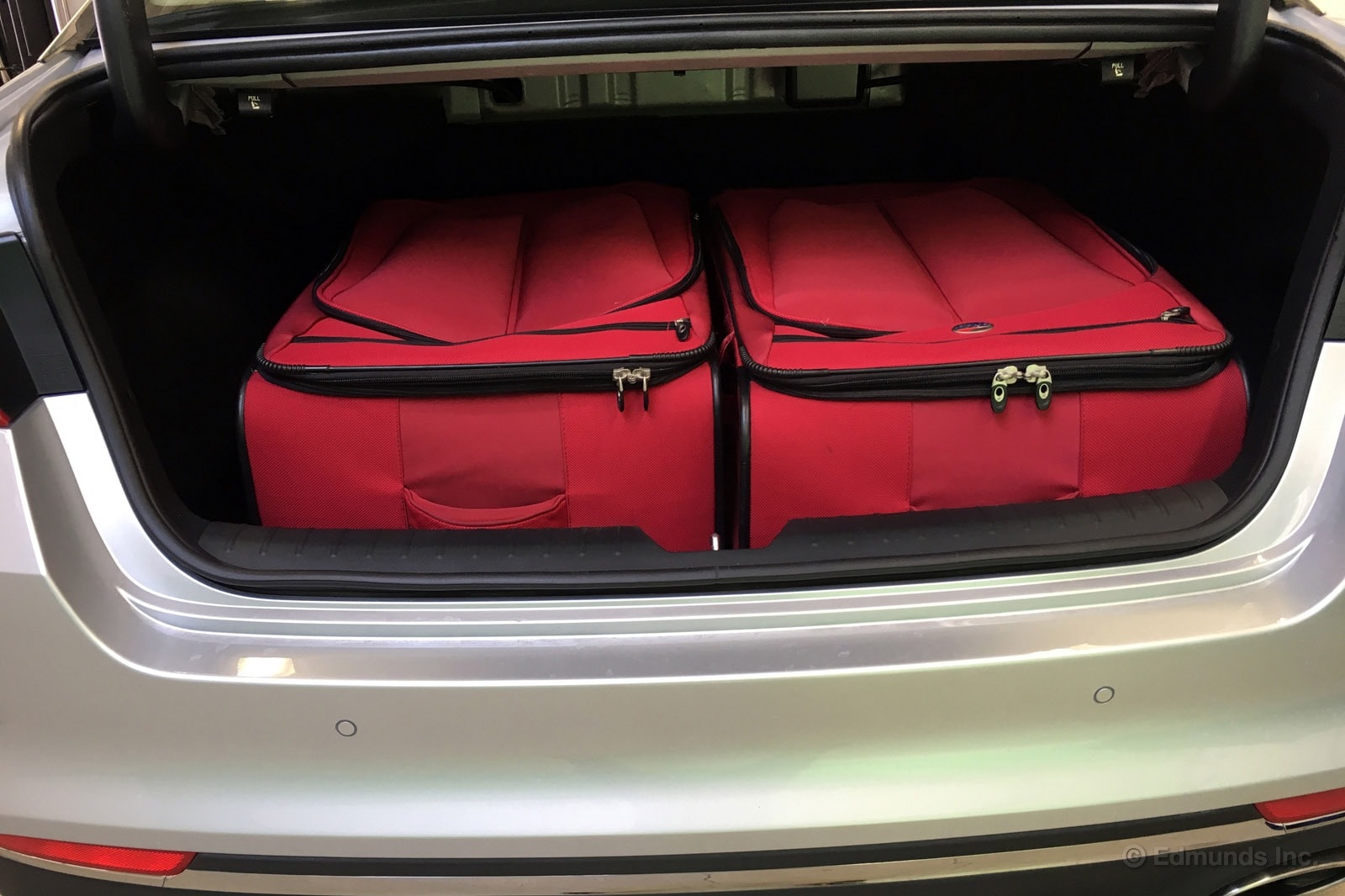


The shape of the trunk opening is common in this segment. It is plenty wide but larger items require some manipulation to get inside. The trunk floor is 43 inches wide at the wheel wells and 39 inches deep to the second-row seatback.
It is important to note the trunk lid hinges. They lower into the storage space. As evidenced by the scuffs we have on the driver side hinge, they will crush cargo if you don't pack carefully.
Cargo loading height, or the lowest point of access to the trunk, is 28 inches from the ground. When fully open the trunk handle is 63 inches from the ground.
Behind the first row
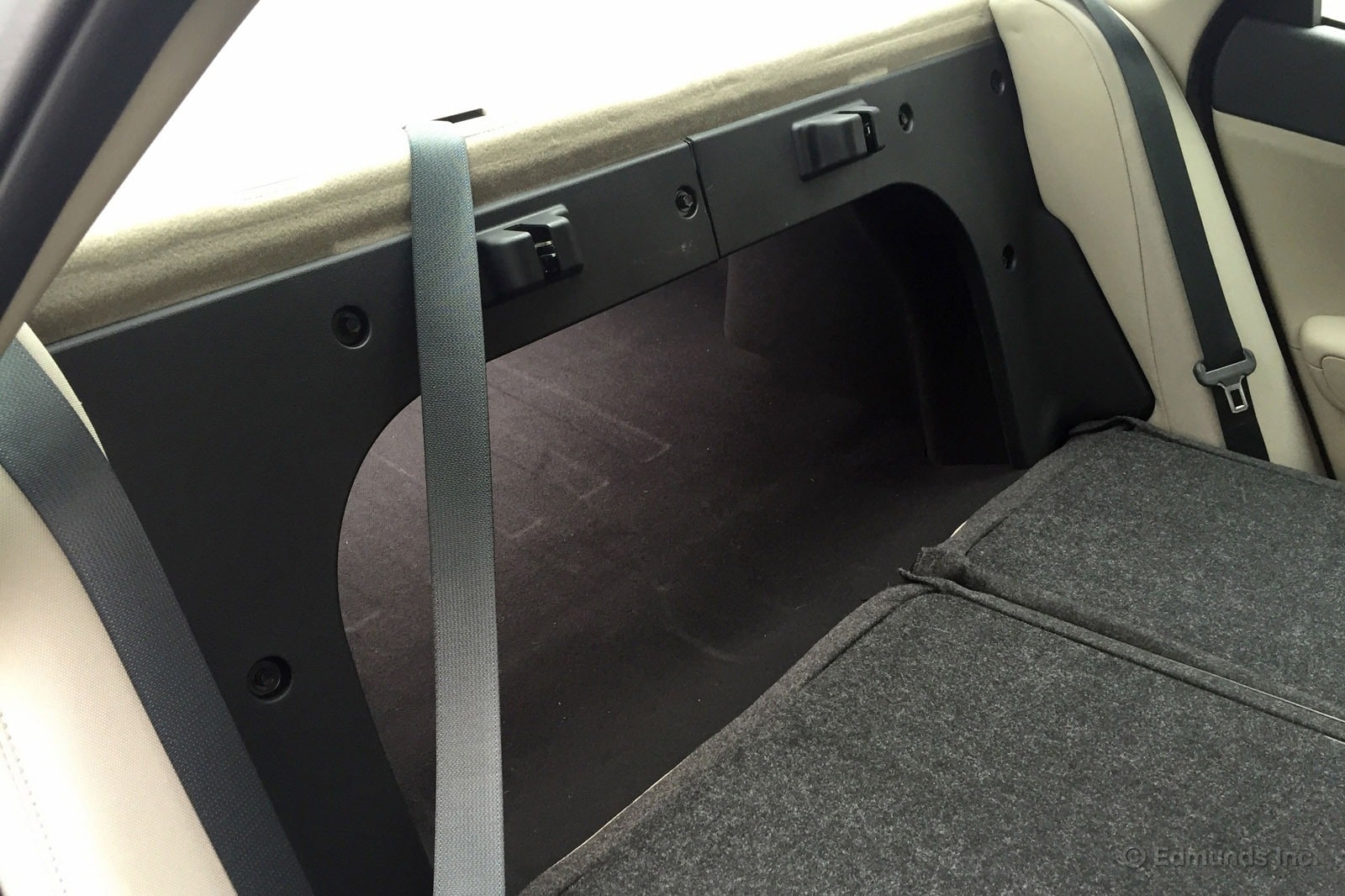

With the second-row seats folded the Optima's load floor grows to 71 inches. The pass-through between compartments is nicely shaped to enhance usability. Its second-row seatbacks split 60/40 and fold flat.
Find other cargo specs here.

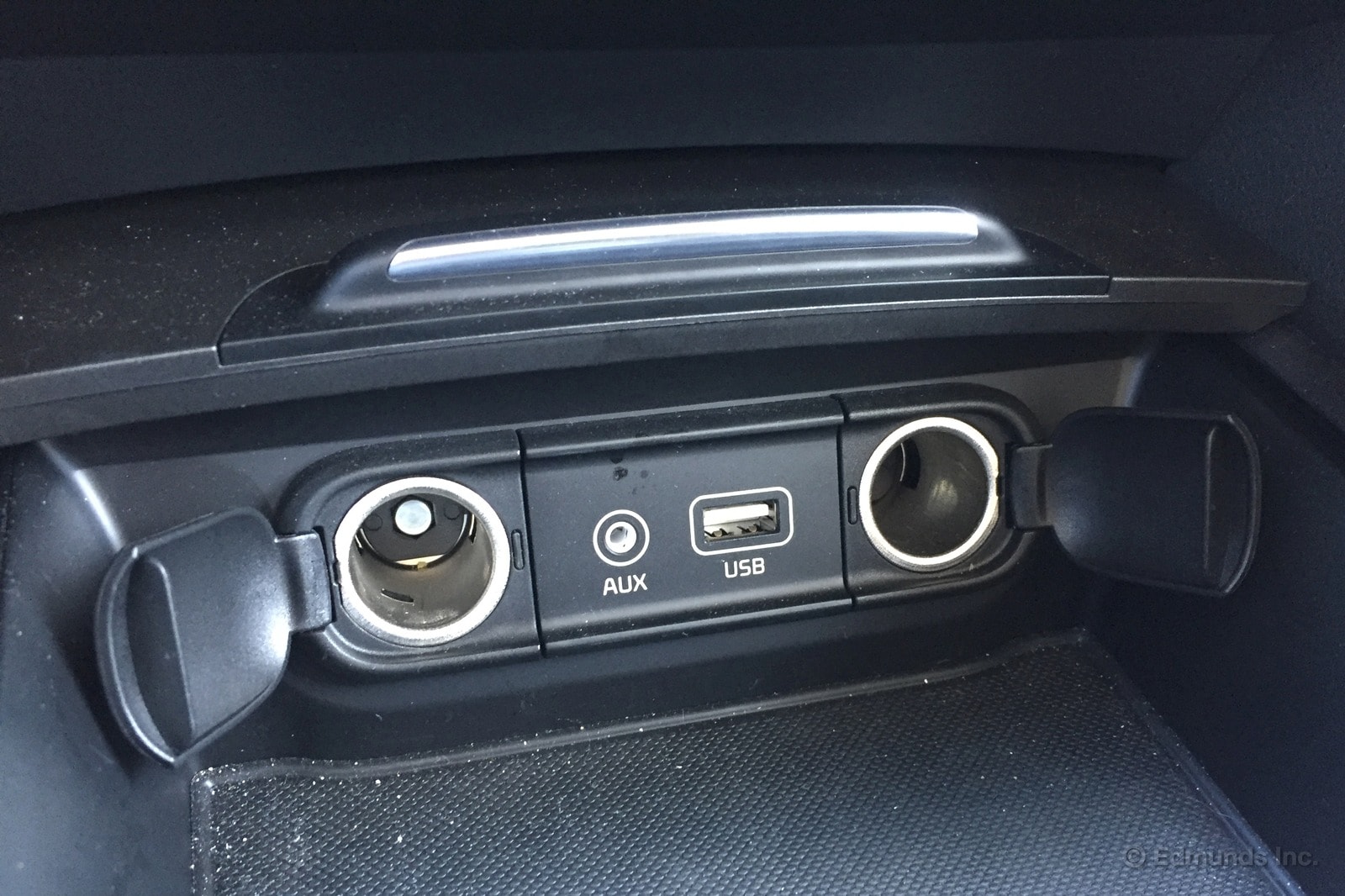
Our 2016 Kia Optima may just be the ultimate family sedan. It has a roomy cabin, a sizable trunk and plenty of storage space for small items. Further adding to the passenger-friendly atmosphere is the abundance of power ports placed throughout the cabin. You'll never again have friends fighting over whose phone to charge first.
There are a total of six places to power or charge electronic devices in a vehicle that seats five. Just below the center stack is a small covered tray with two 12-volt outlets and a USB port (pictured above). There's also a charge-only USB port under the central armrest...
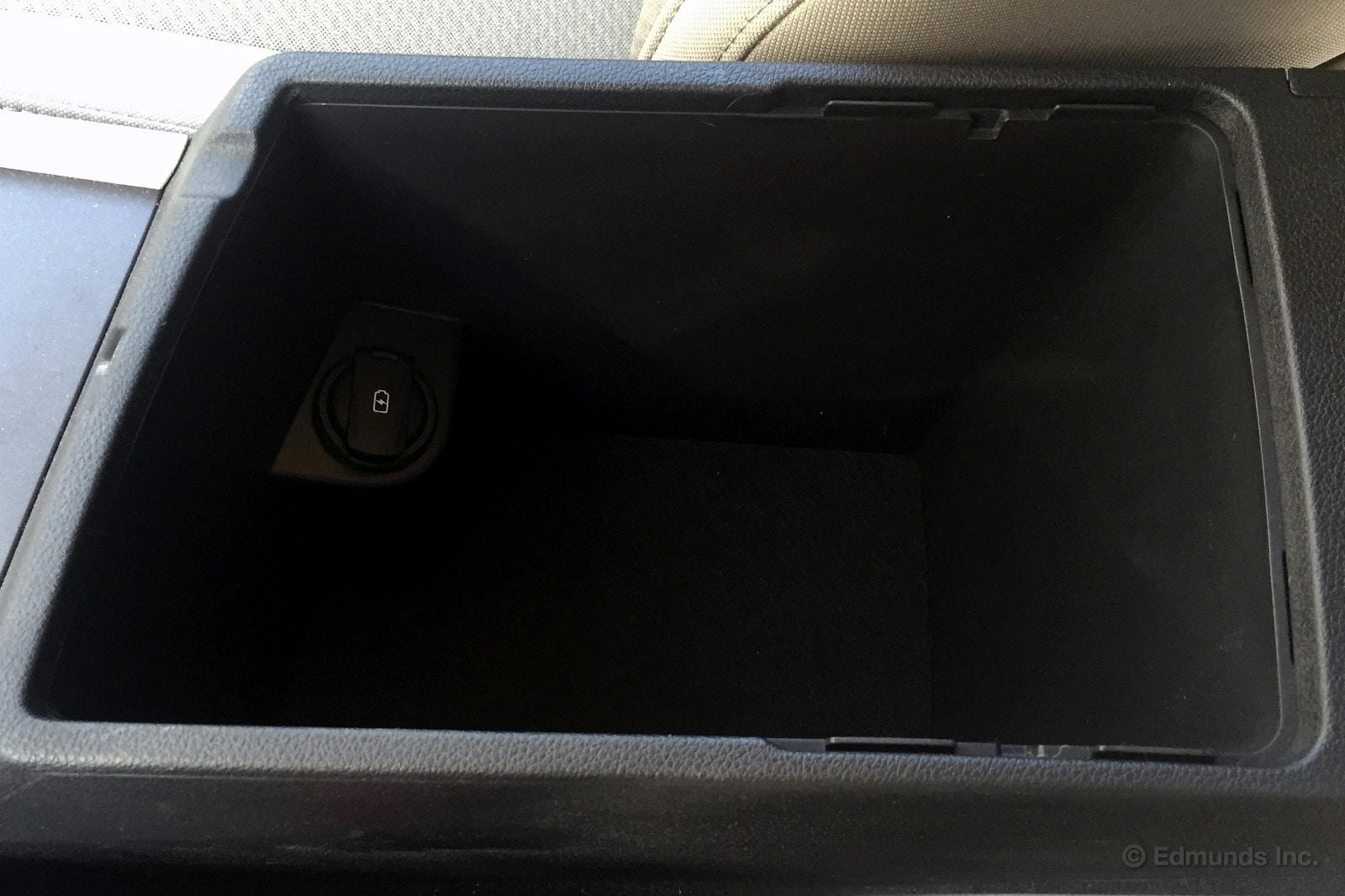
...while backseat passengers get another 12-volt outlet and a charge-only USB port located on the back of the center console:

I appreciate the thought Kia has put into ensuring that everyone has a way to charge up. Still, I've spent a lot of time in minivans, three-row SUVs and sedans completely filled with family and friends, and I don't think more than two passengers have ever needed to charge their phones at the same time. Sound off in the comments, I'm interested to see if others think six outlets seem like overkill.
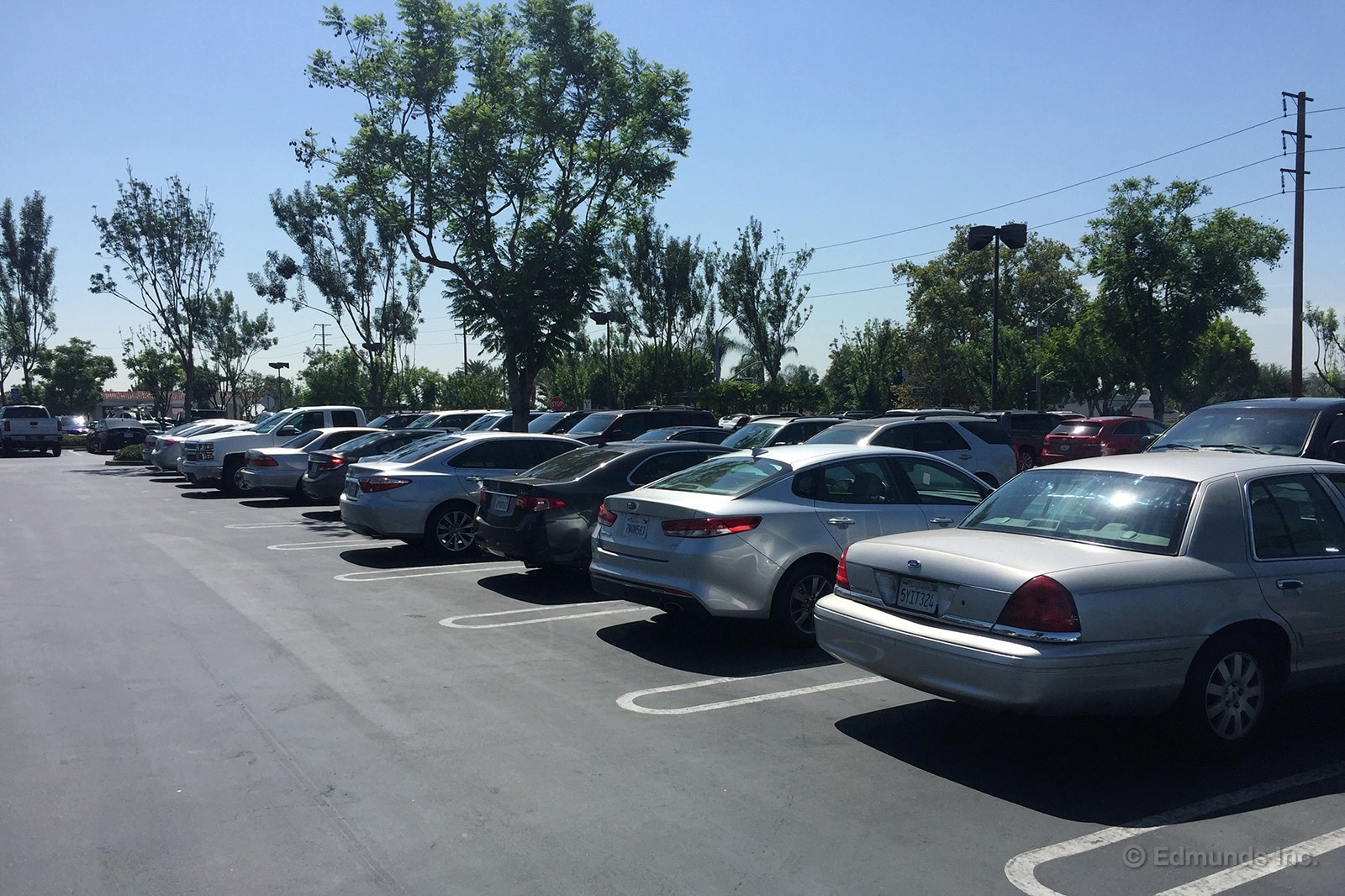
It's safe to say that the 2011 Kia Optima helped transform Kia's image from a me-too automaker to a company that produces vehicles Americans want to own. This was largely due to sharp bodywork shaped by ex-Audi designer Peter Schreyer. But despite Kia's supposed anti-beige philosophy, I think the redesigned 2016 Kia Optima takes a step backward to safer territory, at least in our tester's featureless LX trim and nondescript Sparkling Silver paint.
One of the primary reasons we added an Optima to our long-term fleet was to sample the turbocharged 1.6-liter engine and dual-clutch transmission. This powertrain is only available on the LX level, which is the base trim for the Optima. It looks decidedly different from the SX Limited featured in Kia's commercial. You don't get the chrome accents on the front fascia and door sills, dual exhaust tips, LED taillights, rear lip spoiler or (non-functional) ground effects.
With all these little details absent, the Optima looks very plain, especially in silver. As I write this, I've been driving the Optima for the better part of three weeks. One week in, my girlfriend asked what I was driving. "The Optima," I replied. "You've been in it for a week." She scrunched up her face as she tried to conjure an image. "I honestly don't remember what it looks like."
During that span I also accidently attempted to enter a silver Hyundai Sonata one morning after I got coffee at a local Starbucks. On another occasion, we wasted a few minutes wandering the Costco parking lot as we tried to pick it out of the crowd. A few days later, I asked my mother to find the Optima in a mall parking lot. She correctly identified it, but not because it's distinctive. "I knew the truck parked facing us was partially in our spot, so I figured our car was the one sticking out further than the rest."
Not exactly a car that Crazy Socks Walken would approve of, then.

When fleetmaster Mike Schmidt handed me the key to the 2016 Kia Optima, I didn't expect much. As the new Vehicle Testing Assistant, I was excited to drive my first car, but I've personally never been a fan of the brand based on friends who experienced multiple mechanical problems with their Kias years ago. But a night in the Optima made it clear that my head had been stuck in the sand.
Let me explain.
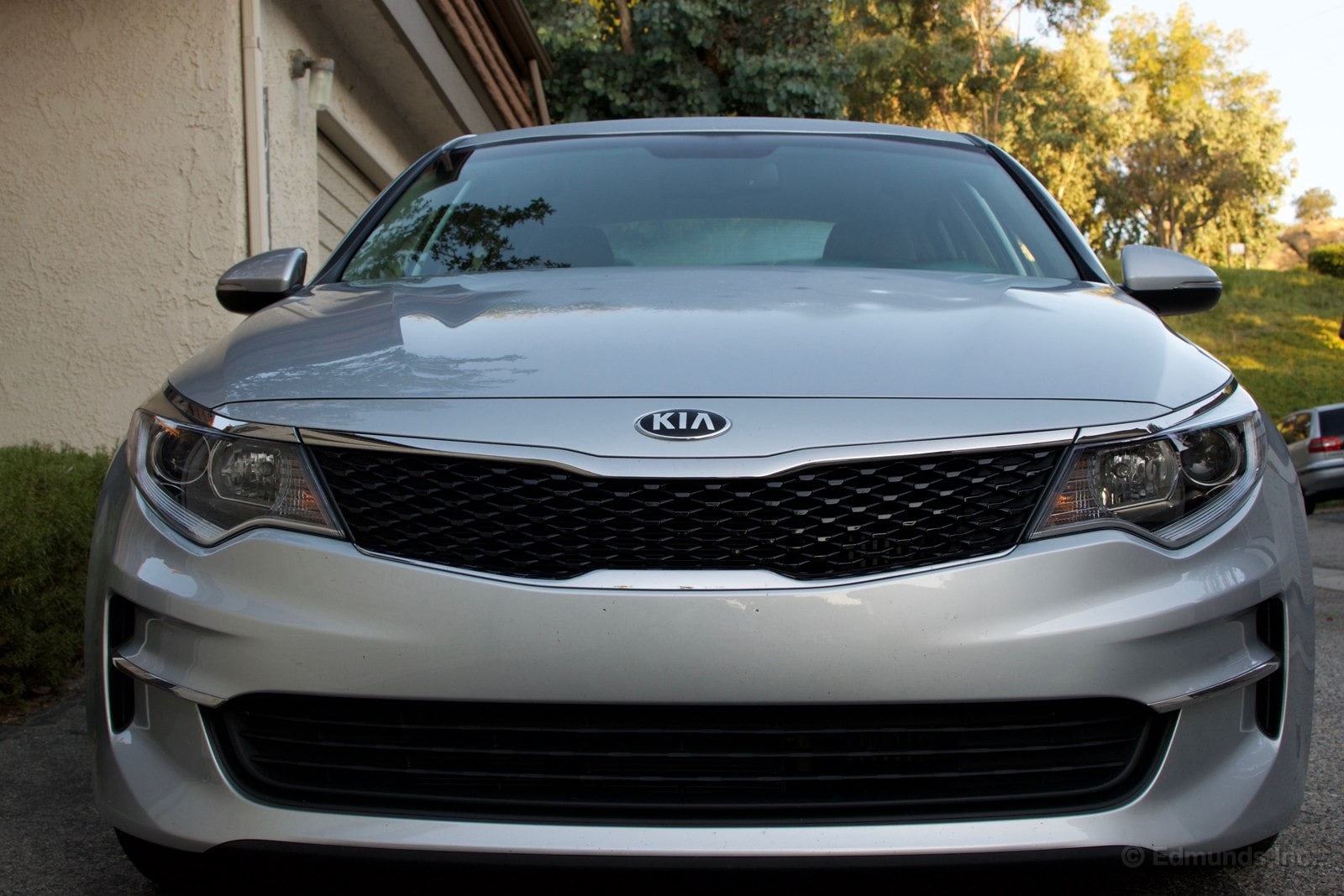
When I got down to the garage and found the Optima, I was confused. Its front end was fresh, and Cameron's criticisms notwithstanding, the car looked like it had a personality. I slid into the driver seat and was impressed by how well Kia designed everything. The infotainment was simple and intuitive. The seat was comfortable and easy to adjust to my preferences. The instrument cluster was satisfying and clean in appearance. It was hard to believe that I was in a Kia, but the logo on the steering wheel reminded me this was the case.
I put the seven-speed transmission into drive and meandered onto the traffic-laden streets of Santa Monica.
Stop-and-go traffic stretched up Pacific Coast Highway to Topanga Canyon. It was here that I noticed the first thing I didn't like. Under these conditions, the gas pedal didn't react how I expected. The car lagged and felt unresponsive. But when I was halfway home on the Woodland Hills side of Topanga Canyon, sitting at a red light, I remembered a helpful tip from one of our editors: Press the Sport Button.
Mashing the mode button revealed three apparent choices: Nothing (no indicator light), Eco and Sport. I selected Sport. The light turned green and I accelerated just like I did in Eco mode. What an impressive breath of life. A final nail in the coffin of my outdated opinions. I can confirm that this car behaves best in Sport mode. Press that button.
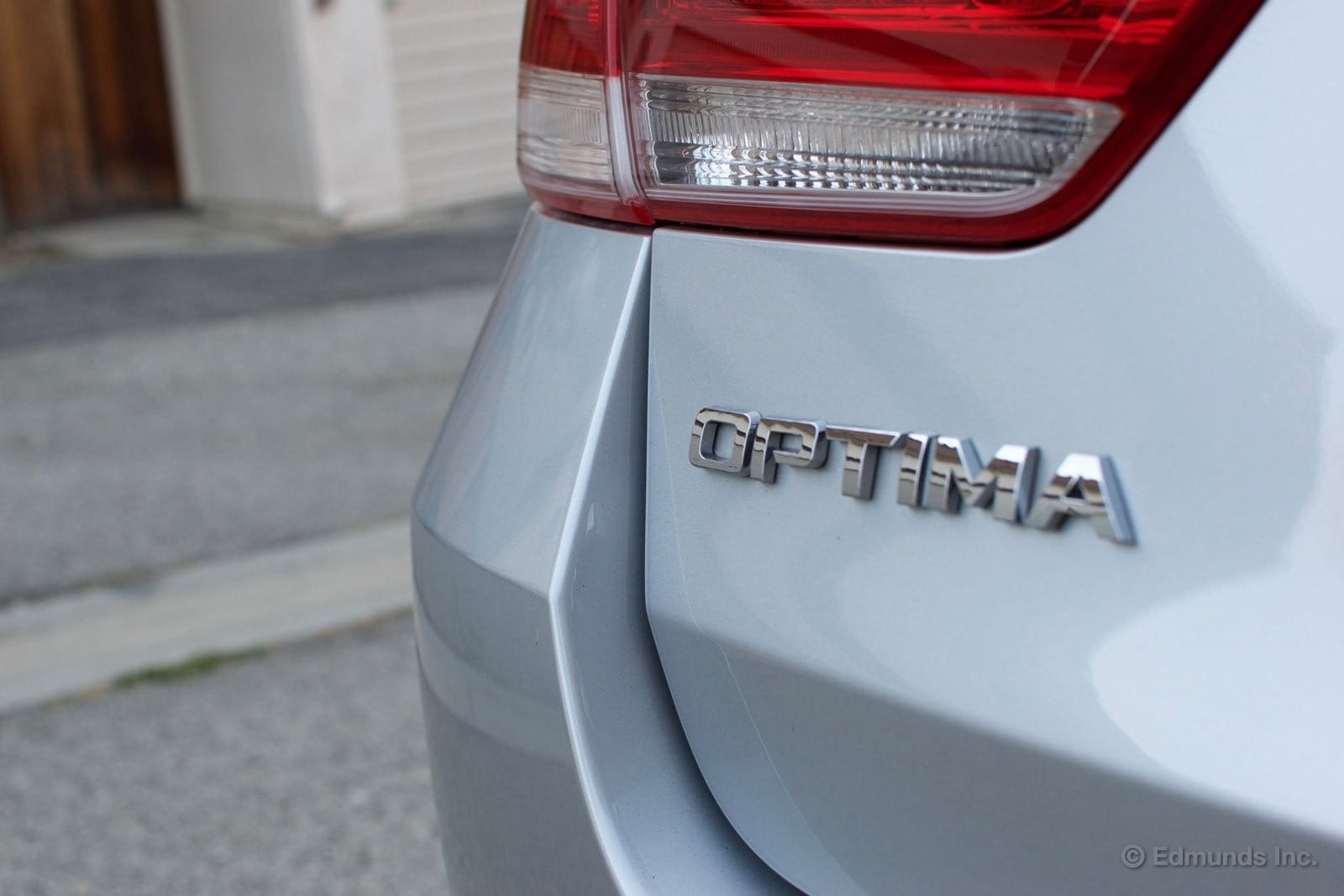
By the time I pulled into my driveway, I realized something. If I were in the market for a midsize sedan, this Kia Optima would be on my list. In a single drive, the Optima turned me into a solid believer in the brand and had me looking forward to driving other Kia products. While my head was buried, Kia positioned itself to compete with the big brands that used to hold a big lead.
July Fuel Economy Update - One Month Forward, Two Steps Back
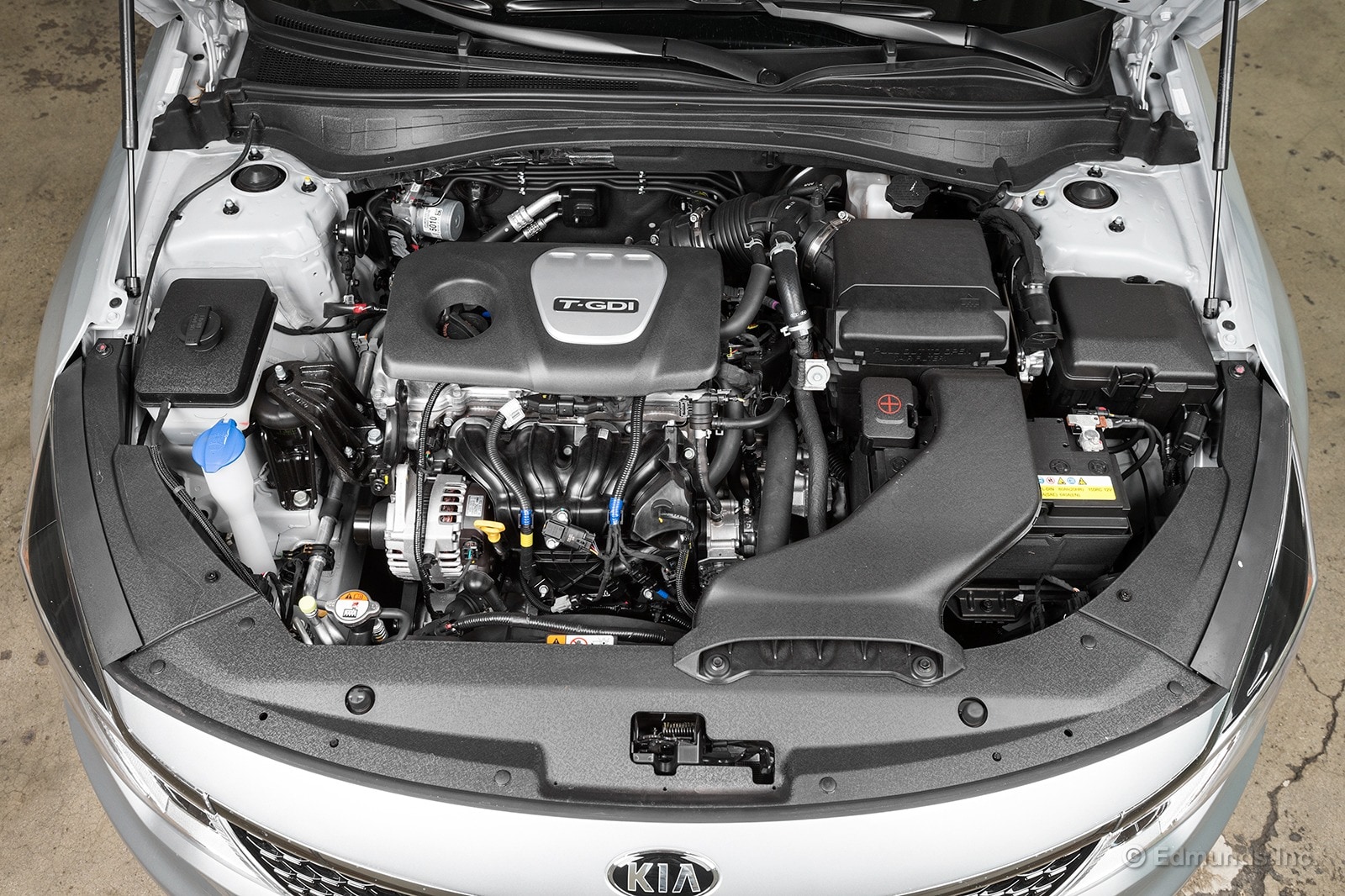
After a two-month upswing in average lifetime fuel economy, our 2016 Kia Optima slips a bit on the efficiency scale as we close out July. The overall numerical value is back to where it was in May — 29.4 mpg — which might seem at first like a negligible change from last month's 29.8 mpg.
However, with each additional month the number of data points grows, so it becomes increasingly difficult to move the needle toward the EPA combined estimate of 32 mpg. And this month we were definitely moving in the wrong direction.
Compared to last month, our Optima gave up nearly five mpg at an average of 27.8 mpg. This is the worst average since we introduced the car in February, back when we were subjecting the new arrival to performance evaluations and sending it out on photo shoots.
It remains to be seen whether this is the beginning of a trend or simply the result of a certain lead-footed editor having spent most of July in the car. Tune in next month for further analysis.
Average Lifetime MPG: 29.4
Best Fill MPG: 39.9
Worst Fill MPG: 22.6
EPA MPG Rating: 32 combined (28 city/39 highway)
Best Range: 574.7 miles
Current Odometer: 9,229
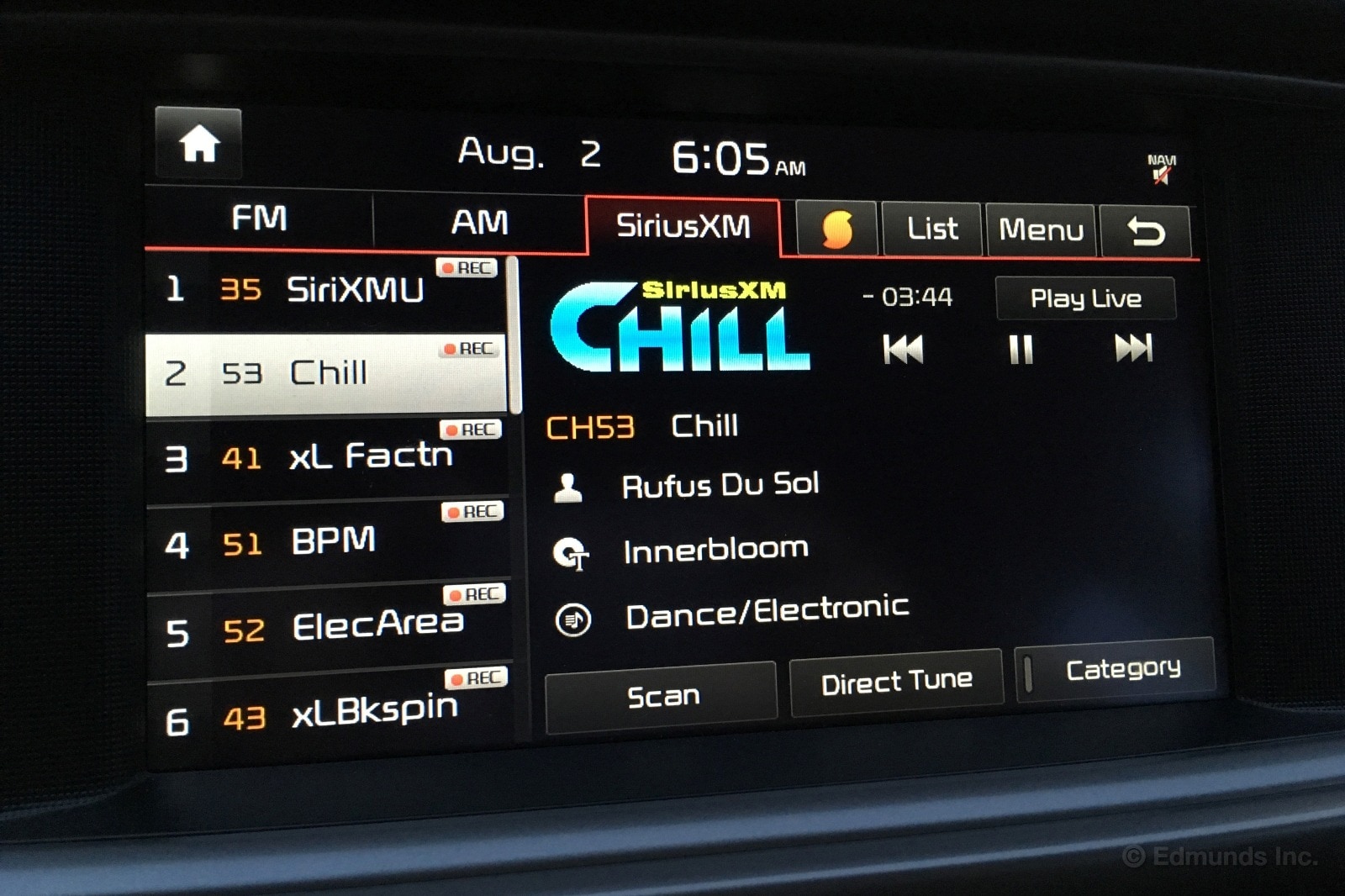
One thing we can't seem live without these days is the ability to pause, rewind or fast-forward whatever we're watching. That's true whether you're an avid consumer of cable network programming or an Amazon Prime and Netflix cord-cutter.
So why not incorporate said functionality into car audio systems? Our 2016 Kia Optima does just that.
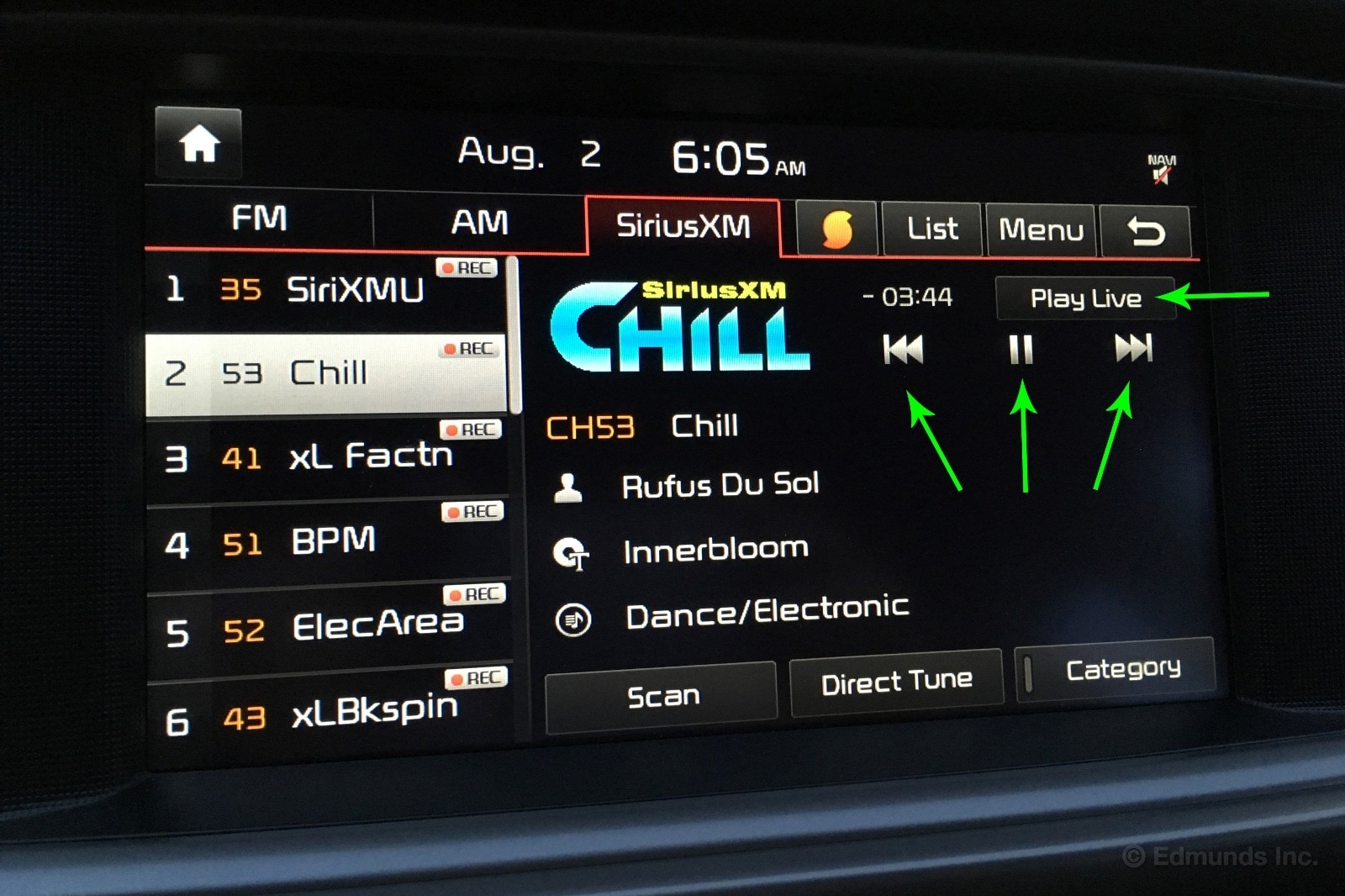
The Optima's receiver can replay the previous thirty minutes of a station, allowing you to catch a missed song or talk-show segment. Our Jeep Renegade has this ability as well, but it's not as obvious. If your vehicle came from the factory equipped with satellite radio, there's a chance that it can do this, too. But it's not guaranteed.
General Motors was among the first automakers to introduce a hard-drive-based audio system that could record live radio, including non-satellite stations. But with today's migration to streaming music and content, it's not clear if this feature has a future. Case in point: we just had the all-new 2017 Cadillac XT5 in for testing, and its radio did not have replay capability.
Though I'm partial to podcasts for my commutes, I'd still like to have a replay option when I'm listening to the radio. I'm curious to hear what others think. Would you care or notice if it went away?
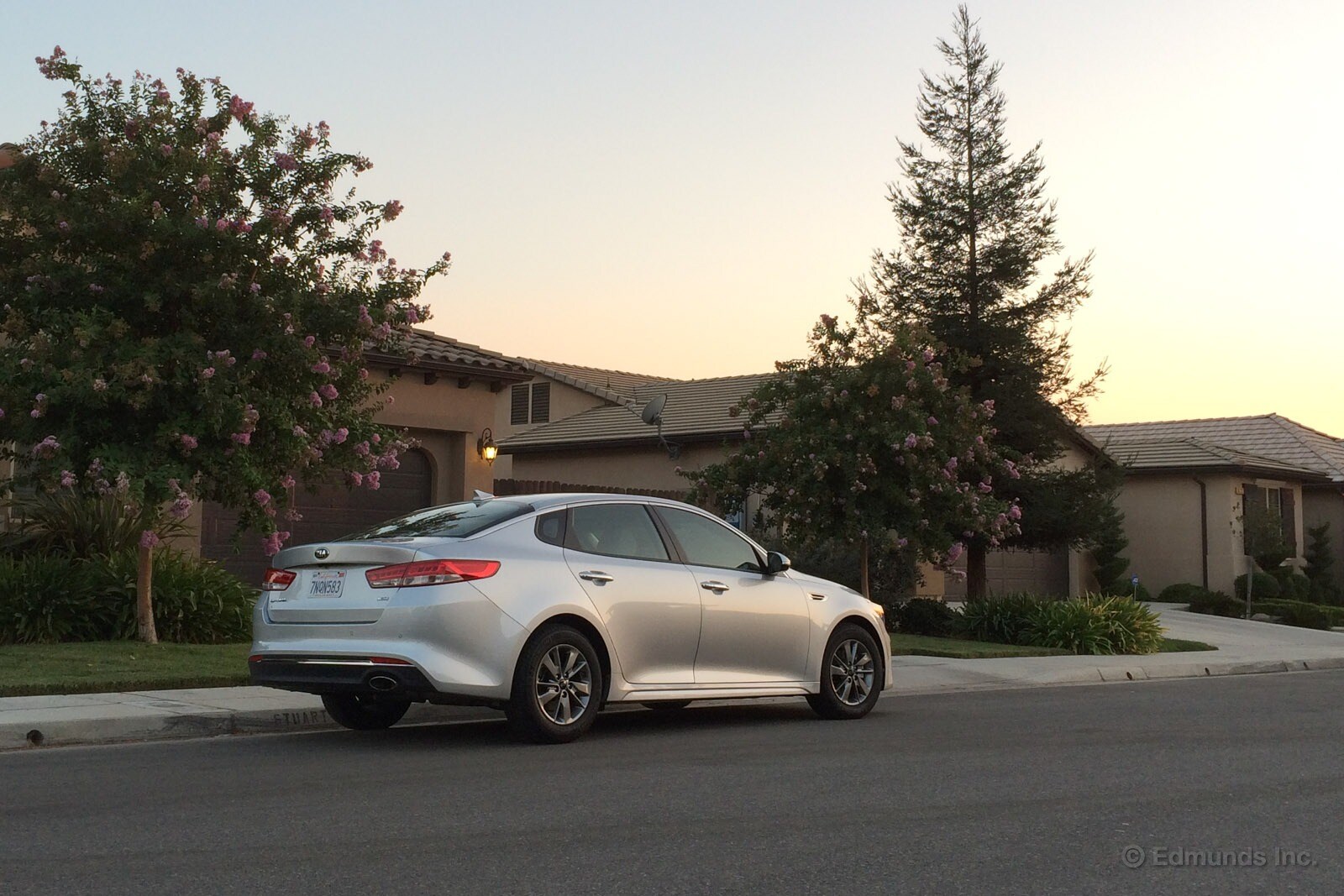
I was looking over our recent updates on our 2016 Kia Optima. There hasn't much much excitement going on. We've posted some fuel updates and written some further commentary about the powertrain. Cameron noted how he loses our car in parking lots. In other words, boring. But maybe "boring" is actually good news. If you want your midsize sedan to get you through your day with a minimum of fuss, our Optima is rocking it.
I've spent a lot of time with our Optima and just appreciate how it goes about its business in an impressively polished manner. For just about everything I'd actually want in a midsize sedan, the Optima's got it. It's easy to drive. The front seats are comfortable. It rides well over bumps and broken pavement. The back seat is roomy, as is the trunk. Fuel economy is solid (close to 30 mpg) from the car's turbocharged 1.6-liter engine, as is power when you need it. Safety? The Optima aces every single one of the NHTSA's and the IIHS' crash tests.
One could argue that this all sounds very appliance-like, a disparaging charge leveled at the Toyota Camry for decades. There's probably some truth to that. But we're also testing out an entry-level LX, not the SX with its more powerful engine, flashy 18-inch wheels and sport-tuned suspension. Kia sells the Optima LX 1.6T in eight colors, and four of them are a shade of gray.
Personally, I'm OK with boring. If I were shopping for an affordable midsize family sedan, the latest Optima would be right in the mix of cars I'd consider.
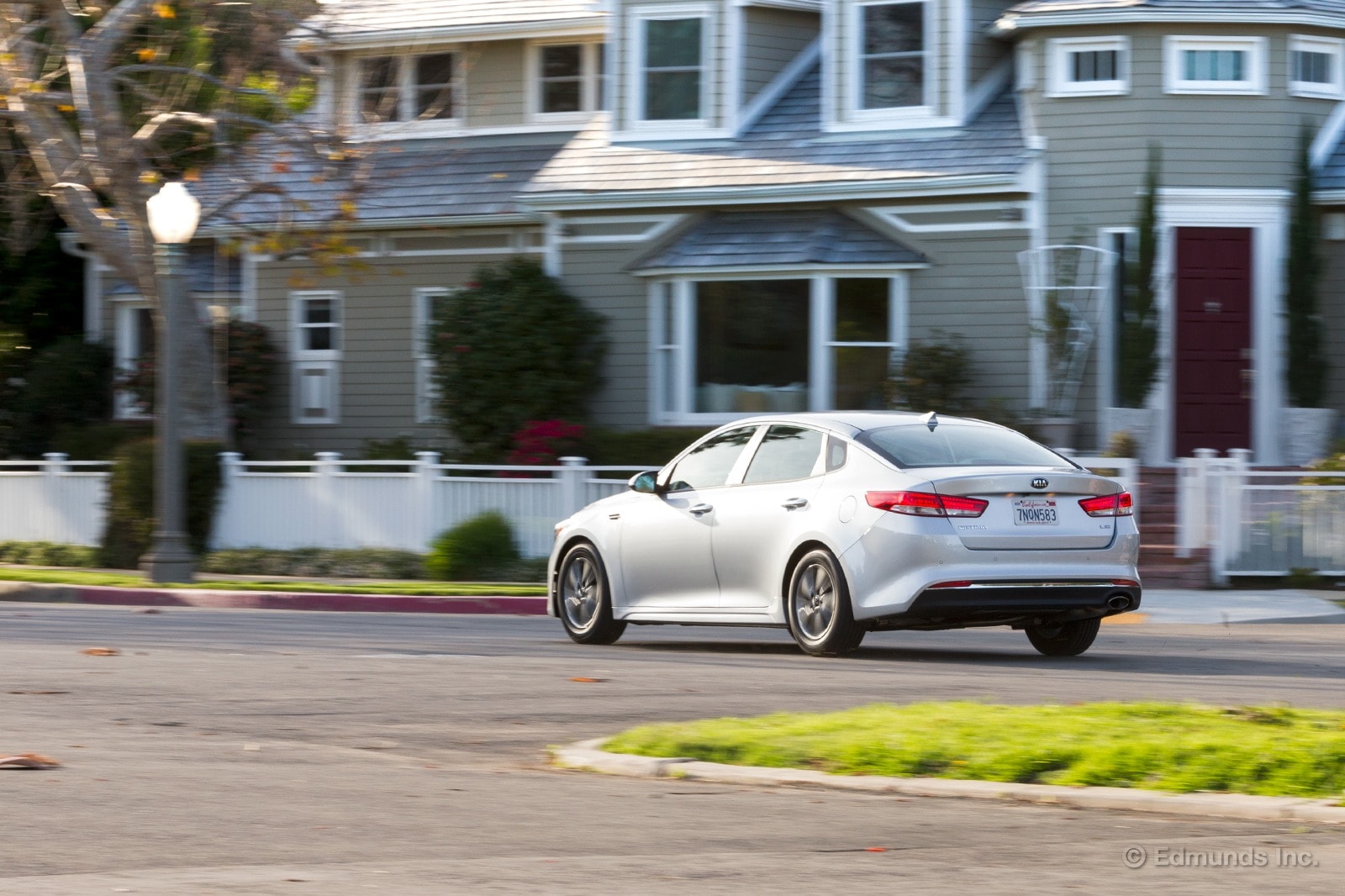
We're closing in on 10,000 miles in our long-term 2016 Kia Optima. While this is all well and good, there's one small problem: we forgot to take our Optima to a dealer for its first 7,500-mile service.
Oops. I've since called my local Kia dealer and we're all set for a service appointment a couple of days from now. But I've got a few possible explanations for our negligence:
1) The Optima's service reminder feature wasn't turned on. Either somebody on our team mistakenly turned it off or it was never activated to begin with. Excuse: the car didn't tell us, therefore it's not our fault.
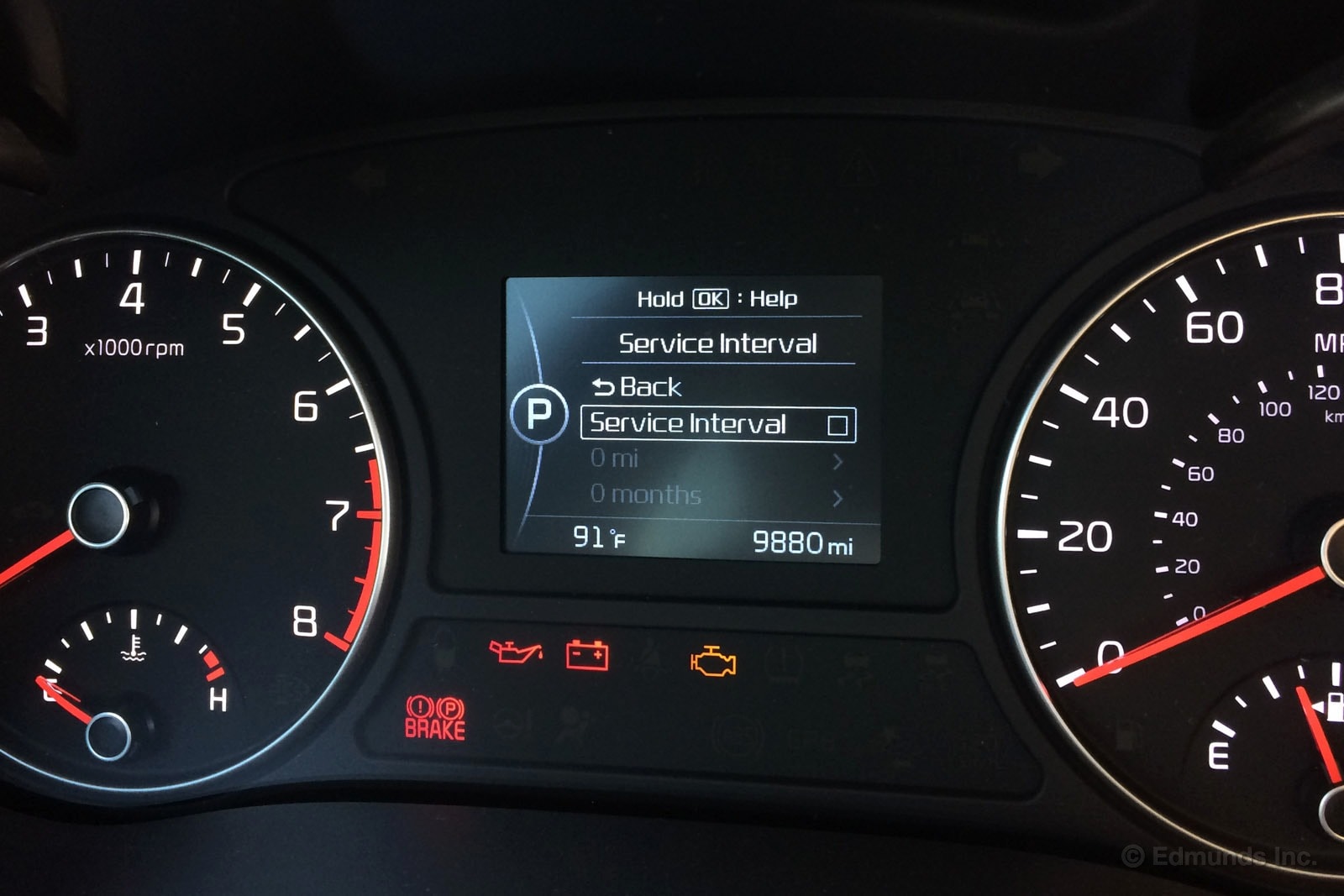
2) We have a summer intern, Cole. He's a great guy and very helpful. But this is the kind of thing that interns are for. Excuse: It's the intern's fault! He should have noticed we were past due for service.
3) The summer Olympics, presidential elections and Pokemon Go. Excuse: Who has time for remembering service intervals?
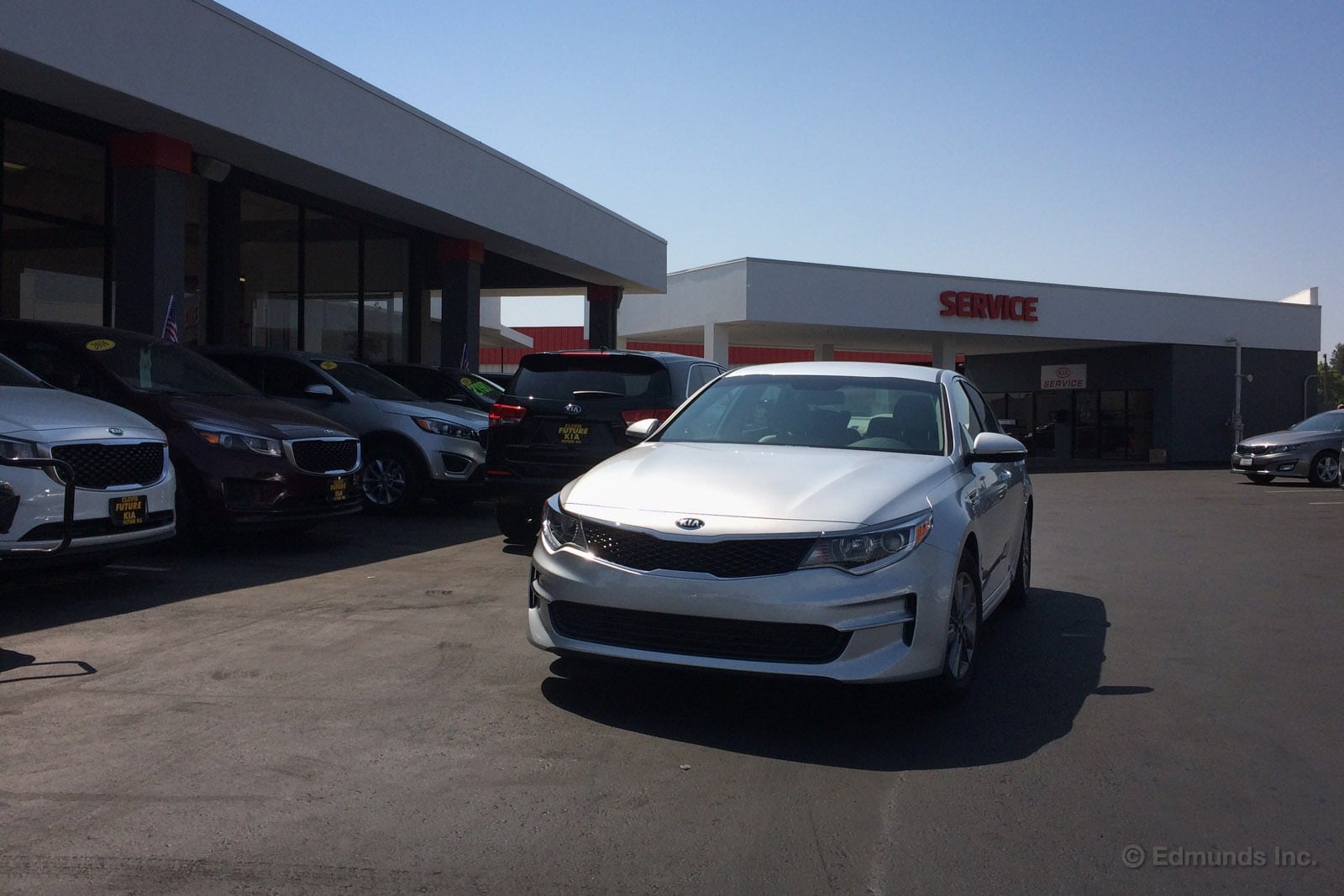
As I noted last week, we neglected to take our 2016 Kia Optima in for its first service at the prescribed 7,500-mile mark. But better late than never. I headed over to my local Kia dealer to get the oil change and tire rotation taken care of.
My service advisor, Kasey, at Future Kia promptly entered my information and got the service started. I hung around in the lounge and sipped on a caffe mocha from a rather fancy-pants automatic coffee machine. I didn't have to wait much more than an hour before she came in and told me the Optima was ready.
The total bill for the oil and filter change and tire rotation came to a very reasonable $45.49. After the appointment, I set our Optima's in-car service reminder function for 15,000 miles. That should get us back on schedule.
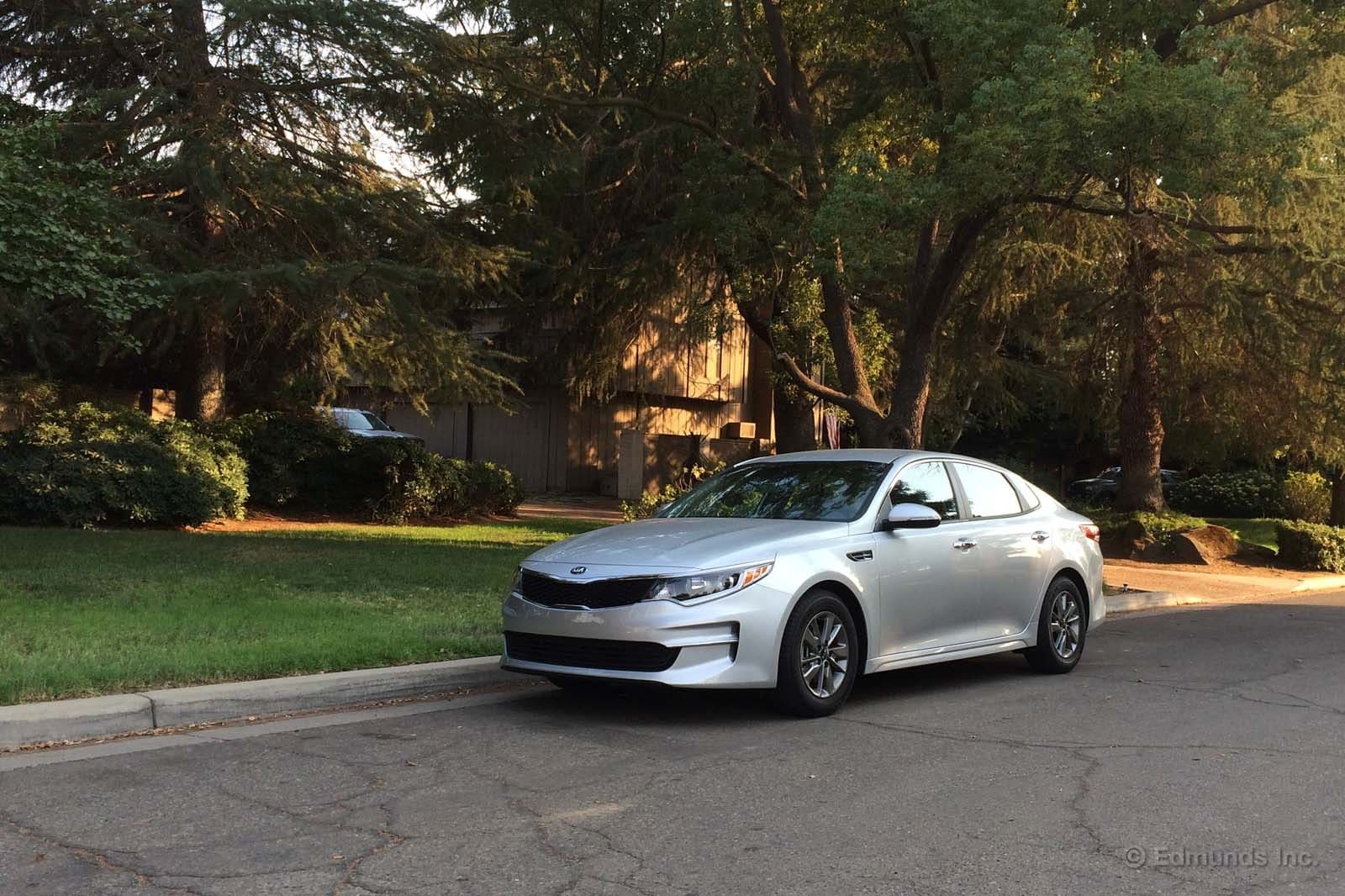
We've cleared the 10,000-mile mark in our long-term 2016 Kia Optima. We're close to being seven months into our year-long test, which means we've got a bit of catching up to do to reach our goal of 20,000 miles before we're done. A road trip or two would get us back on schedule. Thankfully, our Optima is certainly up to the task.
I've driven our Optima quite a bit and have always come away impressed with its road-going demeanor. It's roomy, very quiet at highway speeds and has a nicely tuned suspension that smooths out bumps and ruts but without being overly soft to the detriment of car control. And if you need a burst of speed for a highway pass, the Optima's turbocharged engine has enough grunt to make it happen without issue. I suspect our most notable complaints so far were summed up by Sadlier in a recent post: the lackluster character of the engine and the slow responses of the transmission at low speeds.
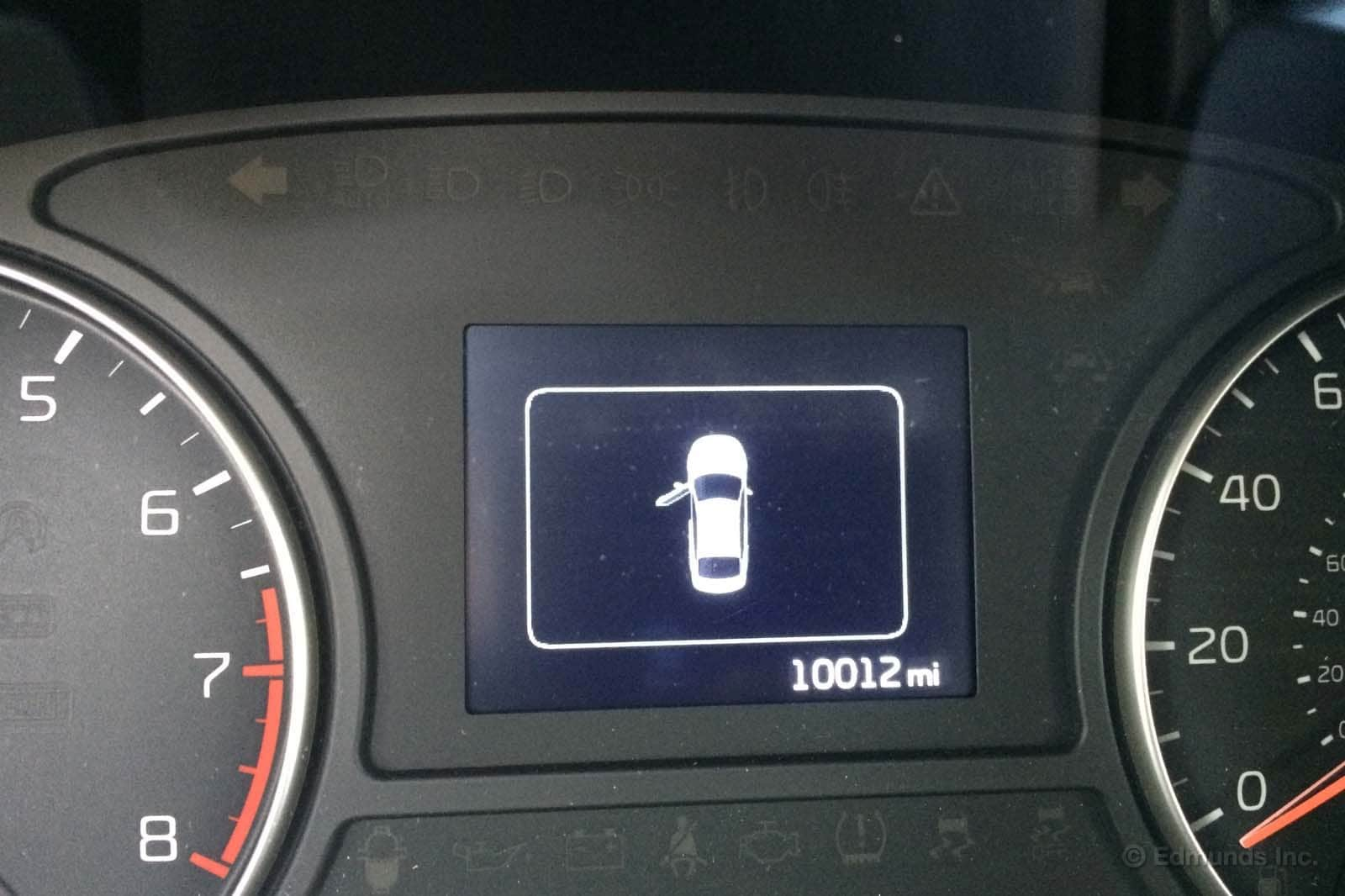
Our Optima has been essentially trouble-free. Other than the build-quality problem with the front seat fabric that we covered a few months ago, our maintenance category is crickets. Not that you'd expect anything to go wrong just 10,000 miles in, but it's nice to see nonetheless. Maybe there's something to that J.D. Power award after all.
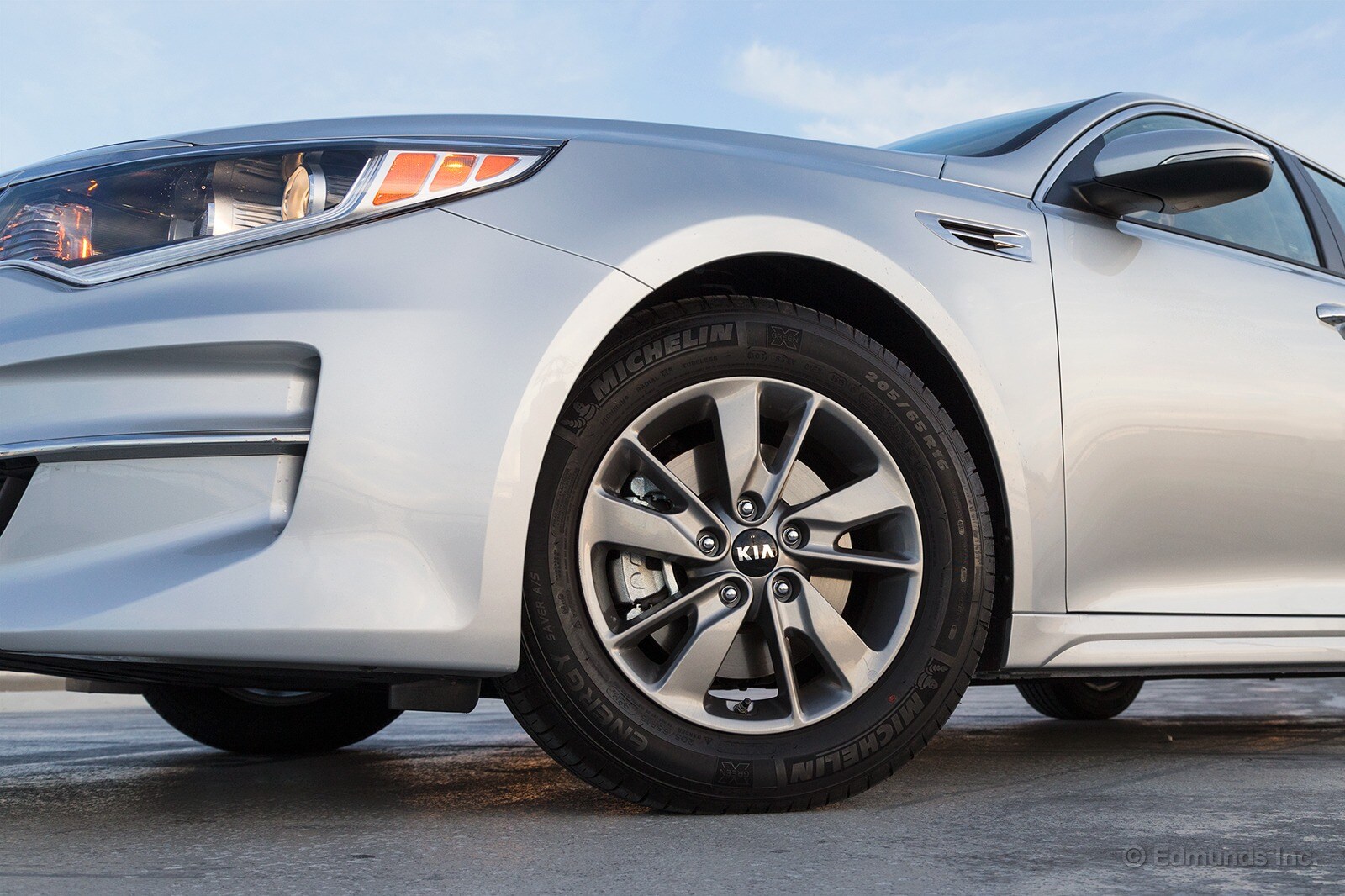
After a subpar July at the fuel pumps, our 2016 Kia Optima got its groove back in August. Overall, we're seeing pretty respectable fuel economy from this turbocharged family sedan, although it's still well short of the EPA combined estimate.
We added 1039.4 August miles to the odometer and pumped in 32.132 gallons for an average of 32.3 mpg, incrementally better than the EPA's projection of 32 mpg in mixed driving. Our man in the Central Valley helped the Optima's cause this month by driving it to Fresno and back, but there's a significant body of work by now, and it's not too shabby. EPA estimates notwithstanding, I'd say 29.7 mpg is quite laudable for a sizable sedan with peppy performance. Spirited acceleration certainly makes any MPG shortfall go down easier.
Average Lifetime MPG: 29.7
Best Fill MPG: 39.9
Worst Fill MPG: 22.6
EPA MPG Rating: 32 combined (28 city/39 highway)
Best Range: 574.7 miles
Current Odometer: 10,633
(NOTE: Cars are sometimes refueled well before their fuel tanks approach empty. As such, the "best" and "worst" entries above are not necessarily the result of an entire tank's worth of driving.)
Monthly Update for October 2016
Where Did We Drive It?
In October, we mostly drove our 2016 Kia Optima around town and on our daily commutes, with one significant exception — a round trip from California to Colorado that added more than 2,500 miles to the odometer. On that trip, Vehicle Testing Assistant Mike Massey got a good sense of what the Optima's all about. It's a car with great long-haul manners that, distilled into our typical short hauls, make the Optima a strong value and a smart daily driver.
What Kind of Fuel Economy Did It Get?
We drove the Optima 4,378 miles in October, averaging 31.0 mpg. Twice we covered 500 or more miles on a single tank, including an impressive 529.2-mile run, our second-best so far.
Average lifetime mpg: 30.0 mpg
EPA mpg rating: 31 mpg combined (28 city/37 highway)
Best fill mpg: 39.9 mpg
Best range: 574.7 miles
Current odometer: 15,547 miles
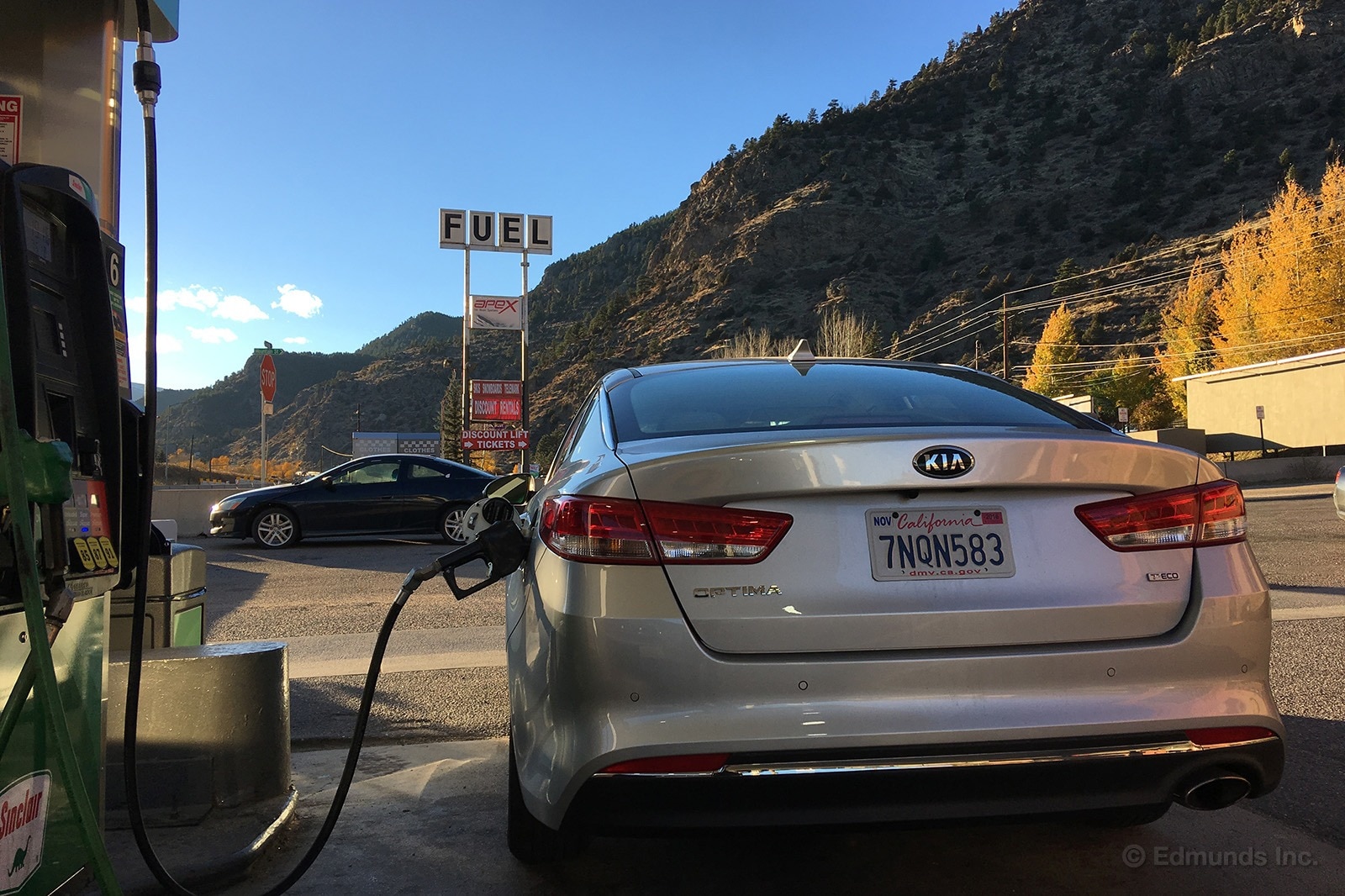
Maintenance and Upkeep
With 15,000 miles on the Optima's odometer, it was time for a routine oil change and tire rotation. It took less than an hour and cost less than 50 bucks, burnishing the Optima's credentials as a great value and an easy car to own.
Logbook Highlights
Performance
"I know many of my co-workers dislike our Kia Optima's slow responses when you first let off the brake from a stop. The Optima doesn't immediately start to creep forward like a car with a regular automatic transmission. The culprit seems to be 1.6T's dual-clutch automatic. It takes a couple beats to get going. While this trait can be annoying in certain situations, I've gotten used to it. It wouldn't stop me from buying an Optima." — Brent Romans, Senior Automotive Editor
Comfort
"The Optima's respectably quiet and has plenty of range. I can easily roll off hours of driving in it." — Brent Romans
"On my trek out to Colorado, I drove straight through the night — 1,100-plus miles and 16-ish hours, only stopping for gas and other obvious needs. Once my seat was adjusted properly, I found that I just wasn't getting fatigued. My legs never grew sore or went to sleep. My lower back had enough lumbar support." — Michael Massey, Vehicle Testing Assistant

Cargo Space
"The good aspects of our Optima's trunk: 1) There's plenty of room for your grocery bags, luggage or whatever. 2) The trunk has a hands-free operation mode; stand near the trunk with the key fob on your person and the car will beep three times and then automatically unlock the trunk.
The less-good aspects: 1) There's very little damping/hold effect for the trunklid. On more than one occasion, I've opened the trunk and stuck my head in to get something only to have the lid fall back down (or bounce back from full-open) and hit me in the back of the head. 2) I'm not sold on the hands-free feature. It'd be great if it actually opened the trunklid all the way, but instead it just pops it open. You still need a free hand to open it. You might as well just grab the manual release and lift the trunklid yourself, which is quicker than waiting for the automatic function." — Brent Romans

Maintenance
"Our Optima had about 15,000 miles on its odometer and that meant it was due for a scheduled service. I booked an appointment my local Kia dealership (Future Kia). I was in and out in less than hour, which is impressively quick for an oil change and tire rotation. The total bill was quite agreeable, too: $45.49." — Brent Romans
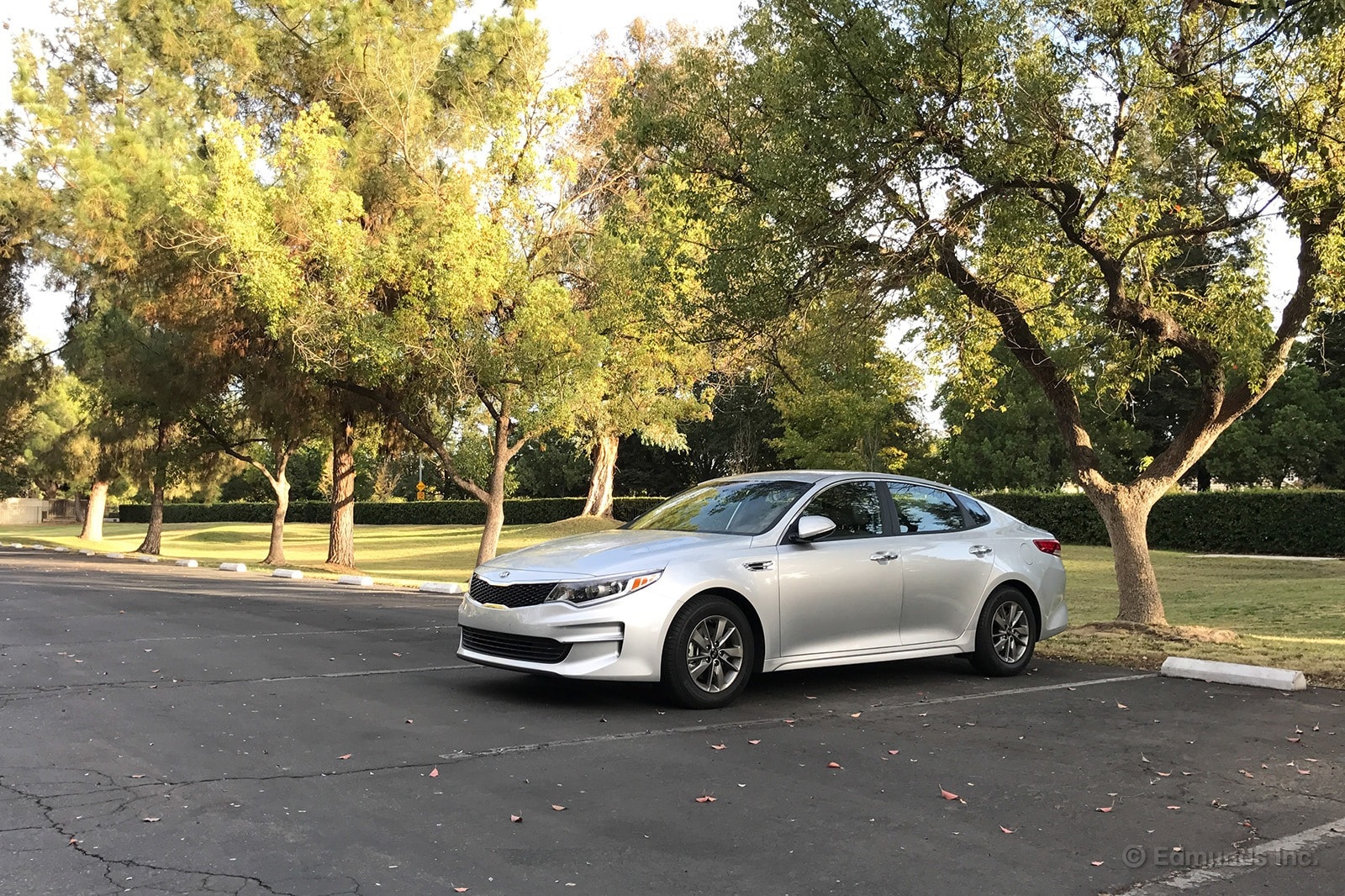
Monthly Update for November 2016
Where Did We Drive It?
November started quietly enough. Our 2016 Kia Optima passed from editor to editor, connecting the dots in a series of around-town errands, until BAM! In the middle of the month, Photo Editor Kurt Niebuhr and the Optima were en route to Edmunds HQ when the Kia was rear-ended.
Twice.
More on that below.
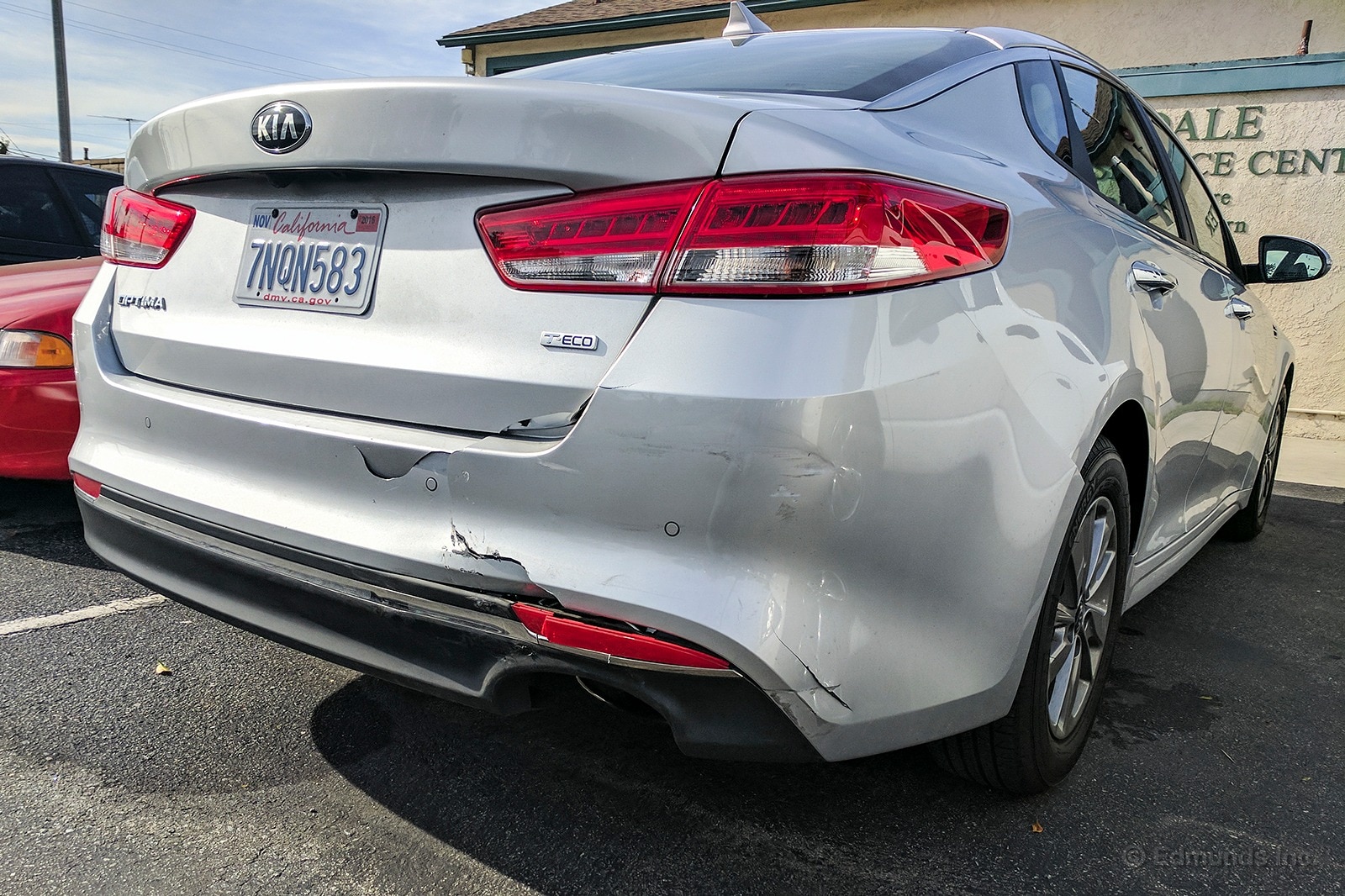
"It's bound to happen, right? I mean, you drive a few hundred thousand miles over nine years in press vehicles without an accident...and then you get in two. In the same day. One hour apart."
"No doubt the hit-and-run report I filled out at a CHP substation (thanks, guy in the black W204 Benz who backed DOWN the on-ramp and booked it after smacking the rear of our Optima like it insulted his vape pen) had yet to hit the 'who cares?' basket when I became the lead car in a four-car, chain-reaction accident on the 405 freeway."
"Perfect."

"Thankfully for our accountants and our insurance, the second smack was nothing compared to the first, and it was absorbed by the already mangled rear bumper. Still, I pulled over with everyone else, exchanged information, made sure everyone was all right (to my surprise, no one seemed the least bit concerned to have just been in an accident), and then got to work and the hell out of that car as fast as I could." — Kurt Niebuhr, Photo Editor

Maintenance and Upkeep
Due to Double Accident Day, our Kia Optima is currently in the body shop. The initial estimate was written at $3,500 for the significant rear-end damage. We'll post a separate update later with details of the repair.
Logbook Highlights
Performance
"The Kia Optima continues to be a comfortable and impressive sedan. I generally enjoy my time in this vehicle every time I'm in it. My one gripe is a hesitation in the throttle response when switching from the brake pedal to the gas pedal. It seems to hesitate and almost sputter, which makes for a slight annoyance in stop-and-go traffic." — Michael Massey, Vehicle Testing Assistant
Comfort
"I now call our Kia Optima 'old reliable.' And it's not because of its lack of problems over its short career in our fleet (although that's nice too). To me, it's reliably likable every time I drive it. It has a no-nonsense interior design, comfortable seats and solid performance. It's a well-executed midsize sedan that rarely gives you a reason to dislike it. Not a bad version of reliable in my book." — Ed Hellwig, Executive Editor
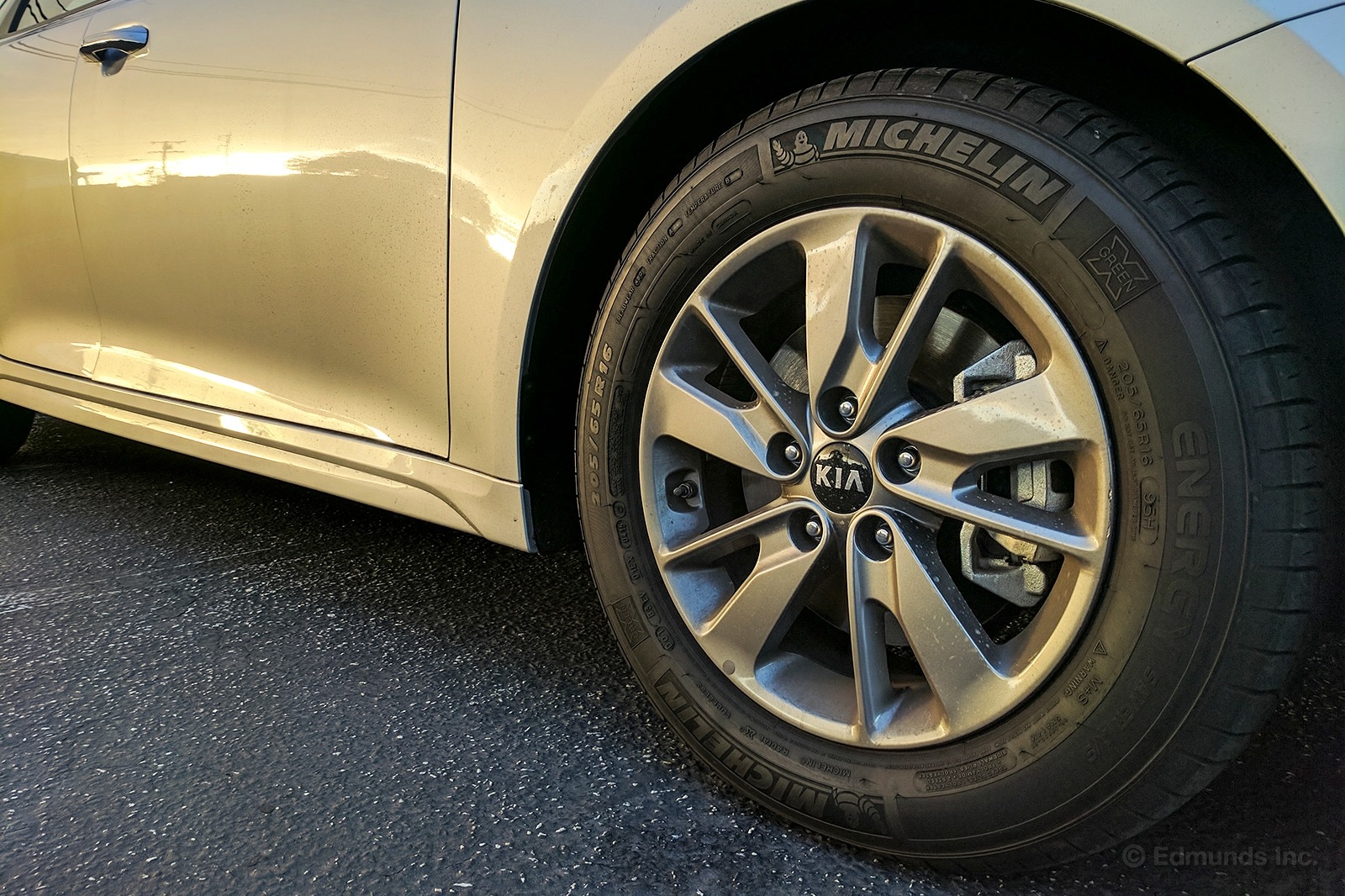
Monthly Update for December 2016
Where Did We Drive It?
Our 2016 Kia Optima spent a solid chunk of December at the body shop getting repaired from last month's double rear-ender. Thankfully, when we got it back, it was as good as new and put right back into service. Senior Consumer Advice Editor Matt Jones and I were the main Optima drivers for December. Matt drove the Kia on a road trip to visit family in the San Francisco area, while I battled Los Angeles traffic commuting and visiting friends and family over the New Year's holiday. Together, we were able to test the range of the car as well as some of the safety assistance systems.
What Kind of Fuel Economy Did It Get?
Although our Optima was sidelined for most of the month, we were still able to get a good sample size. We noticed wide swings of fuel use per tank (lowest reading at 23.9 mpg; highest reading at 33.3 mpg), even though we continue to achieve almost 30 mpg overall. We attribute that to driving on opposite ends of the spectrum — long miles on the highway and stop-and-go holiday traffic. All told, the Optima accrued an additional 1,309 miles on the odometer and used 44.2 gallons of fuel in the process, for a calculated average efficiency of 29.6 miles per gallon.
Average lifetime mpg: 30.0 mpg
EPA mpg rating: 31 mpg combined (28 city/37 highway)
Best fill mpg: 39.9 mpg
Best range: 574.7 miles
Current odometer: 18,147 miles
Maintenance and Upkeep
Aside from the aforementioned body repair, which totaled a rather stout $6,349.77, there were no other dealer visits in December. We did accomplish a little DIY upkeep, though, in the form of a software update for the infotainment system of our 2016 Kia Optima. As delivered, our Optima was not compatible with Apple CarPlay or the latest version of Android Auto. With this software update, we gained those smartphone integration systems plus a map data update thrown in for good measure.
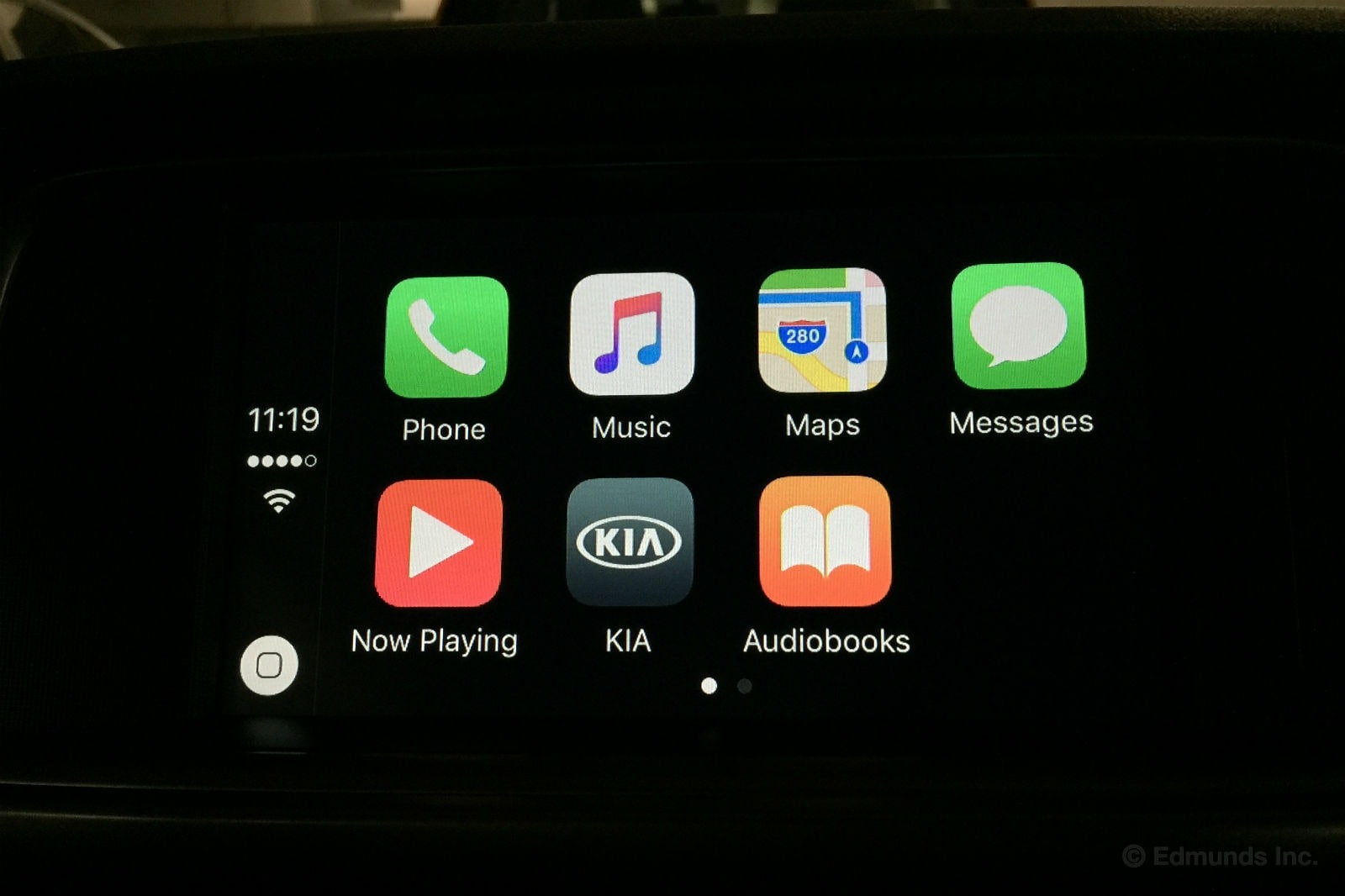
If you have a Uvo account, updating is easy and straightforward. Instead of going through the Uvo app on my smartphone (Kia has apps compatible with both iPhone and Android devices), I elected to download the update directly onto my laptop and run the update program, making sure the Optima's navigation SD card was inserted into my laptop during the process. Then, I took the SD card to the Optima, slid it back into its slot (to the right of the navigation screen), and ran the Optima's update routine. From that point, all you do is sit back in the comfortable cloth-upholstered seats, and let the software update routine handle the rest.
The only updating step that may cause minor confusion is that there are five separate modules that need to be updated, and there's at least one system reset where you could be mistaken into thinking everything is finished. But it's not, and you shouldn't touch the car until it's totally done. As the instructions state, you will have to keep the engine running for the duration of the update, so make sure it's someplace where idling for at least 30 minutes won't be frowned upon. Just give it time, let it go through all of its modules, and you'll have no problems.
Logbook Highlights
MPG
"On my overnight trip to the Bay Area, I squeezed 546 miles out of a single tank of fuel. According to the onboard trip computer, I averaged 35.0 miles per gallon. Why is this noteworthy? Because in the 20 years I've been making this drive, I've never gotten this type of range, in any vehicle. I filled up in Gilroy and had stops in San Francisco, Vallejo and Berkeley before finally making it down south to Long Beach. And I arrived home with 8 miles of range left to spare." — Matt Jones, Senior Consumer Advice Editor
Performance
"Fresh from the body shop, the Optima has no creaks or rattles and still feels tight. Yes, the drive-off hesitation that's been mentioned numerous times is still there, but as other editors have also noted, you do get used to it. On the plus side, the dual-clutch automatic gearbox makes up for the off-the-line sluggishness with crisp up- and downshifts in all other areas of the powerband, and the fuel economy you get from the little 1.6-liter engine is remarkable for a midsize sedan." — Calvin Kim, Road Test Editor
Hits the 20,000-Mile Mark and Gets Its Last Service
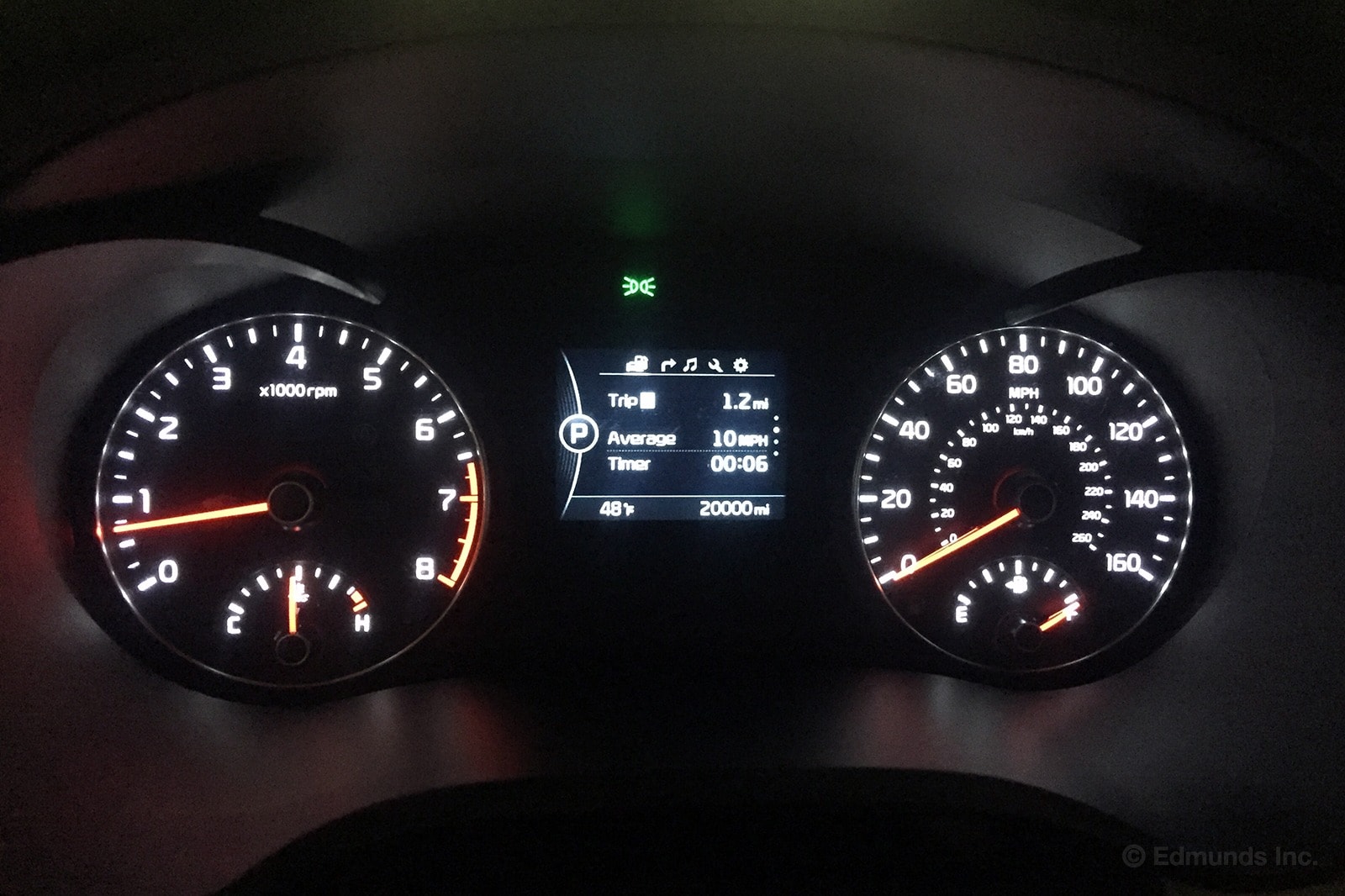
With a one-month absence as the result of a debilitating accident, it's amazing the 2016 Kia Optima was close to the 20,000-mile mark less than a week before it was set to return to Kia. Before I signed it out, Mike Schmidt, our test fleet manager, asked me to knock out a few hundred miles to tip it past the 20K goal we set for all long-term cars. "No sweat," I said.
I dropped the car back off at the office on the Tuesday after the long weekend with exactly 20,000 on the odometer and a service light in the instrument panel. Sure enough, the Optima was due for its final service. We needed to take it into a dealer quickly, so I called Kia of Cerritos (the nearest Kia dealer to my house) and made an appointment for 2:30 that afternoon.
I arrived at the dealer to find a completely packed service line. An adviser met me, led me to the service office and went over the scheduled maintenance. Just a quick oil change, tire rotation and inspections, plus a car wash. I was promised the car in two hours, a long time to wait for an easy service like this, but understandable given the number of customers.
The service was completed on time to the tune of $73.28. With that, we'll wrap this test up and send the car back to Kia.
Wrap-Up
What We Got
We decided to test a 2016 Kia Optima for one primary reason. Its 2011 redesign was such a dramatic success that we were curious whether the follow-up could continue the momentum. This time around, the exterior was essentially untouched, but the chassis, suspension and interior were new, as was a new turbocharged engine option.
In order to test the most new equipment, we skipped over the EX, SX and SXL trims and chose the LX to get the new 1.6-liter turbo four-cylinder engine. With our engine of choice, the LX 1.6T gets a seven-speed, dual-clutch automatic transmission, keyless entry, heated side mirrors and a leather-wrapped steering wheel. We added the $2,600 Technology package, which added navigation, parking sonar, blind-spot monitoring, dual-zone climate control and more. The total MSRP of our 2016 Kia Optima LX 1.6T was $27,545.
Midsize sedans get plenty of work when they're in our fleet and the Optima was no different. Here are some highlights from its year of service.
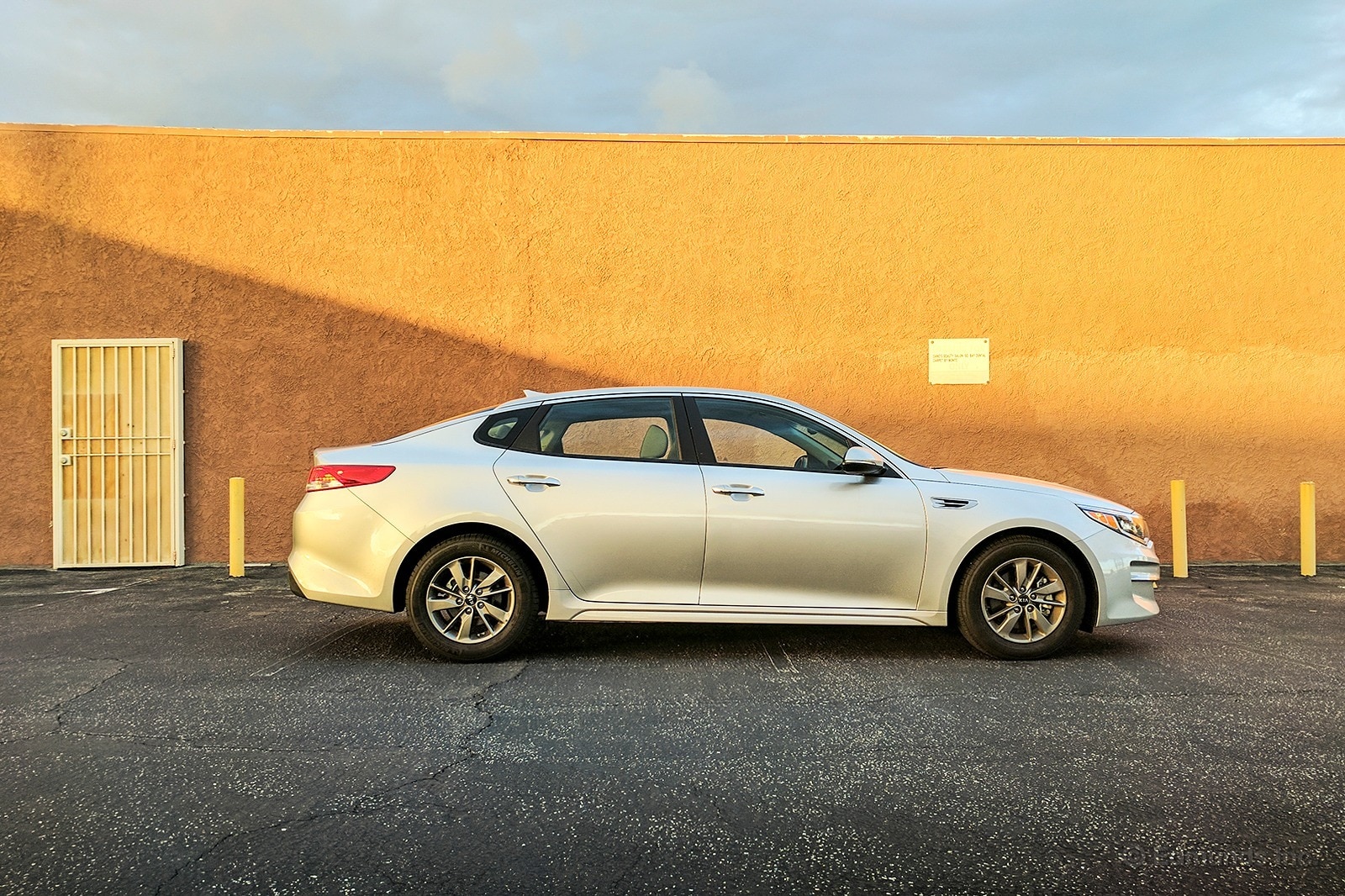
Performance
"I know many of my co-workers dislike our Kia Optima's slow responses when you first let off the brake from a stop. The Optima doesn't immediately start to creep forward like a car with a regular automatic transmission. The culprit seems to be 1.6T's dual-clutch automatic. It takes a couple beats to get going. While this trait can be annoying in certain situations, I've gotten used to it. It wouldn't stop me from buying an Optima." — Brent Romans, Senior Automotive Editor
"Let's start with the engine ... the thing emits an unrefined booming noise at higher rpm that makes it sound like a vacuum cleaner. ... Now for the transmission. It's an automated manual, which means a computer is doing the clutching. Whenever I parallel-park the Optima, I find myself wishing the in-gear 'creep' were more intuitive. Compared to a regular automatic, the computer needs an extra couple beats to engage and start creeping once you take your foot off the brake. Also, I find that the power comes on a bit unpredictably when it finally arrives, so it's hard to creep with precision." — Josh Sadlier, Content Strategist
MPG
"On my overnight trip to the Bay Area, I squeezed 546 miles out of a single tank of fuel. According to the onboard trip computer, I averaged 35.0 miles per gallon. Why is this noteworthy? Because in the 20 years I've been making this drive, I've never gotten this type of range, in any vehicle. I filled up in Gilroy and had stops in San Francisco, Vallejo and Berkeley before finally making it down south to Long Beach. And I arrived home with 8 miles of range left to spare." — Matt Jones, Senior Consumer Advice Editor
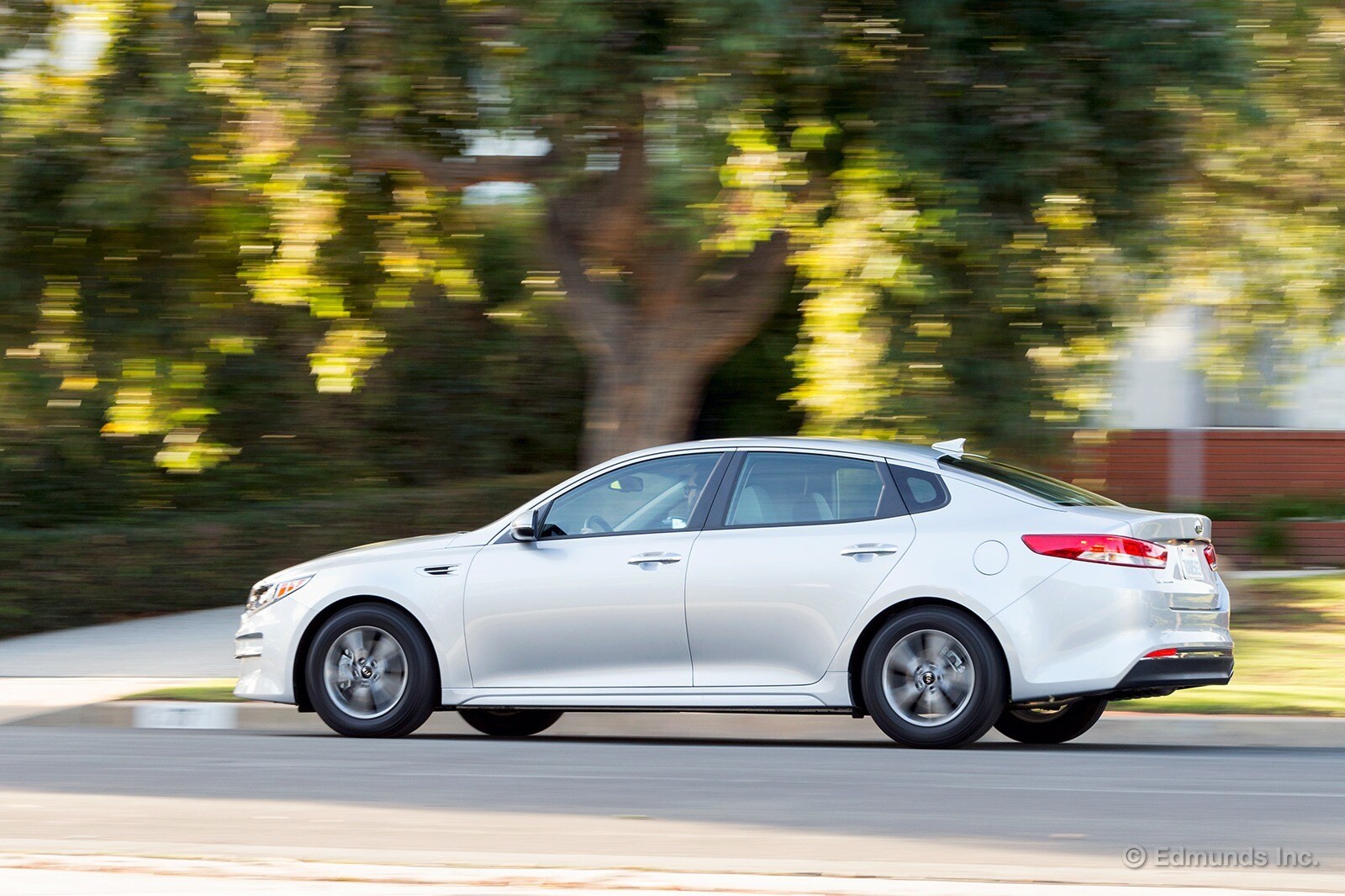
"The Optima's respectably quiet and has plenty of range. I can easily roll off hours of driving in it." — Brent Romans
Comfort
"It's quiet, smooth and glides over bumps. That's my subjective review of our long-term 2016 Kia Optima's suspension so far. ... The many potholes I encounter on my daily commute usually cause a lot of bouncing, almost regardless of the car. But this Optima seems pretty impervious. Small wheels and generous tire sidewall probably deserve part of the credit." — Travis Langness, Automotive Editor
"On my trek out to Colorado, I drove straight through the night for 1,100-plus miles and 16-ish hours, only stopping for gas and other needs. Once my seat was adjusted properly, I found that I just wasn't getting fatigued. My legs never grew sore or went to sleep. My lower back had enough lumbar support." — Michael Massey, Vehicle Testing Assistant
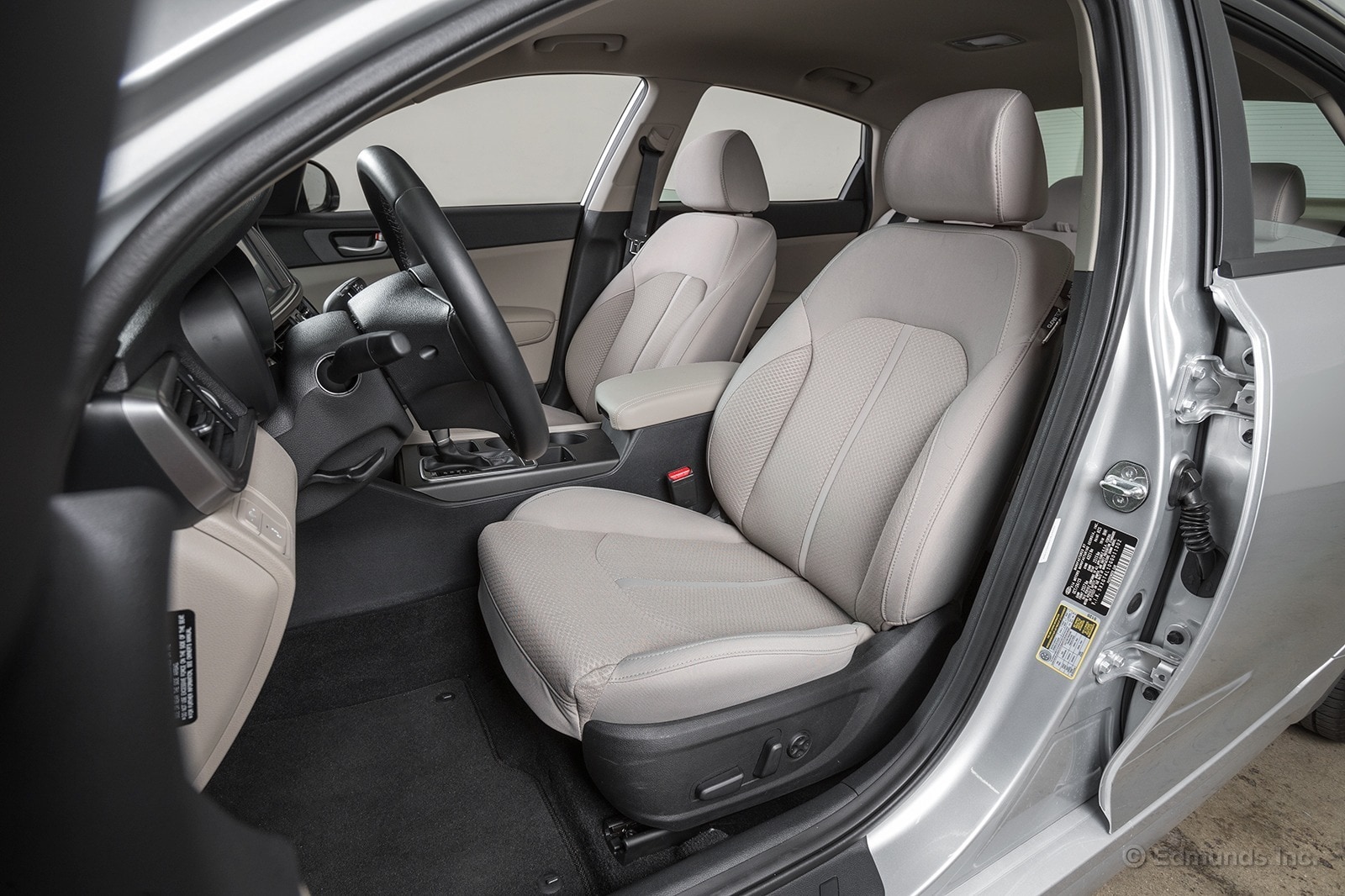
Cargo Space
"The shape of the trunk opening is common in this segment. It is plenty wide, but larger items require some manipulation to get inside. ... It is important to note the trunklid hinges. They lower into the storage space. As evidenced by the scuffs we have on the driver side hinge, they will crush cargo if you don't pack carefully." — Mike Schmidt, Senior Manager, Vehicle Testing
"Those rear seatback releases in the trunk are an added bonus, which means if you need to transport longer items, you won't need to climb into the rear seats to unlatch them. ... It's a good thing. But ... There is no latch inside the passenger compartment to fold the rear seats. ... Note to manufacturers: We like the trunk releases, but please keep the latches on the inside, too. OK, thanks, bye." — Mark Takahashi, Automotive Editor
Interior
"The upholstery in our more budget-minded Optima LX 1.6T doesn't make any pretensions to be leather, fake leather or even premium cloth. I actually kind of like it more because of it. Our current Optima's seat material is some kind of cloth/mesh hybrid that feels more like a good office chair ... a good standard for a car at this price. I'd take this material over the robo-reptilian stuff in our old (Optima) SX, and that car cost $3,000 more than this Optima." — Dan Frio, Automotive Editor
"There are a total of six places to power or charge electronic devices in a vehicle that seats five. Just below the center stack is a small covered tray with two 12-volt outlets and a USB port. There's also a charge-only USB port under the central armrest while backseat passengers get another 12-volt outlet and a charge-only USB port located on the back of the center console. ... Six outlets seem like overkill." — Cameron Rogers, Associate Editor
Audio and Technology
"As delivered, our Optima was not compatible with Apple CarPlay or the latest version of Android Auto. With a software update, we gained those smartphone integration systems plus a map data update thrown in for good measure." — Calvin Kim, Road Test Editor
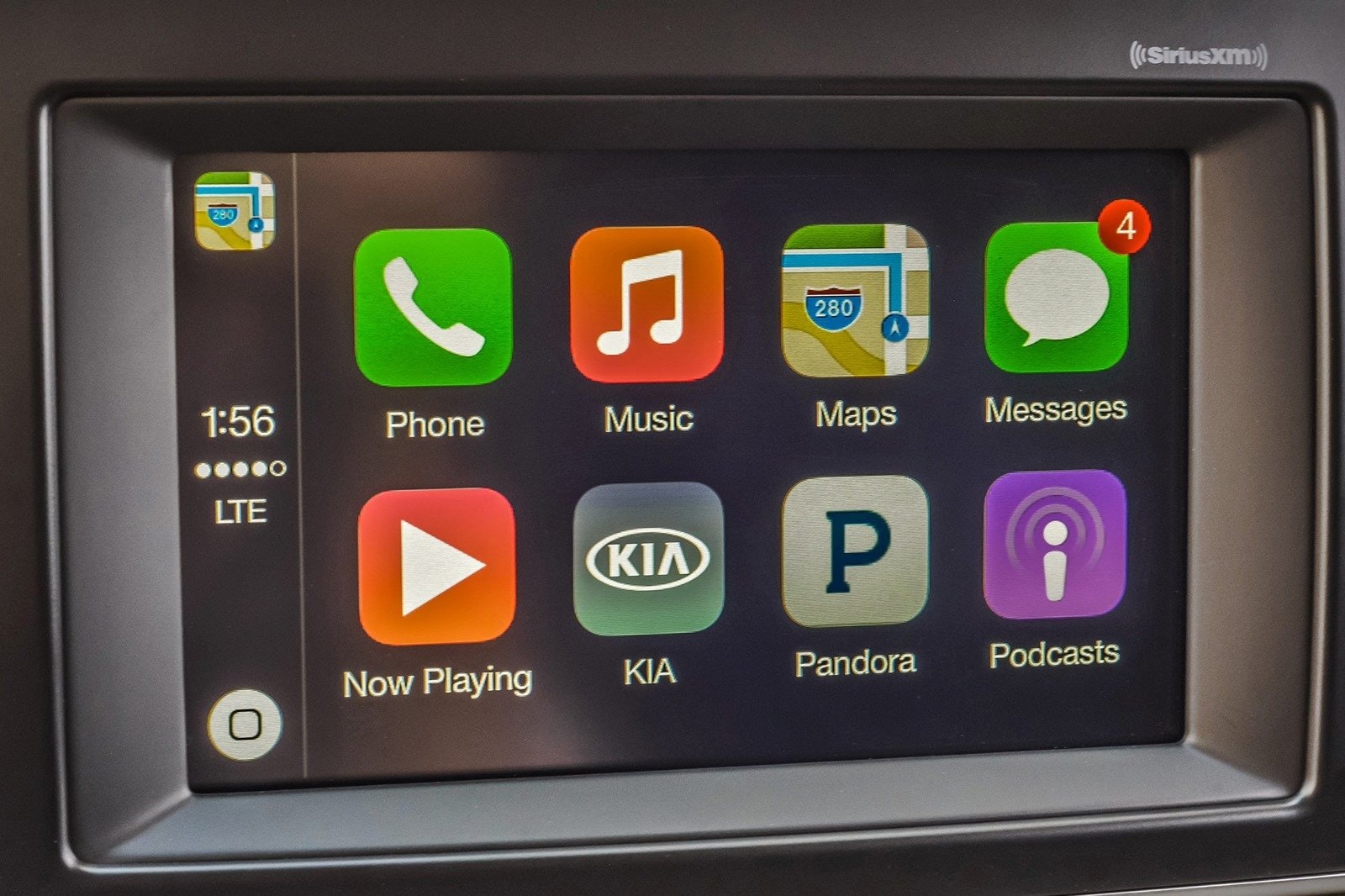
"This is the part of Uvo that allows you to create custom alerts for time, speed and location ('geo-fencing') if your Optima is being borrowed by your young driver. ... Once I sailed past the geo-fence distance, a notification popped on the touchscreen. And when I hit the gas on the highway a couple times to pass some slow-moving trucks, the Optima gave me a speed warning, too." — Brent Romans
Maintenance
"It's bound to happen, right? I mean, you drive a few hundred thousand miles over nine years in press vehicles without an accident ... and then you get in two. In the same day. One hour apart." — Kurt Niebuhr, Photo Editor
"Our Optima had about 15,000 miles on its odometer and that meant it was due for a scheduled service. I booked an appointment at my local Kia dealership. I was in and out in less than hour, which is impressively quick for an oil change and tire rotation. The total bill was quite agreeable, too: $45.49." — Brent Romans
Miscellaneous
"I now call our Kia Optima 'old reliable.' And it's not because of its lack of problems over its short career in our fleet (although that's nice too). To me, it's reliably likable every time I drive it. It has a no-nonsense interior design, comfortable seats and solid performance. It's a well-executed midsize sedan that rarely gives you a reason to dislike it. Not a bad version of reliable in my book." — Ed Hellwig, Executive Editor
"The Optima looks very plain, especially in silver. As I write this, I've been driving the Optima for the better part of three weeks. ... During that span I accidently attempted to enter a silver Hyundai Sonata one morning after I got coffee at a local Starbucks. On another occasion, we wasted a few minutes wandering the Costco parking lot as we tried to pick it out of the crowd. A few days later, I asked my mother to find the Optima in a mall parking lot. She correctly identified it, but not because it was distinctive. 'I knew the truck parked facing us was partially in our spot, so I figured our car was the one sticking out further than the rest,' she said." — Cameron Rogers
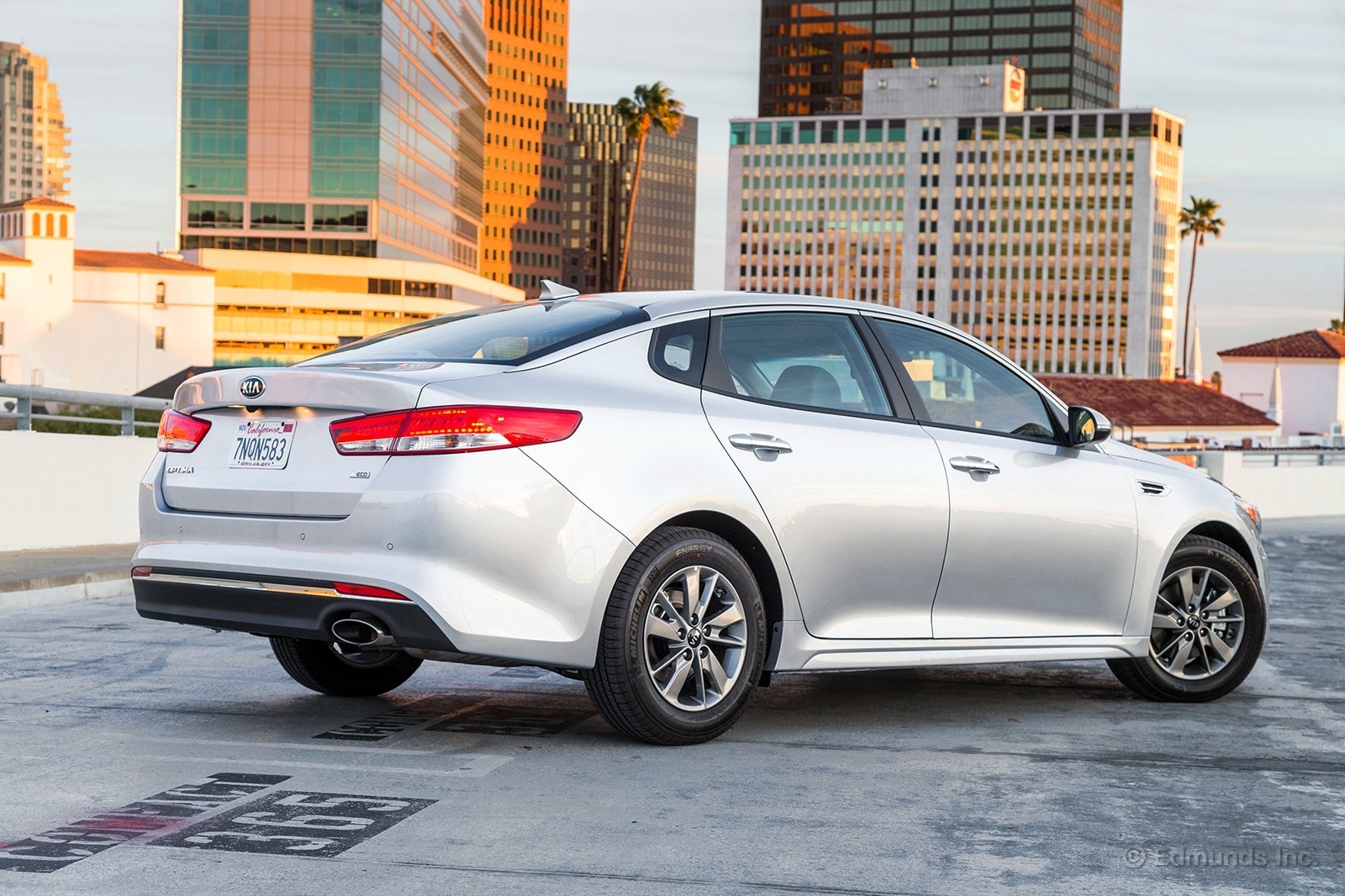
Maintenance & Repairs
Regular Maintenance:
The Optima requested routine service in 7,500-mile intervals. So we anticipated just two service visits during our 20,000-mile test. The first stop cost us $45 and the second $73. Each included oil changes, tire rotations and the usual assortment of inspections. Both experiences delivered acceptable levels of quality and convenience.
We did have one quality hiccup of note. The front edge of the seat bottoms for both front seats pulled out. We were able to tuck them back in, however.
Service Campaigns:
No recalls were issued during our test.
Fuel Economy and Resale Value
Observed Fuel Economy:
The EPA estimates 31 mpg (28 city/37 highway) for the Optima LX 1.6 Turbo. After 20,000 miles, we averaged 30.2 mpg. Our most fuel-efficient tank returned 39.9 mpg, and our best range on a single fill was 574 miles.
Resale and Depreciation:
Our Optima had an MSRP, including destination, of $27,545. After one year and 20,133 miles, the Edmunds TMV Calculator valued the sedan at $18,946 based on a private-party sale. This reflected 31 percent depreciation. For reference, our 2015 Hyundai Sonata depreciated 36 percent under similar circumstances.
Summing Up
Pros:
Straightforward cabin design makes everything easy to use at a glance. Cloth seats are surprisingly comfortable on long trips. Nearly matched its EPA fuel economy rating for mixed driving. Capable of more than 500 miles per tank. Plenty of power from the small turbocharged engine. Spacious rear seats and solid cargo room in the trunk. No significant problems over the first 20,000 miles.
Cons:
Dual-clutch automatic transmission feels hesitant in certain situations compared to a traditional automatic transmission. Trunk hinges intrude on the cargo space. No interior releases to fold the rear seatbacks.
Bottom Line:
If you're looking for a spacious and functional sedan that's capable of delivering long-range comfort and great mileage, the Optima LX 1.6T delivers. Its standard dual-clutch automatic transmission can feel clunky at times, but it's not a deal-breaker. This is a sedan worth considering if you like straightforward interior designs, a compliant ride and plenty of room for a reasonable price.
| Total Body Repair Costs: | $6,349 |
| Total Routine Maintenance Costs: | $118.77 (over 12 months) |
| Additional Maintenance Costs: | None |
| Warranty Repairs: | None |
| Non-Warranty Repairs: | None |
| Scheduled Dealer Visits: | 2 |
| Unscheduled Dealer Visits: | None |
| Days Out of Service: | 17 to repair body damage |
| Breakdowns Stranding Driver: | None |
| Best Fuel Economy: | 39.9 mpg |
| Worst Fuel Economy: | 22.6 mpg |
| Average Fuel Economy: | 30.2 mpg |
| Best Range: | 574 miles |
| True Market Value at service end: | $18,946 (private-party sale) |
| Depreciation: | $8,599 (31% of original MSRP) |
| Final Odometer Reading: | 20,133 miles |
Disclaimer:
The manufacturer provided Edmunds this vehicle for the purposes of evaluation.